VOLUME
ISSUE 14
Service
This ISSUE presents ways in which artists, writers, and scholars reimagine and broaden the idea of service. Ultimately, the aim is not to resolve the inherent ambivalence of service but to illuminate it.

ISSUE 14
2025
Service
ISSN : 2315-4802
e-ISSN : 3041-0924
Introduction
Exhibition
Essays
Conversation
Contributors’ Bios
Introduction
Introduction: Ambivalent Service
Exhibition
Beyond Service: Reimagining Care, Autonomy, and Exchange in Artistic Projects
Essays
Divine Inspiration: The Art of Service
Service—“Don’t Teach Art”
Conversation
Chiang Mai: Service and relationality in art practice
Contributors’ Bios
Contributors’ Bios
Introduction
Editor
Venka Purushothaman
Associate Editor
Susie Wong
Copy editor
Weixin Quek Chong
Advisor
Milenko Prvački
Editorial Board
Asst Professor. Felipe Cervera, Theatre and Performance Studies, University of California Los Angeles
Professor Patrick Flores, University of the Philippines
Dr. Peter Hill, Artist and Honorary Enterprise Professor at the Victorian College of the Arts, Melbourne
Professor Janis Jefferies, Goldsmiths, University of London, UK
Dr. Charles Merewether, Art Historian, Independent Researcher, Curator and Scholar
Editorial and Publication Support Team
Dr Malar Nadeson, Dr. Darren Moore, Sureni Salgadoe
Contributors
Tamares Goh
Irfan Hošić
Denise Jambore
Dev Nath Pathak
Ute Meta Bauer and Ng Mei Jia
The editors and editorial board thank all reviewers for their thoughtful and helpful comments and feedback to the contributors.
Introduction
Introduction: Ambivalent Service
In recent years, scholarly and practical attention to service has expanded far beyond traditional confines to social welfare and public administration. As both an analytic enquiry and lived practice, the idea of service today challenges us to interrogate the underlying presumptions of our commitment to one another, whether as citizens, consumers, professionals, or creative practitioners. Service as a field of inquiry is fertile, not least because of global disruptions that have laid bare the manifold ways service sustains and fragments societies as a complex nexus of ethics, emotion, infrastructure, and power.
At its most fundamental level, service connotes helping or being present. To serve is to engage in selfless action, to sacrifice—or at least defer—one’s needs to those in need. As a humanitarian ideal, service expresses empathy, respect, and care. Yet service, beyond this primal ideal, is situated within broader complex social, political, and economic systems that nurture and confine it.
To unravel the complexity of service, it is helpful to distinguish between two interrelated dimensions: affect and effect. ‘Affect’ refers to the emotional, embodied presence that service providers bring to their work. Be it the empathetic gaze of a nurse, the listening ear of a teacher, or the committed labour of volunteers, these gestural utterances presuppose care and imprint themselves on both giver and receiver, generating human connectivity, providing a sense of security and safety. The affective dimension underscores service as an enactment of shared humanity, where personal vulnerability and professional discipline converge.
Yet service also possesses an ‘effect’: an instrumentalised role in governance and economic systems, inseparable from hard and soft infrastructures. Hard infrastructure comprises the tangible structures and facilities, such as schools, hospitals, and transport systems, that scaffold public service delivery. Soft infrastructure, conversely, encompasses the policies, norms, and bureaucratic procedures that determine and govern who benefits from the rendered service and under what kinds of conditions and expectations. It becomes a tool of governmentality as to how one is governed and who governs.
In contemporary societies, the oscillation between affect and effect highlights equity, agency and upliftment concerns. Global and local conditions may inform who benefits, thereby underscoring the transactionalised nature of service in everyday life, blurring the line between humanitarian service and public service. Against this backdrop, it becomes imperative to reconsider the ways in which service might be reimagined or reclaimed.
One fertile site for such inquiry is the arts. In the twentieth century, arts institutions and practitioners increasingly articulated their work in terms of service to communities, whether through participatory theatre, public art commissions, community music projects, or socially engaged design. This turn recognised the arts as both objects of aesthetic appreciation and as agents of social cohesion, critical reflection, and collective empowerment.
But there is a tension. While artistic practices can amplify and provide space for marginalised voices, foster intercultural dialogue, and catalyse civic participation, their aesthetic and creative dimensions can also be instrumentalised for urban redevelopment and gentrification agendas, tourism strategies, corporate sponsorships, or assuaging political tensions.
This ISSUE presents ways in which artists, writers, and scholars reimagine and broaden the idea of service. Ultimately, the aim is not to resolve the inherent ambivalence of service but to illuminate it.
Exhibition
Beyond Service: Reimagining Care, Autonomy, and Exchange in Artistic Projects
Service, in its early usage, denoted an unequal power structure, derived from the Latin servitium, meaning “slavery” and implying subjugation. In Hegel’s Master-Slave dialectic, the two exist in mutual dependence, yet the slave’s autonomy is denied by the master.1 The term has, over time, taken on a more constructive meaning, though not without its fallacies and conundrums. This is evident in the canon of associated fields and institutions, from healthcare services and social work to hospitality, and, more recently, ecosystem services. For the latter, it operates as a method of quantification, assigning monetary value to the essential contributions and benefits of natural environments to human well-being, quality of life, and survival—one of the many methods deemed unavoidable to justify the existence of the more-than-human in an economy that prioritises profit maximisation. Power thus shapes spaces and people; even as epochs shift, service provisions continue to operate within a capitalistic model, extending conditions rooted in colonial histories. Yet in the spirit of resistance, artists and cultural producers strive to be autonomous agents, in no one’s service—as philosopher Antonio Gramsci would posit them—organic intellectuals, crucial in challenging prevailing hegemonies and shaping the cultural landscape.2
Human and more-than-human species do not exist in isolation. Despite fraught ways of living and being that encourage individualistic behaviours and reinforce power imbalances, we live a shared life—dense and plural in experiences—and cope together in structures of society and in a natural environment.3 This is a basic fact of existence. Yet, service within this line of thought should not be construed as fundamentally altruistic. Political theorist Emma Saunders-Hastings argues that the promotion of humanitarian efforts or the pursuit of one’s conception of good risks being paternalistic, and that is not necessarily grounded in the social and political relations that foreground reciprocity, trust, and respect for all autonomous agents.4 By way of illustration, within the structure of the present-day healthcare system, patients are addressed first and foremost as customers.5 “How can I help you today?”—a question all too familiar, relatable, shifts the responsibility of care back to the patient, who must first decide if they are unwell and locate physiologically where they experientially feel ill. It is thus compelling to begin thinking with and through posthuman thinkers such as Donna Haraway6, Anna Tsing7, María Puig de la Bellacasa8, and many others, in distributing agency and decentering the human subject, to enact an ethics (of care) not in a formulaic way that reinforces individualisation and monocultural thinking, but by building towards an orchestra of diversity, drawing from collective affairs to the personal entanglements and collaboration of all living things and species in the practice of everyday mutual care. In dismantling power hierarchies and thinking through relationships, transforming service from a world shaped by economics into one that “takes care of one another” becomes a process of reinstating autonomy, voice, and knowledge for the inequitable, the silenced, and the marginalised. Such a shift reverses the power dynamic, in which today’s so-called service providers—still entrenched in old paternalistic ways—can be epistemically transformed. This would foster a sense of cultural openness, encourage dialogical happenings, to imagine and construct alternative sets of beliefs, values and motivations and model new ways of being together in a world.
Artistic practices, without superimposing on art or cultural production as a social good, have long been versed in and attuned to making critical interventions or responses spurred by their particular surroundings. Resources obtained from increasingly privatised cultural and academic institutions, through commissioned works or other means, are utilised or distributed to artists’ interlocutors to build the foundation for a sustainable mode of working and living. The complex networks of exchange threaded by artistic operations, which cut across the different modalities of service, enable the amplification of rising concerns, realising the potential these efforts can effectuate beyond an individual. It follows the logical flow that shared responsibility can galvanise and translate into agency. Ranging across spatial dimensions—from land to sea—to the social dimensions of education and mutual aid alliances and structures, this issue expands the discussion through the proposal of keywords: community, collectivity, exchange, guardianship, ownership, accountability, and advocacy. An initial conception from the Diriyah Contemporary Art Biennale 2024, After Rain, the introduction of the keywords allows for a rethinking of the language that engenders a constellation of care beyond service, an approach Spanish philosopher Paul B. Preciado considers critical in acting as a solvent for normative frameworks. This issue profiles artistic practices to unfold what constitutes a sustainable provision of care, highlighting the crucial role artists and their works play in speaking to and with those who feel unseen, overlooked, or displaced, as well as to their communities, in fostering a critical collective consciousness in society.
Collectivity
In an era of turbulent times—when violence, both slow and immediate, subtle and physical, persists; when information communicated through the digital realm becomes overwhelming, causing desensitisation or perplexity in the face of inaction—the informal organisation of enduring resistance, framed as a basis for cooperation, mutual support and solidarity, foregrounds a shared emotional labour in navigating and standing firm against the dominant systems that contribute to festering planetary degradation. Coming together, and the act of doing things together—whether through shared experiences of festivities, celebrations, ceremonies, or the often-overlooked everyday act of sharing food and time in communal settings—are experiences that connect us with one another and engenders encounters that transform ordinary gestures into acts of care and quiet defiance. Such gatherings can activate passive networks into more permanent active ones, forming social relations nourished by trust, a shared identity and the commitment to collective well-being. Resource sharing and creative solutions are mobilised to regain the commons. As an affective practice, the communal sharing of food, for instance, nurtures bond, preserves memory, and foster possibilities for mutual sustenance and reflection.
BRITTO ARTS TRUST
Palan & Pakghor (The Kitchen Garden & The Social Kitchen), 2024
Defined by the structures of Bengali palan and pakghor, the palan is a traditional kitchen garden, often tended by women and children, which supplies the pakghor, a family kitchen akin to a living room. Developed for and during documenta fifteen, Britto’s pakghor served food and gathered people of various nationalities residing in Kassel. They prepared meals, shared their histories and memories, and hosted events that presented food cultures of 100 nationalities over the course of 100 days. A further iteration of the project took shape at the 2024 Diriyah Contemporary Art Biennale, where the palan grew vegetables and culinary herbs supplied by Alzahrani Farm in Diriyah, while the pakghor was activated by volunteers from across Riyadh. Centred on cooking traditions, the social space offered stories and moments for reflection on cultural identity and difference in a rapidly changing urban environment.
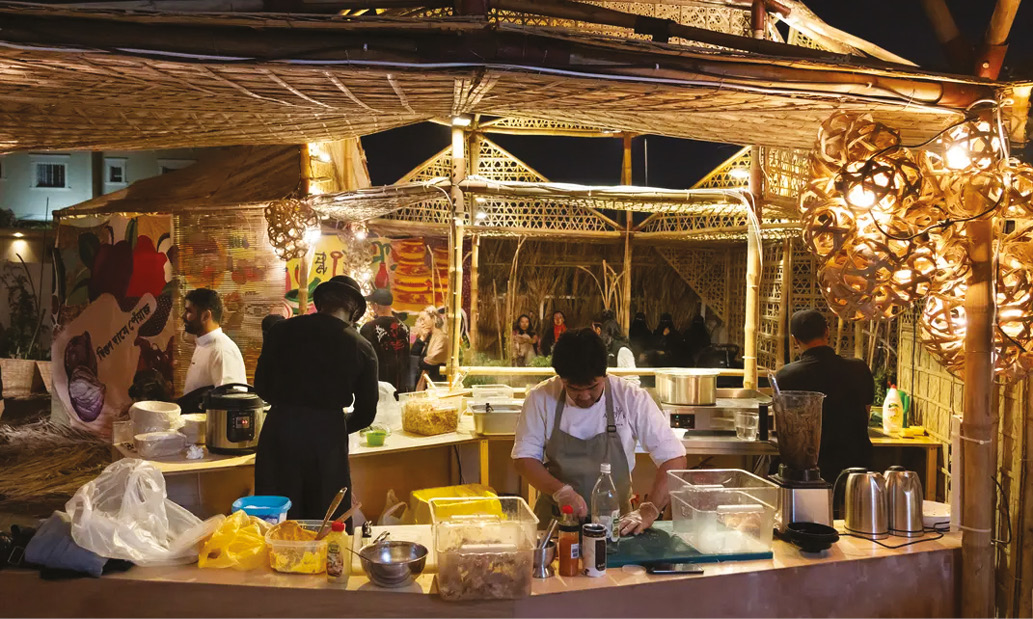
Palan & Pakghor (The Kitchen Garden & The Social Kitchen), social space for cooking and gathering, 2024.
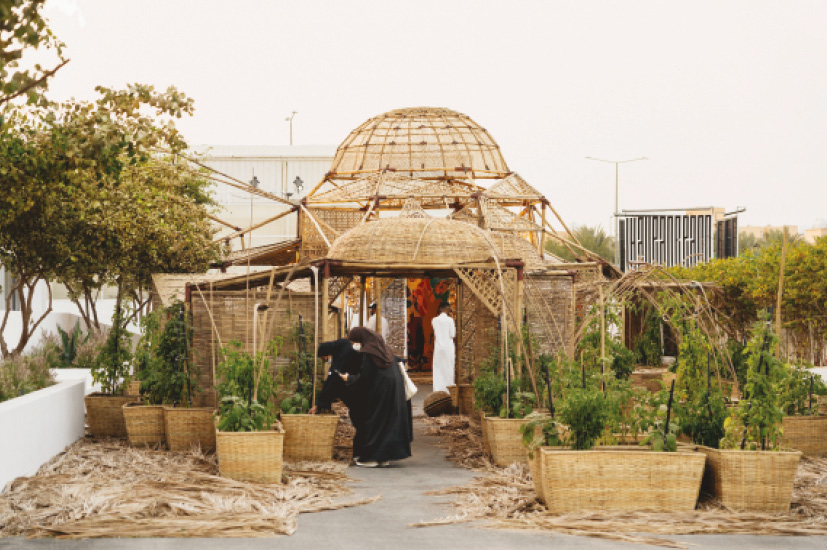
Britto Arts Trust, Palan & Pakghor (The Kitchen Garden & The Social Kitchen), 2024, installation view at After Rain, Diriyah Contemporary Art Biennale. Photo by Marco Cappelletti. Courtesy of the Diriyah Biennale Foundation.

Britto Arts Trust, Palan & Pakghor (The Kitchen Garden & The Social Kitchen), 2024, installation view at After Rain, Diriyah Contemporary Art Biennale. Photo by Marco Cappelletti. Courtesy of the Diriyah Biennale Foundation.

Pakghor design-development phase, Studio Mahbub & Lipi, Hasnabad, Dhaka, Bangladesh, 2023. Britto Arts Trust. Palan & Pakghor (The Kitchen Garden & The Social Kitchen), 2024.
Top: Local artisan making the dome of the pakghor (family kitchen), Manikganj, Bangladesh, 2023.
Bottom: Handcrafted bamboo baskets and objects woven by the artisans of Manikganj. Britto Arts Trust. Palan & Pakghor (The Kitchen Garden & The Social Kitchen), 2024.

Construction collaboration with the community to design and build a library / conflict resolution space. Alexander Eriksson Furunes & Sudarshan Khadka. Structures of Mutual Support, 2022. Courtesy of the artists.
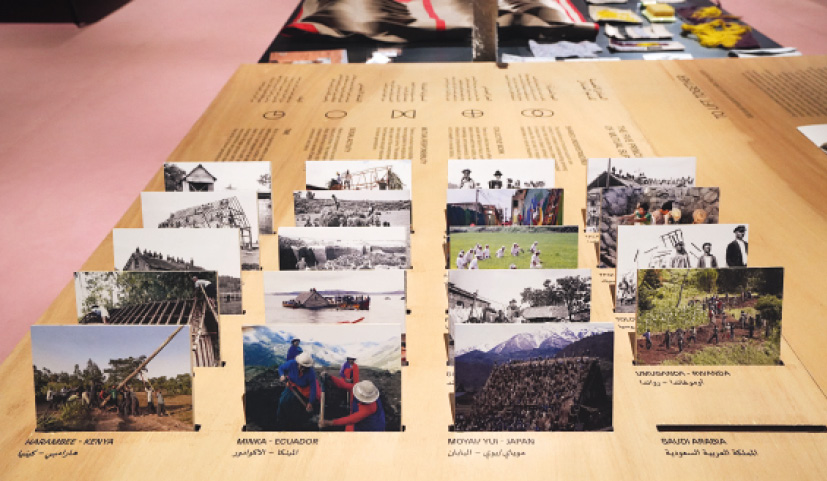
To Lift Together: Mutual Support and Collective Action, research material on display at the research room. Alexander Eriksson Furunes & Sudarshan Khadka. Structures of Mutual Support, 2022. Diriyah Contemporary Art Biennale, 2024.
Community
The historical shift towards a civilisation of hyper-individuals, who cooperate only when it serves their private interests rather than functioning as a single organism, alludes to how we have all lost touch with one another. Social relationships, from the initiation of casual small talk to formalised occasions, have withered, no longer grounded in connection, but accrued for self-preservation. What, then, is the foundation of a community that can offer a sense of belonging? The communal spirit in this thought path considers communal decision-making and benefits-sharing, through open interaction and transparency, as vital. Individuals can participate and add value to their communities, and to society at large, based on attributes shaped by their knowledge, skills, and experience. Such participation builds towards a degree of cooperativeness and minimises alienation. Members of communities offer “services” to one another, creating a balanced network of interdependence and instituting a more holistic social system. Beyond an individual, can the communal also refer to all life forms? How might we imagine ways of working where all forms of life belong to a diverse commune?
ALEXANDER ERIKSSON FURUNES AND SUDARSHAN KHADKA
Structures of Mutual Support, 2021
An example of architecture as process, the project was initially developed as a collective effort in collaboration with the Gawad Kalinga (GK) Enchanted Farm community in Angat, Bulacan, the Philippines. Rooted in a dialogical approach to community building, it responds to the urgent question “How will we live together?”, a question posed against a backdrop of development models that prioritise market growth and productivity. The project seeks to foster a democratic space where diverse perspectives can be shared and considered collectively, in ways that are socially and environmentally sustainable. It demystifies architectural blueprints, transforming them into participatory exercises through which community members and architects embed shared values and meanings into the built environment. Structures of Mutual Support draws on traditions of communal labour rooted in specific cultural contexts—from the Filipino bayanihan to the Norwegian dugnad, the Vietnamese đôi công, the Brazilian mutirão, and the Arabic majlis. It centres on communal spaces, mutual aid, and the principles of collective construction.
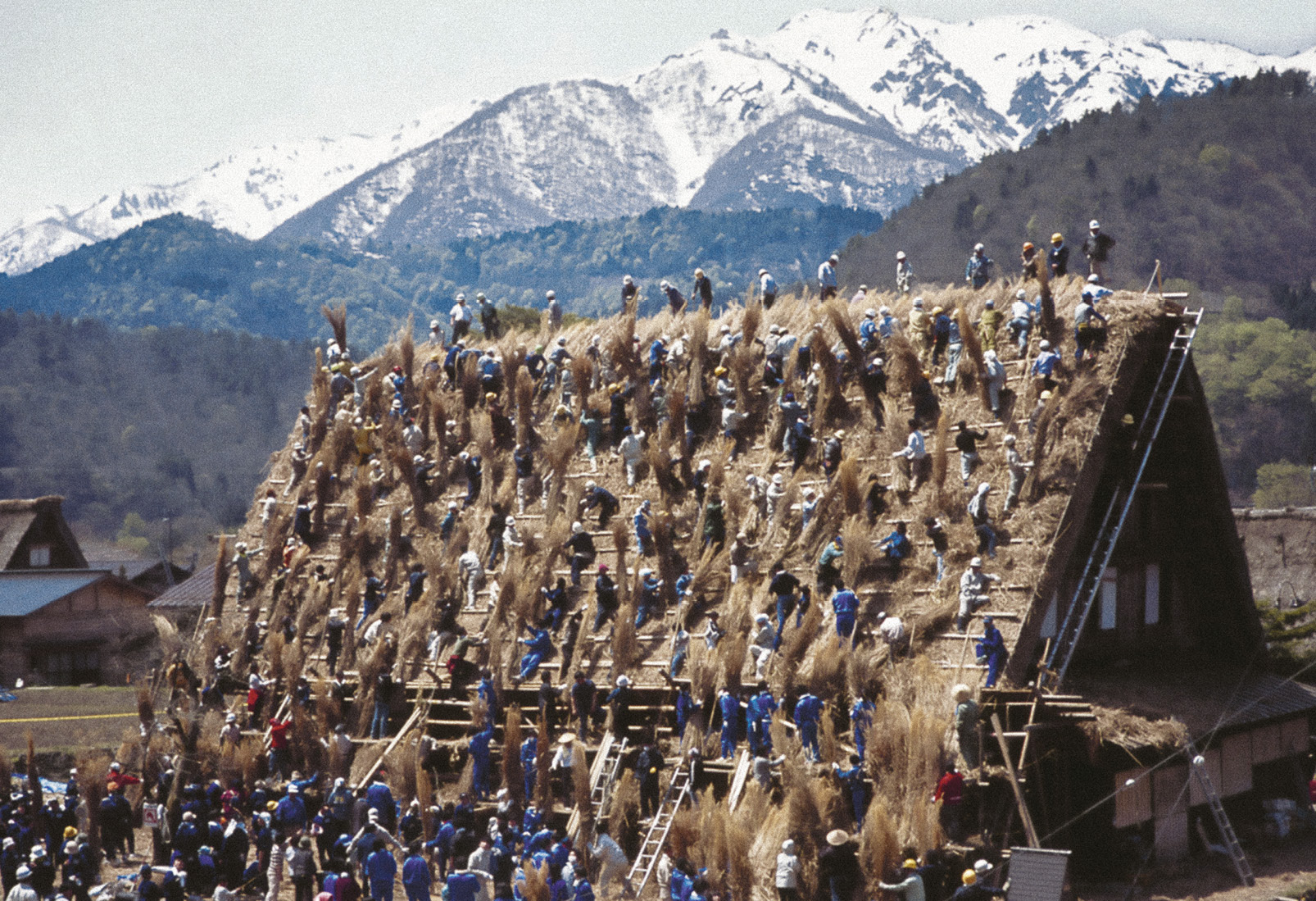
Alexander Eriksson Furunes & Sudarshan Khadka explore the practice of mutual support in different cultures, such as yui in Japan, bayanihan in Philippines and dugnad in Norway. The image shows the maintenance of a thatched roof performed through yui in the village of Shirakawa-go, Japan. Courtesy of the city and the residence of Shiragawa ko.
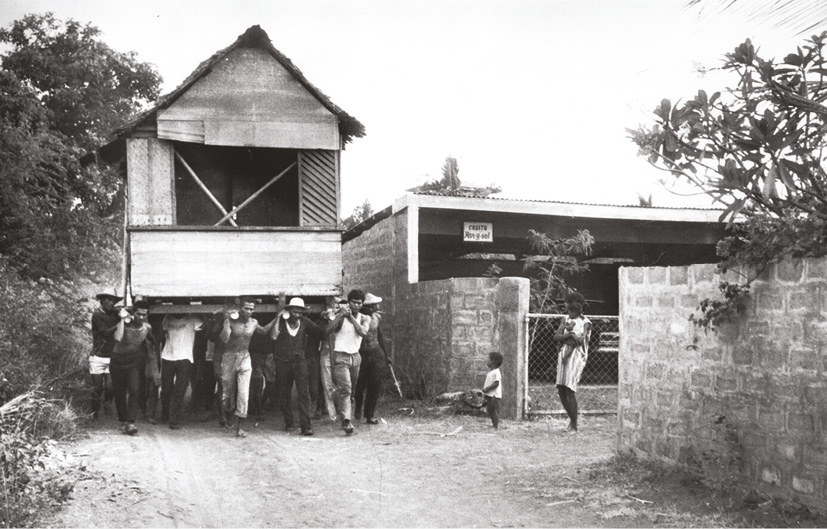
Thirty people moving a house through bayanihan, the Filipino practice of mutual support, civic unity, and cooperation, Nasugbu, Batangas, Philippines, 1972. Alexander Eriksson Furunes & Sudarshan Khadka. Structures of Mutual Support, 2022. Courtesy of Ayala Museum Research Team, Filipinas Heritage Library.
AMAR KANWAR
The Sovereign Forest, 2011–ongoing
The Sovereign Forest attempts to initiate a creative response to the understanding of crime, politics, human rights, and ecology. The validity of poetry as evidence in a trial; the discourse on seeing, compassion, justice, and the determination of the self—all come together in a constellation of films, texts, books, photographs, seeds and processes. The Sovereign Forest has overlapping identities. With each iteration, it reincarnates as an art installation, an exhibition, a library, a memorial, a public trial, an open call for collection of more ‘evidence’, an archive, a school and a proposition for a space that engages with education, politics and art. The work emerges from ongoing efforts in Odisha (formerly Orissa), an epicentre of conflicts between local communities, governments and corporations over control of natural resources such as agricultural lands, forests, rivers and minerals. A series of non-violent resistances by resilient peasants, fisher-folk and tribal communities, powered by autonomous local leaderships, has delayed land acquisitions and influenced the enforcement of new regulations stressing human and community rights.
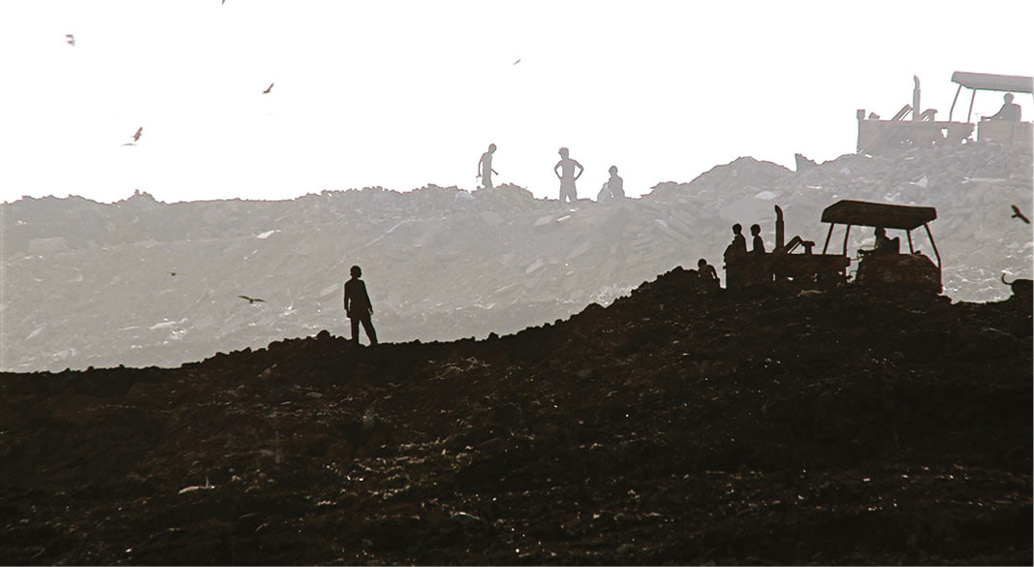
Part of The Sovereign Forest, a tender love letter about a landscape that once was, now obliterated, and the experience of that loss. Amar Kanwar. A Love Story, 2010, film still. Courtesy of the artist.

Amar Kanwar. The Sovereign Forest: Selections from the Evidence Archive, 2012–2015, 251 digital prints (photographs, documents), contributed, collected, found, installation view at the NTU Centre for Contemporary Art Singapore. Courtesy of NTU CCA Singapore.

‘Lying Down Protest’ by villagers of Dhinkia, Gadkujang, Govindpur and Nuagaon, Odisha, 11 June 2011. Taken by various photographers. Amar Kanwar. The Sovereign Forest, 2012–ongoing. Courtesy of the artist.
Advocacy
How can we ever stay silent, remaining only as onlookers—from ivory towers to park benches—as though all forms of living species residing, dwelling, and interrelating on landforms and bodies of water are not intertwined? As though spatial happenings from afar, seemingly small and distant, do not ripple in their effects? Advocacy as a form of service can act as an amplifier for unheard stories—those of mountains, oceans, rivers and seas, and other forms of life that speak in languages we consistently fail to listen and acknowledge. It can galvanise support with the intention to effect policy change. By drawing attention to silent witnesses, advocacy can stimulate public awareness, mobilise collective action, and lend weight to movements striving to reshape normative and legal frameworks. It positions care and accountability at the core of governance and environmental stewardship, serving as a stark reminder that the well-being of ecosystems relies on interdependencies between human and nonhuman entities.
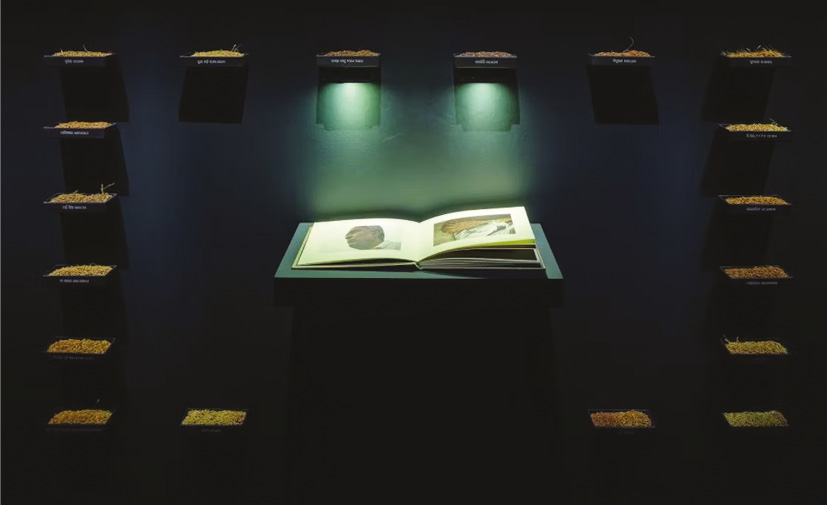
272 Varieties of indigenous, organic rice seeds. Amar Kanwar. The Sovereign Forest, 2012, installation view, NTU Centre for Contemporary Art Singapore. Courtesy NTU CCA Singapore.

An experience of a landscape just prior to erasure as territories are marked for acquisition by industries. Amar Kanwar. The Scene of Crime, 2011, film: HD, colour, sound, 42 mins. The Sovereign Forest, 2012, installation view, NTU Centre for Contemporary Art Singapore. Courtesy NTU CCA Singapore.
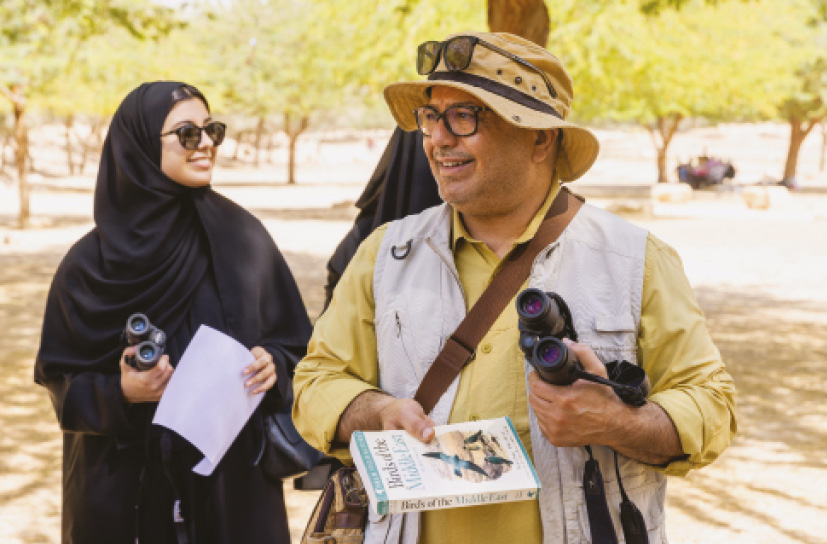
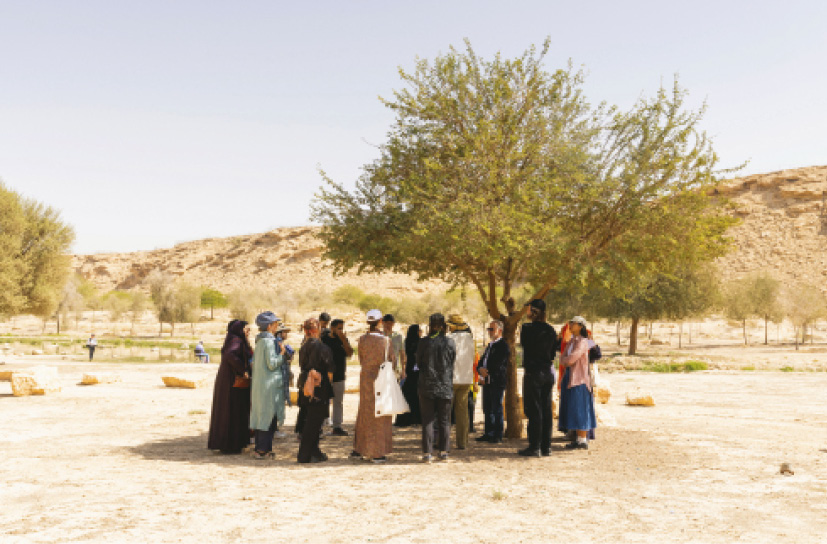
Conducted by artist Lucy Davis and the ornithologist Abdullah H. Alsuhaibany, the workshop introduced participants to local birdlife and engaged in deep listening exercises. The Migrant Ecologies Projects. If your bait can sing the wild one will come bird-watching workshop, Wadi Hanifah, February 24, 2024, After Rain, Diriyah Contemporary Art Biennale 2024.

A banyan recalls a Kelicap Sepah Raja (Crimson Sunbird). Sun-Shadow puppet of found internet bird. Photographed where the bird was last heard, along the rail tracks at Tanglin Halt. The sun-shadowed puppet is part of a stop-motion animation in the Railtrack Songmaps project, developed through a process entitled “Avian Web-Re-Wild”, which involved printing online images and video frames of birds seen or heard in a Nature Society Singapore bird count, commissioned by The Migrant Ecologies Projects, along the rail tracks at Tanglin Halt, Singapore.
The Migrant Ecologies Projects. Railway Songmaps, 2016, stop-motion still of found, internet bird video. Courtesy of Lucy Davis and Kee Ya Ting.
THE MIGRANT ECOLOGIES PROJECTS
{if your bait can sing the wild one will come} Like Shadows Through Leaves, 2021
Founded in 2009 by Lucy Davis as an umbrella for informal, durational, transdisciplinary collaborations in and around art and ecology, primarily in Southeast Asia. It involves the communities along the railway, involving other art practitioners. One of these formats is the above-mentioned film, that unfolds the artists’ long-term engagement with Tanglin Halt, one of Singapore’s oldest public housing estates, which runs alongside a former railway track. The land, once an indeterminate-governance zone, played host to a fecund variety of more-than-human activities—105 species of birds were observed by ornithologists in this plot of land. Once a gathering place and home to community farms and unofficial tree shrines, it has since been repurposed as a green corridor park. Repeated returns to the site trace lingering remnants of calls, echoes, shadow memories, and transformative encounters that continue to animate this zone.
Other formats are workshops such as a bird-watching workshop at Wadi Hanifa on the outskirts of Riyadh conducted by Davis and ornithologist Abdullah H. Alsuhaibany, introducing participants to local birdlife and engaging them in deep listening exercises, on the occasion of the 2024 Diriyah Contemporary Art Biennale.
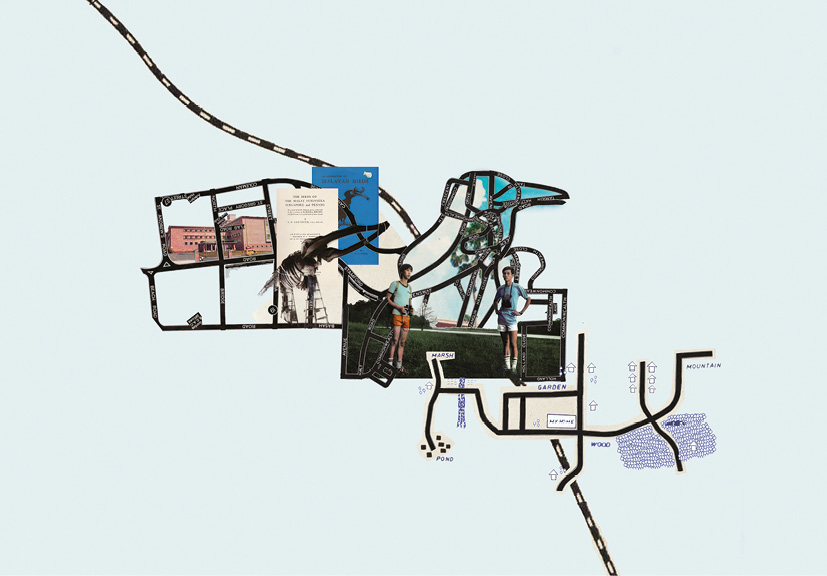
Zachary Chan and Lucy Davis, Songmap for Lim Kim Seng and Lim Kim Chua, 2020, from Railtrack Songmaps, 2015–ongoing. The Migrant Ecologies Projects, Railtrack Songmaps Roosting Post 2 (2020), Jendela, The Esplanade, Singapore.
URSULA BIEMANN
Devenir Universidad, 2019–2022
At the invitation of the leader of the Indigenous Inga people, Hernando Chindoy, and with the support of academic and non-academic partners, an Indigenous University was co-created to transmit ancestral knowledge of the living, sentient Andean Amazon forest and help reconnect dispersed community through the establishment of an intellectual center, one that is not centralised but spreads across the entire territory in a network of learning paths. Decades of armed conflict and a history of colonial occupation have dismantled the structures necessary to foster epistemic cultures. The co-creation of an indigenous university is intended to formulate a collaborative network of different human and other-than-human thinking and acting together with the territory. At its core lies the biocultural paradigm, which recognises that biological, cultural and epistemic diversity have co-evolved and are inseparable from one another.
These images are reproduced from Devenir Universidad www.deveniruniversidad.org,2021

Ursula Biemann. Forest Mind, 2021, video still.
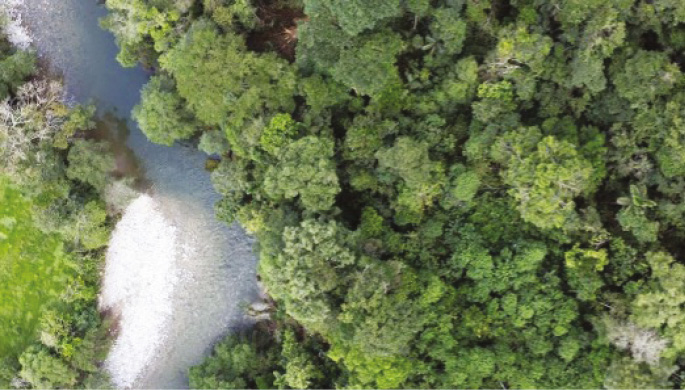
Ursula Biemann. Field research at the South of Colombia, 2018, Devenir Universidad. Courtesy of the artist.
Guardianship
In recent news, crows and other bird species attacking drones in various parts of the world have become common sights and reports. These birds are not necessarily territorial but are protective of their environment against objects perceived as threats. In various Southeast Asian mythologies, birds symbolise spiritual guardianship, strength, and protection. The network of knowledge exchange between human and more-than-human thinking can be manifested through keen observation and attunement to one’s place and surroundings, by virtue of coexistence and a sense of responsibility. In this vein, Indigenous communities understand their relationship with the environment not as service, but as stewardship. Learning from the Pacific islands, they see themselves as guardians of land and sea—a continuum rather than a division. In Papua New Guinea, rather than land ownership, people consider themselves custodians of the land. The extends to a cooperation with multispecies custodians, who allow them to speak on behalf of their habitats, which comprise complex ecosystem of living entities, each possessing intrinsic rights and spiritual representation.
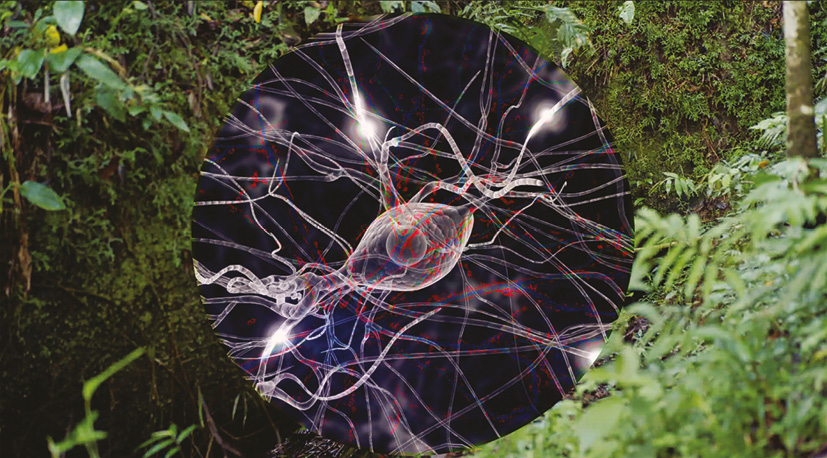
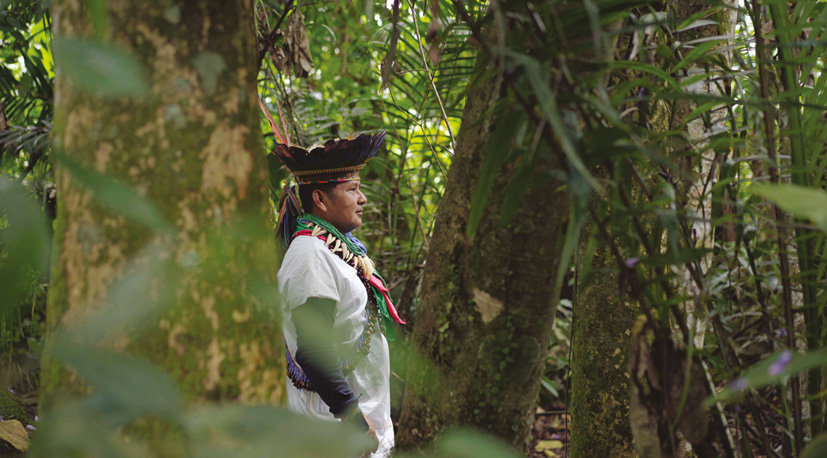
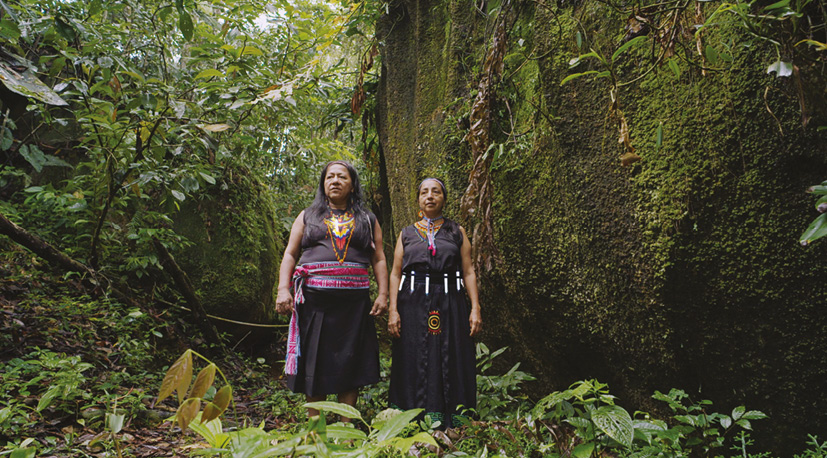
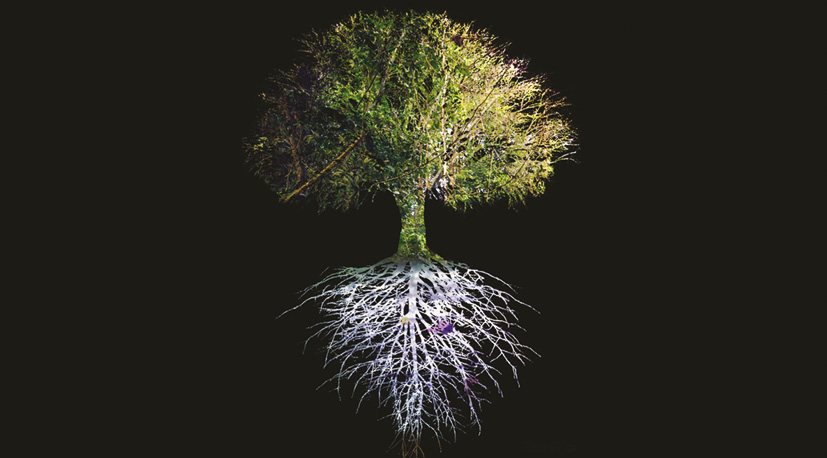
Ursula Biemann. Forest Mind, 2021, video stills.
4K UHD video, sound, 31:45mins. Courtesy of the artist.
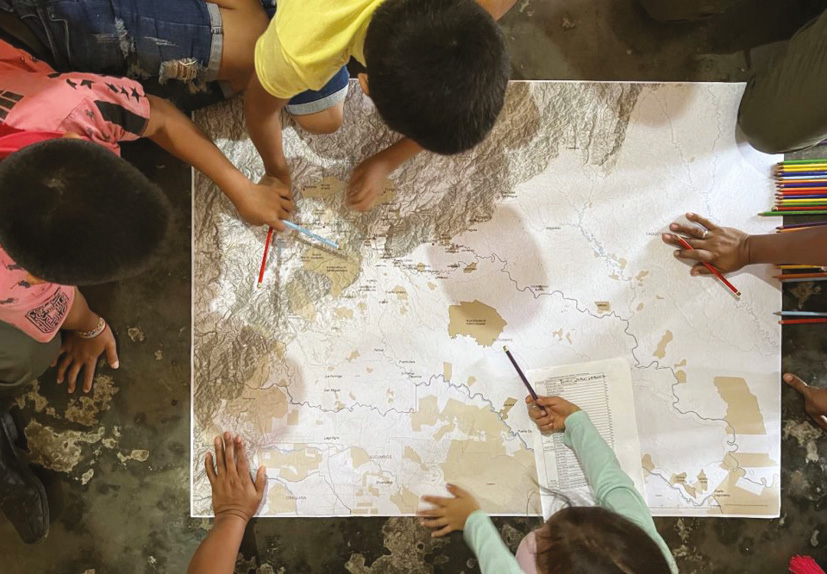
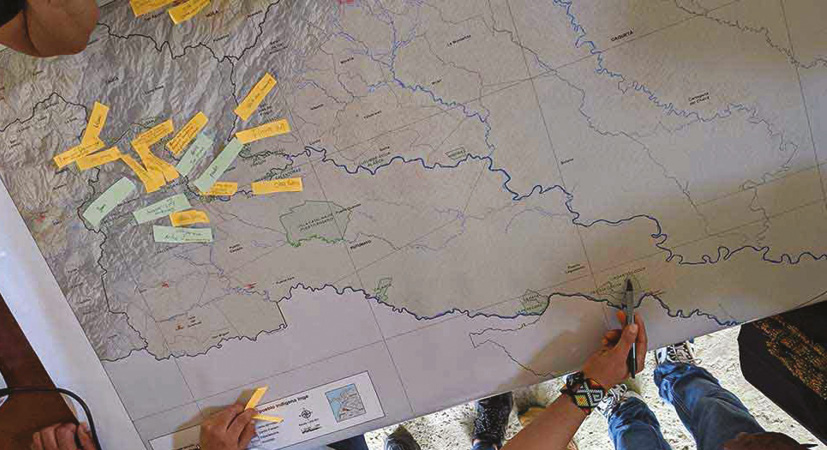
First round of meetings in five zones of Inga territory to collectively draw biocultural cartographic representations in support of intercultural higher education, between 28 June to 12 July, 2022. Ursula Biemann. Devenir Universidad, 2019–2022. Photo by Álvaro Hernández Bello. Courtesy of the artist.
MARTHA ATIENZA
Adlaw sa mga Mananagat / Fisherfolk Day, 2022
In the Visayas region of the central Philippines, the fishing communities of Bantayan Islands have for decades borne the brunt of the adverse impacts of commercial ventures backed by the government. Framed as a pathway to development and economic growth, the islands of Bantayan have witnessed increased dispossession of over 9,000 fisherfolk in one of the many islets through land privatisation and the creation of an economic zone allowing foreign nationals to fully own assets. Tourism was promoted as alternative livelih ood, effectively forcing fisherfolk into labourers working for resort owners. GOODLand emerged out of this process as a platform for Local Government Units (LGUs), NGOs and small-scale fisherfolk to work collaboratively on the preservation, protection and the eventual alteration in marine food resources, working with existing local and national fishery policies. As a result of this initiative, the Resolution No. 27, which established a Marine Protected Area (MPA) in Mambacayao Dako, and an ordinance declaring a yearly Bantayan Fisherfolks’ Day/ Adlaw sa Mga Mananagat were passed. Adlaw sa mga Mananagat comprises three video works that came forth out of the last three to five years that Martha Atienza has, collaboratively, been working to ensure that Bantayanons have a say in the future of their islands.
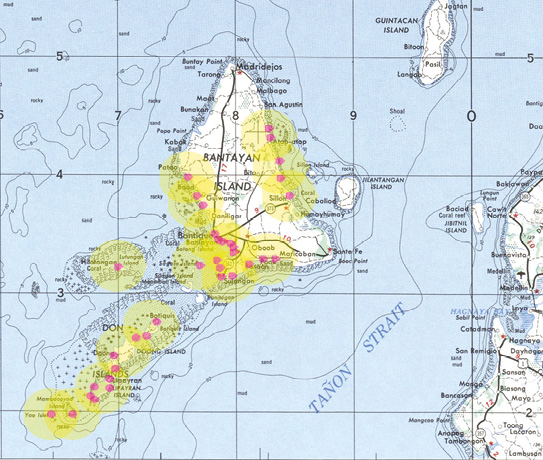
Location of 37 coastal communities: 11°14’46.4”N 123°44’08.7”E, Municipality of Bantayan, Central Visayas, Tañon Strait, Visayan Sea, Cebu, The Philippines.
Martha Atienza, Adlaw sa mga Mananagat (Fisherfolks Day), 2022. Courtesy of the artist and GoodLAND derneği.
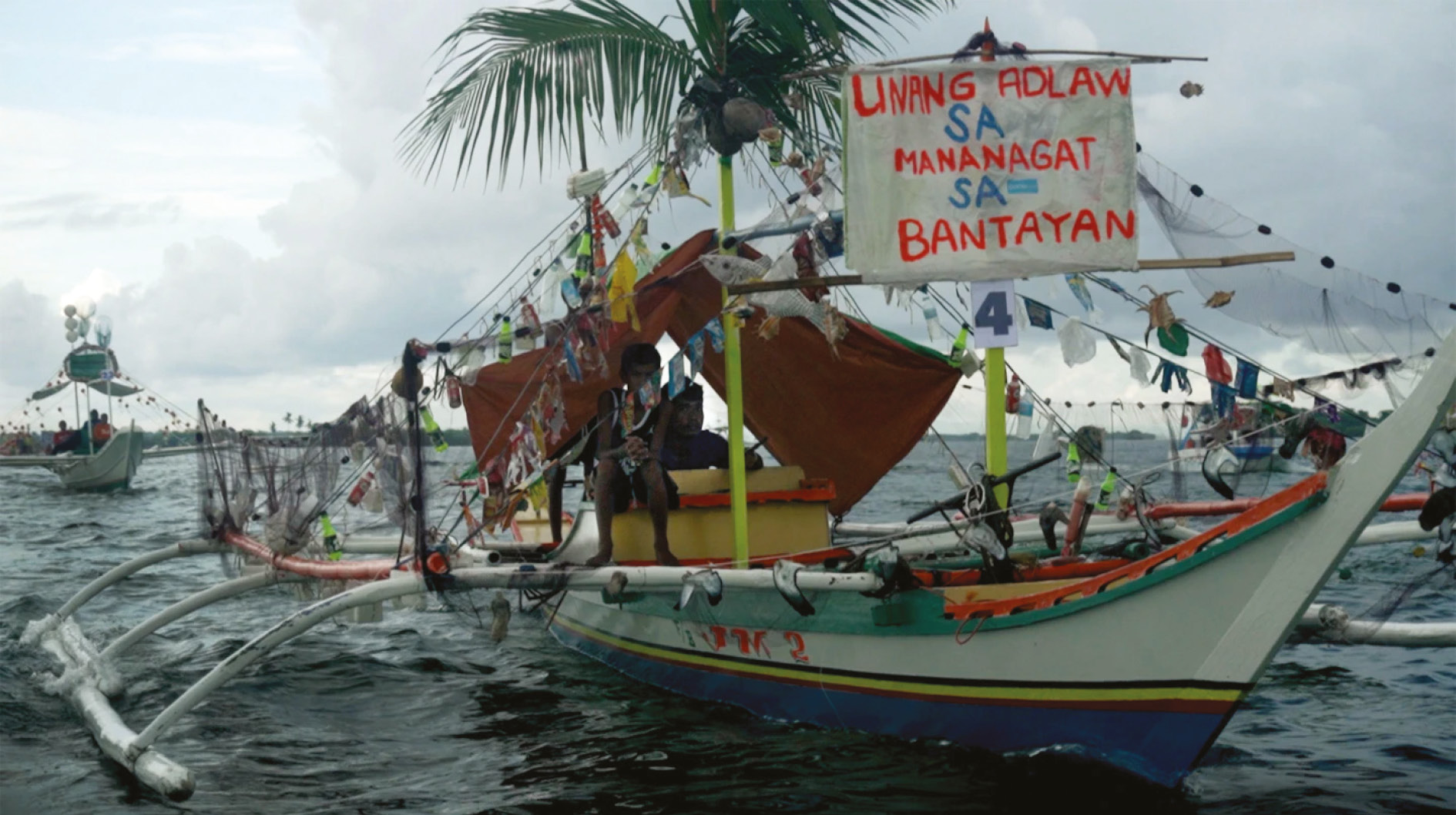
Martha Atienza. Adlaw sa mga Mananagat (Fisherfolks Day), 2022. Courtesy of the artist and GoodLAND derneği.
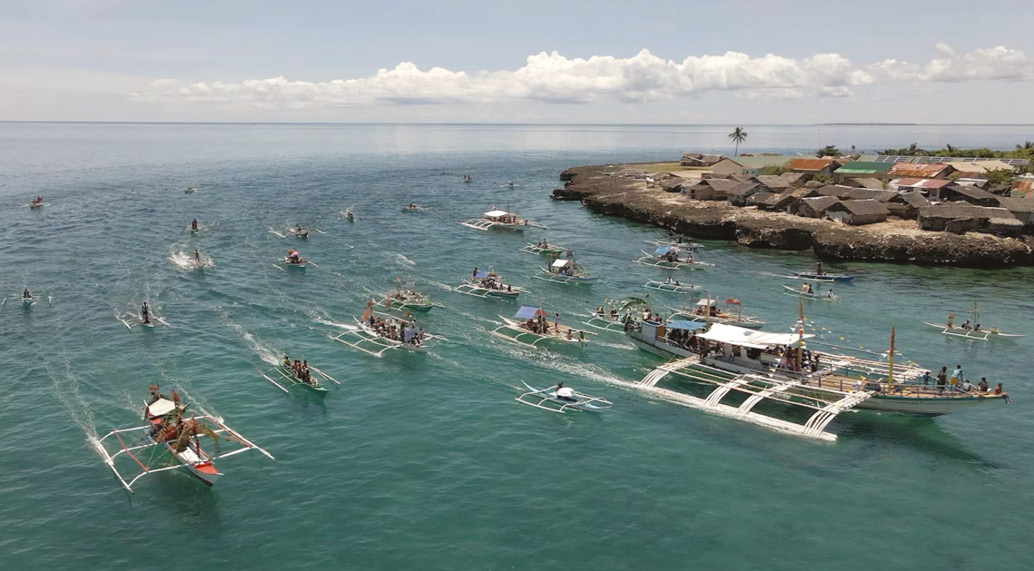
Martha Atienza. Drone shot of a boat parade in the waters around Bantanyan Island in celebration of Fisherfolks Day, 2022.
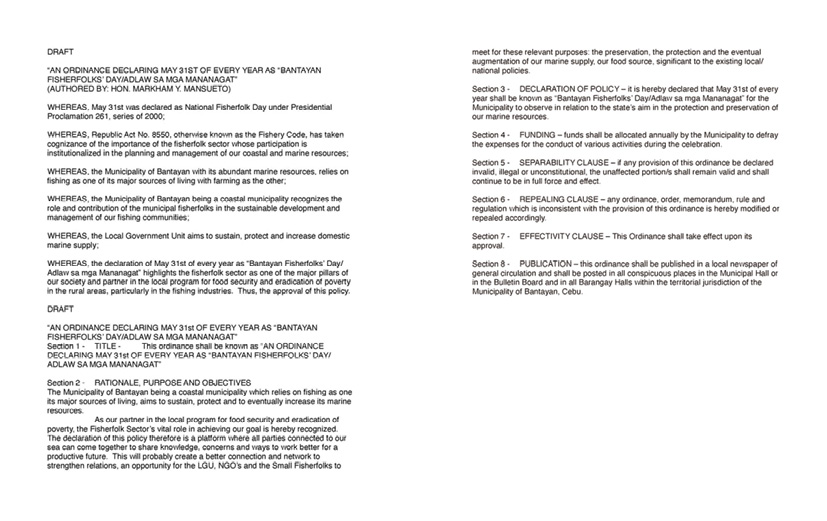
Martha Atienza. Ordinance declaring 31st May of every year as “Bantayan Fisherfolks’ Day”.
YEE I-LANN
TIKAR/MEJA, 2020–ongoing
TIKAR/MEJA is a series of mats developed by Yee I-Lann and indigenous weavers from the Bajau Sama DiLaut communities in Sabah, Malaysia. The meja (table), according to Yee, represents “the violence of administration” in colonial and patriarchal societies. The tikar (woven mat) in contrast is fundamentally egalitarian, grounding one to the earth. Since pre-colonial times, the tikar has been a common object for socialisation, community, and relaxation across Southeast Asia. In juxtaposing these forms, by bringing the table and mat together, Yee posits: “A table on a mat is like a stone on paper in a game of rock-paper-scissors, where my open hand encloses your fists. To decolonise is to see the table and to see the mat.”
A social dimension is further layered in Yee’s artistic practice. These assemblages of mats through collaborative weaving have generated economic opportunities for communities involved, while simultaneously raising awareness of the importance of preserving indigenous cultures and traditions. They build towards the collective desire to foster social and ecological resilience in response to the devastating effects of sea and land use and climate change.
TIKAR/MEJA/PLASTIK is woven by Aisyah Binti Ebrahim, Alini Binti Aniratih, Alisyah Binti Ebrahim, Ardih Binti Belasani, Darwisa Binti Omar, Dayang Binti Tularan, Dela Binti Aniratih, Endik Binti Arpid, Erna Binti Tekki, Fazlan Bin Tularan, Kinnuhong Gundasali, Kuoh Binti Enjahali, Luisa Binti Ebrahim, Makcik Lukkop Belatan, Makcik Siti Aturdaya, Malaya Binti Anggah, Ninna Binti Mursid, Noraidah Jabarah (Kak Budi), Roziah Binti Jalalid, Sabiyana Binti Belasani, Sanah Belasani, Tasya Binti Tularan, and Venice Foo Chau Xhien.
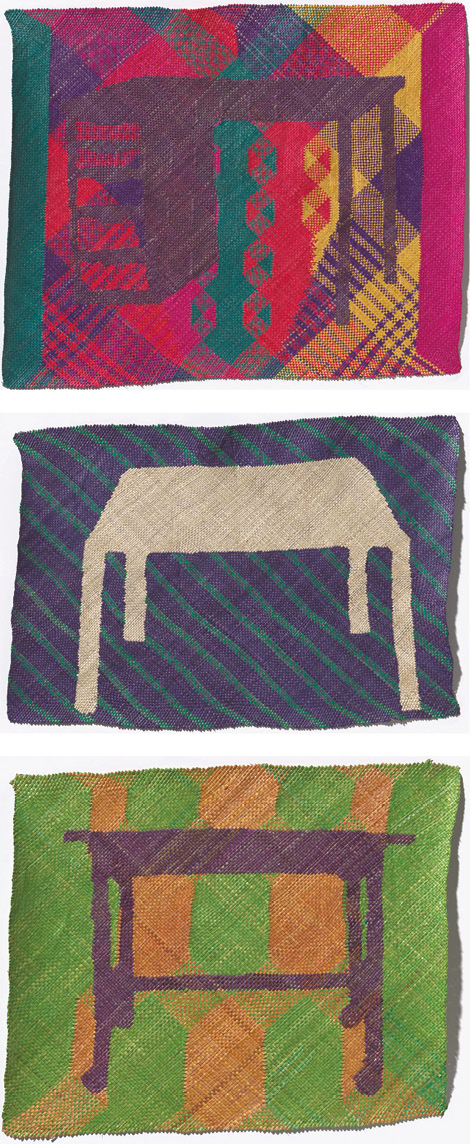
Yee I-Lann. TIKAR/MEJA/PLASTIK, 2023. Courtesy of the artist.
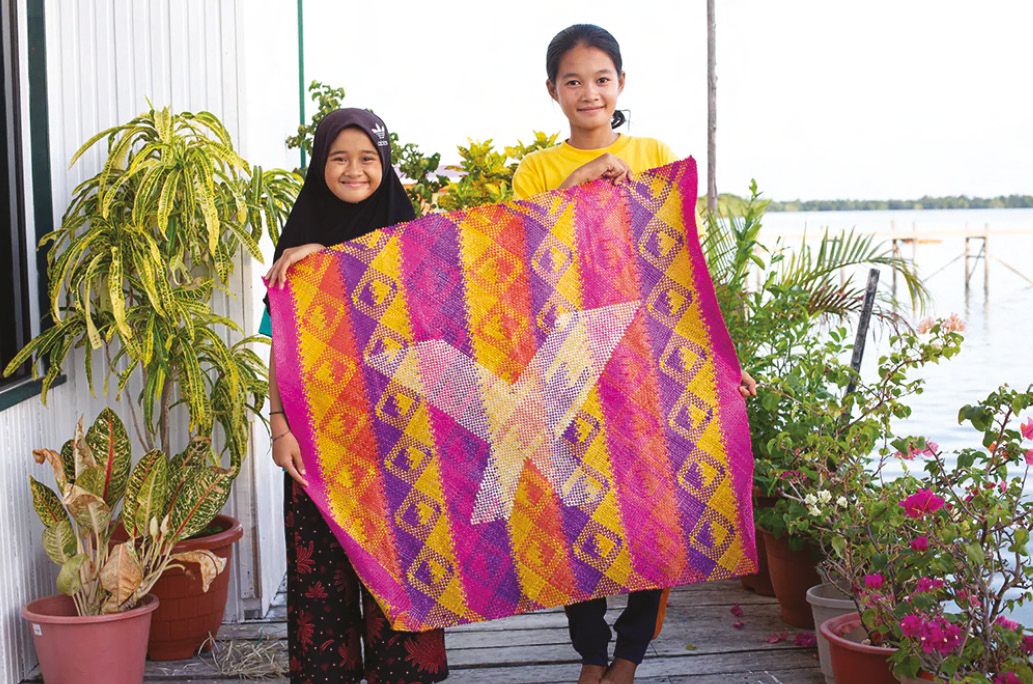
Yee I-Lann. Tikar Meja, with weaver Adik Umairah (Left) and Adik Marsha (Right), 2023.
Photo by Chris Perreira. Image courtesy of the artist and Silverlens.
Ownership
What does ownership look like in the context of the global commons? Who gets to claim the vast oceans and what lies beneath? What responsibilities and ethical concerns arise when asserting ownership over a resource? Can a single entity own a cultural heritage, a shapeshifter that adapts and transforms across time and context, and what might equitable intellectual property rights look like when that heritage is shared among many? Yet, where institutions are faced with complex questions and challenges, and when they are overstretched, inaccessible, or indifferent, instead of passively waiting for a service to be provided or support to be rendered, artists and their communities often take steady steps towards owning a problem, challenge, or situation, establishing their own form of service that becomes crucial steps towards building sustainable modes of livelihood and ways of living together. Such initiatives should not be perceived as merely individual acts of self-reliance, but as gestures that reframe agency and responsibility within a broader social ecology. Here, shared culture is celebrated, not divisive.
TIKAR REBEN, 2020
The motifs within Tikar Reben bear an index of multilingual and multigenerational heritage patterns that communicate weaving techniques and knowledge. Tikar Reben—in its accompanying video—documents the unrolling of the 53-metre tikar across the divide between the Malaysian Omadal Island village and the stateless Bajau Sama DiLaut weavers’ water village. The weaving and the woven mat become a cultural bridge, celebrating a shared cultural identity across a geopolitical landscape marked by prejudice.
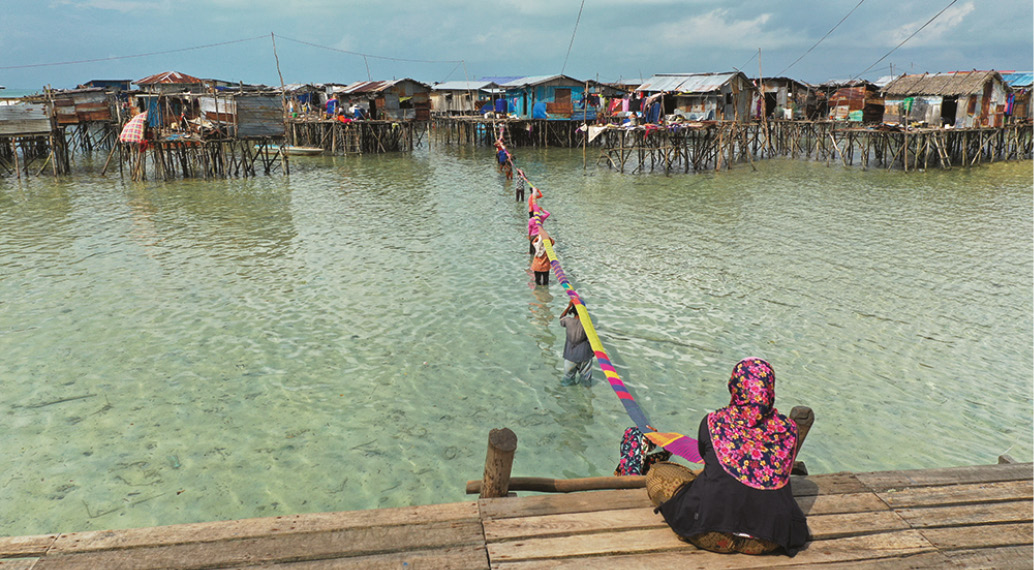
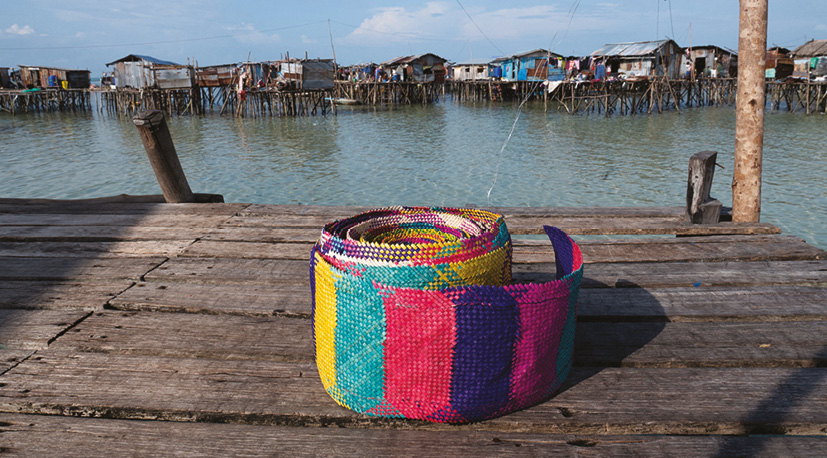
A 53-metre-long ribbon containing an index of foundational counting patterns that make up Bajau Sama Dilaut woven patterns and motifs. Yee I-Lann. Tikar Reben, 2020. Photo by Andy Chia. Courtesy of the artist and Silverlens.
Accountability
Environmental justice is social justice. It is multispecies justice. It is political justice. It is migrant justice. No longer are we disjointing various forms of aggression, oppression, terrorisation as separate and distinctive from one another. The various forms of service in the supply chain industry—encompassing the destruction of natural landscapes for raw materials, the atrocious wages and forced labour from developing nations leveraged to meet demand and ensure efficiency for the global supply of endless goods—are often carried out under the guise of environmentalism: a practice termed as greenwashing, a misleading green sheen that does more harm than good. A service to the environment necessitates greater transparency and accountability, as it otherwise risks becoming a form of eco-colonialism or neo-colonialism, marked by human rights and environmental violations.
NABIL AHMED/INTERPRT
Mining the Abyss, 2022
Challenges in the spatial and visual representation of the vast and deep ocean have proven advantageous for the mining industry, which often claims excavation operations to be environmentally friendly. To counter greenwashing tactics, INTERPRT analysed data shared by marine biologists to simulate mining footprints and collaborated with an oceanographer to model the trajectory of plume particles from seabed mining in the Clarion-Clipperton Zone. Blue Peril, a multimedia advocacy tool created using 3D modelling software, visualises for the first time the vast area of the Pacific expected to be impacted by deep-sea mining and the potential devastation it could bring to marine ecosystems and habitats. Mining the Abyss is a visual investigation on deep-sea mining and accountability.
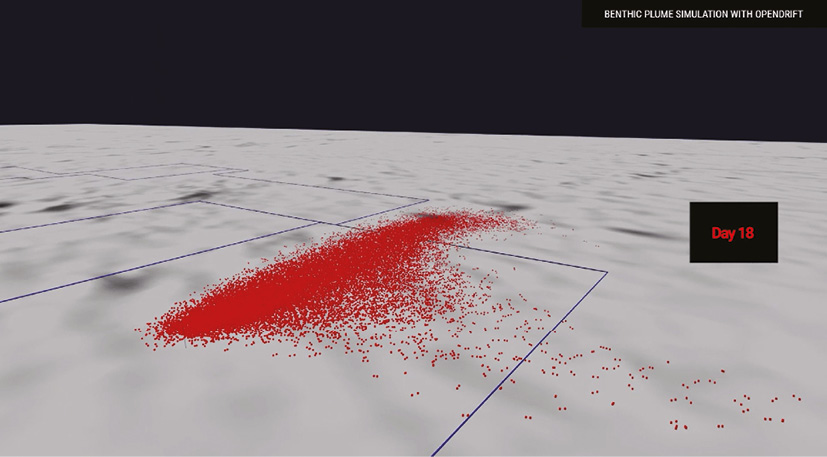
INTERPRT. A visual investigation on deep-sea mining and accountability in the Pacific Ocean. A visual demonstration of plume distribution in the Nori D contact area using Open Drift.

A visual investigation on deep-sea mining and accountability in the Pacific Ocean. Vertical settlement particles of plumes during the processing of mineral nodules on surface ships. INTERPRT. Blue Peril, Mining the Abyss, 2022, film stills. Courtesy of INTERPRT.
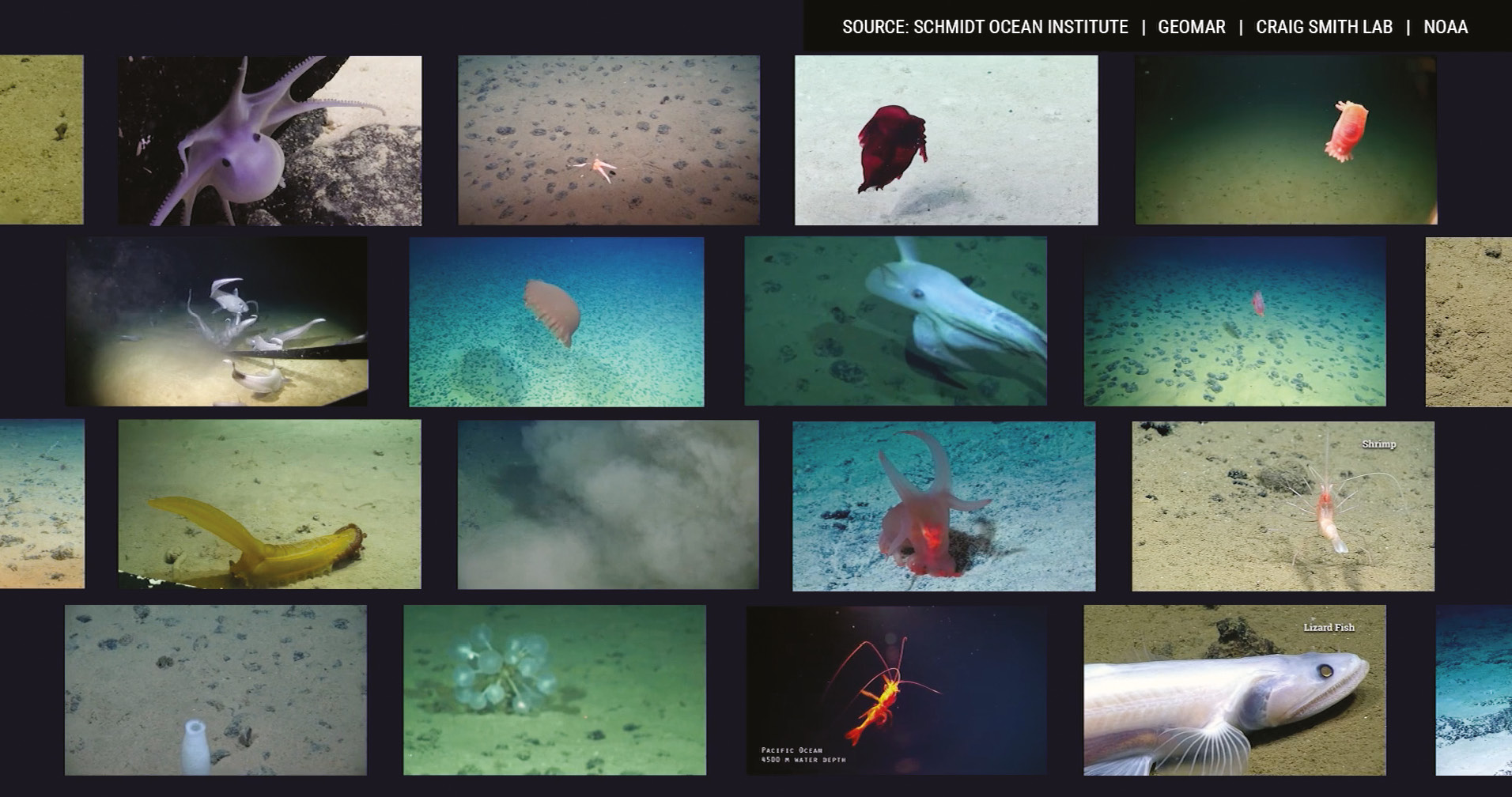
INTERPRT. A visual investigation on deep-sea mining and accountability in the Pacific Ocean. The diverse and rich deep-sea ecosystem in the Clarion-Clipperton zone.
ARMIN LINKE
Prospecting Ocean, 2018
In Prospecting Ocean, Linke scrutinises the administration of the oceans and exposes the simultaneous fascination with and alienation from modern technologies that map, visualise, and exploit resources in the ocean. Prospecting Ocean, the title film which lends the exhibition its name, is a cinematic journey that traverses gatherings of decision-makers often off-limits to the public, from the United Nations assemblies, international law conferences, marine research centers, deep-sea mining companies and activist meetings. Through a series of photographs, critical texts and key documents, and filmed interviews with marine biologists, geologists, policymakers, legal experts, and activists, Linke grapples with the tensions between ecological protection and exploitation of the ocean, a global common. The material is an invitation to consider the implications of oceanic excavations and resource extraction for both the environment and local economies and cultures.
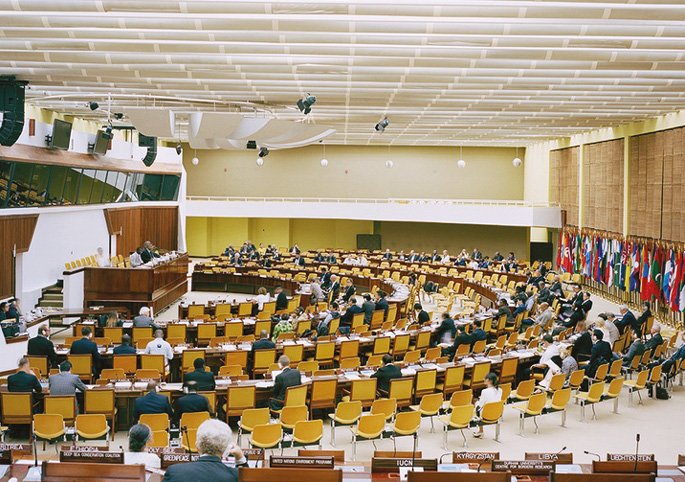
Armin Linke. Twenty-Second Session of the International Seabed Authority Assembly, ISA, Kingston, Jamaica, 2016. Courtesy of the artist.
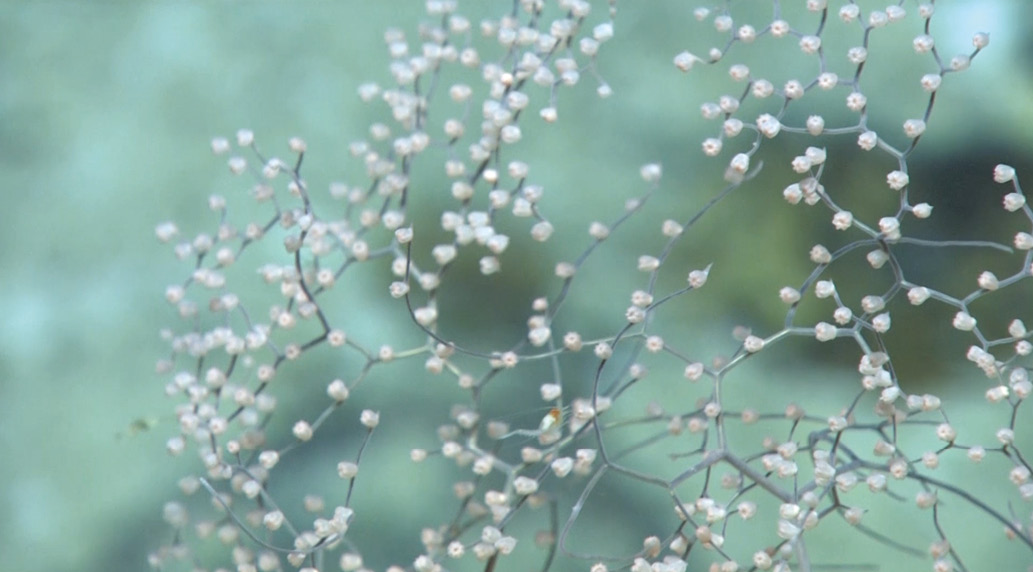
Armin Linke. OCEANS. Dialogues between ocean floor and water column, 2017, video still.
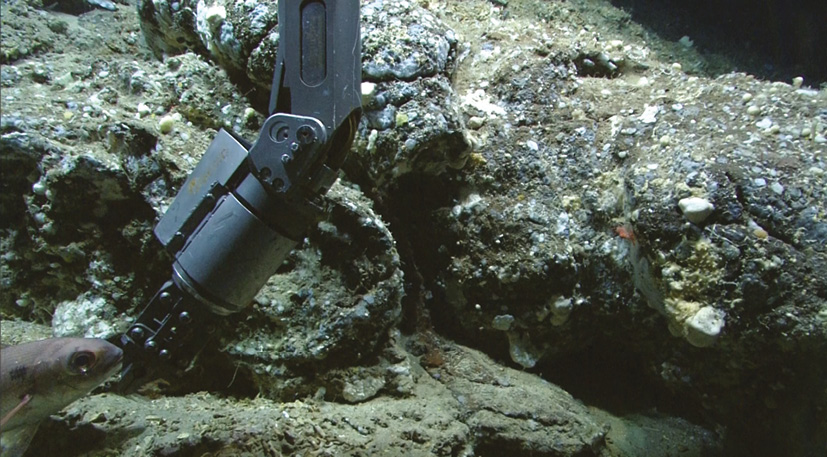
Installation view: OCEANS. Dialogues between ocean floor and water column, Edith-Russ-Haus for Media Art, Oldenburg, 2017. Courtesy of Armin Linke and ROV Video Archive Material GEOMAR - Helmholtz Centre for Ocean Research Kiel and MARUM – Center for Marine Environmental Sciences, University of Bremen. The project was commissioned and co-produced by Thyssen-Bornemisza Art Contemporary Academy (TBA21), Vienna.
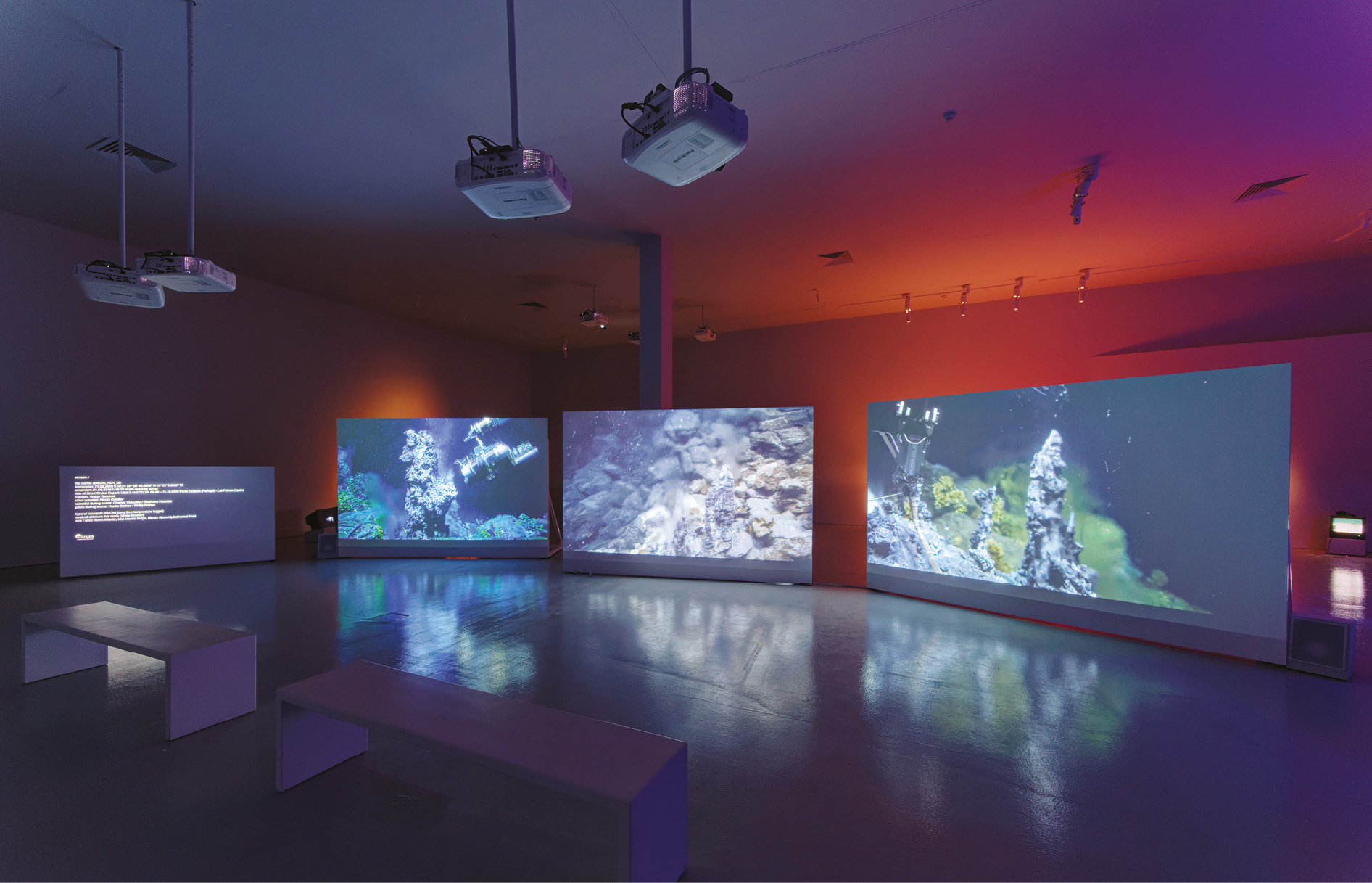
Armin Linke. OCEANS. Dialogues between ocean floor and water column, 2017, The Oceanic (2017–18), installation view at the NTU Centre for Contemporary Art Singapore. Courtesy of NTU CCA Singapore.
Exchange
The invention of paper money finds its history resting on the bark of the mulberry tree—a tree native to Asia and North America, and prevalent in China for the cultivation of fruit and sericulture. The white bast of the tree, resembling sheets of paper, was issued as a form of authorisation and formal transaction. Yet a single sheet of paper holds no greater meaning or value than the tree itself, the tree that provides sustenance and shade. Interactions from transactions have now been reduced to the mere fufillment of agreed terms in exchange for payments. The characteristic of service provision in today’s impersonal market economy implies a contractual obligation shaped by monetary value. This trickles down to educational institutions as well. In response to this, various artists’ projects, including the Silent University, point to a return to reciprocal exchange rooted in sustained relationships and shared responsibilities. Knowledge and skills are not commodified; rather, they are contributions that feed into education for all. In doing so, these initiatives foster a more equitable and relational form of association, where value is not measured solely by economic terms but by the quality of interaction, mutual recognition, and the ongoing maintenance of community bonds.
AHMET ÖĞÜT
Silent University, 2012–ongoing
A solidarity-based knowledge exchange platform by and for displaced people and forced migrants, it operates outside the restriction of migration laws, language limitations and other bureaucratic hurdles. Founded in 2012, it has multiplied itself on smaller scales in different cities, establishing active branches in Sweden, Germany and more recently, Turkey. The impetus of the establishment is rooted in the belief that everybody has the right to educate, and that systemic failure is not an excuse to outlaw those who are seeking asylum. In Öğüt’s words, the objective is to sustain long-term peer-to-peer recognition and care. With ideological and practical principles firmly rooted, the Silent University remains even as directors of collaborating institutions change over the years.
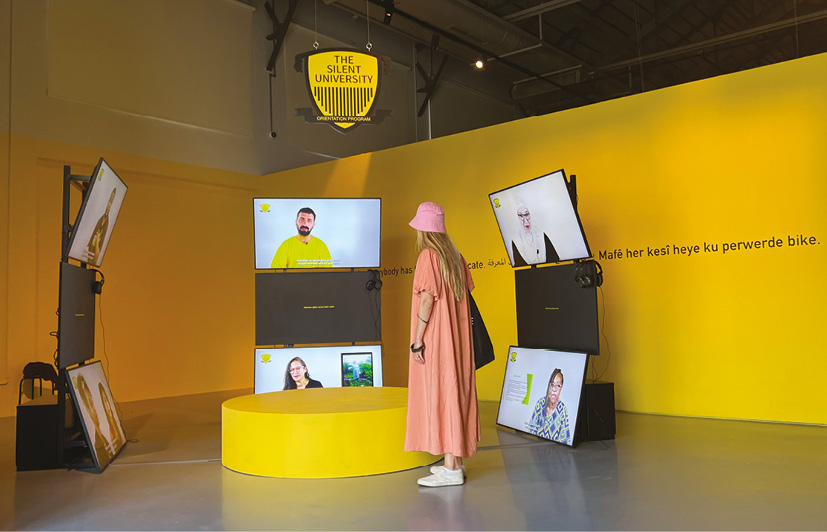
Ahmet Öğüt and The Silent University Team. The Silent University, 17 September–20 November 2022, 17th Istanbul Biennial, installation view at the Museum Hasanpasa Gashouse. Photo by Sahir Ugur Eren. Courtesy of Istanbul Biennial.
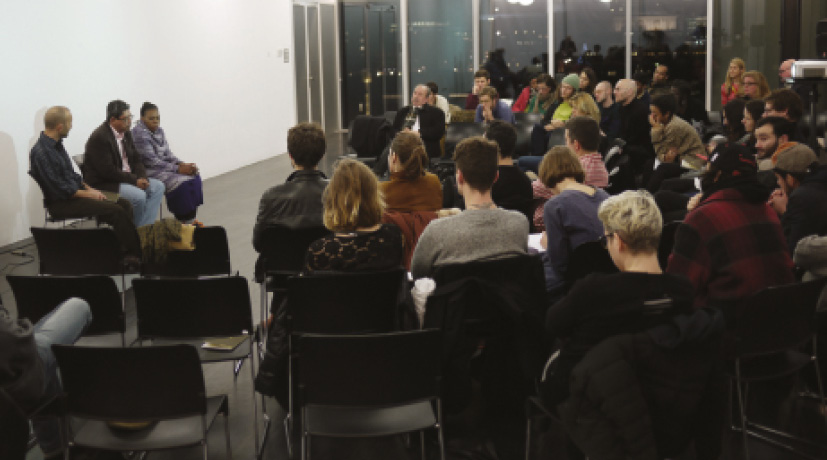
A Silent University discussion at Tate Modern. Ahmet Oğüt and The Silent University Team.
The Silent University, 2012. Courtesy of the artist and The Silent University.
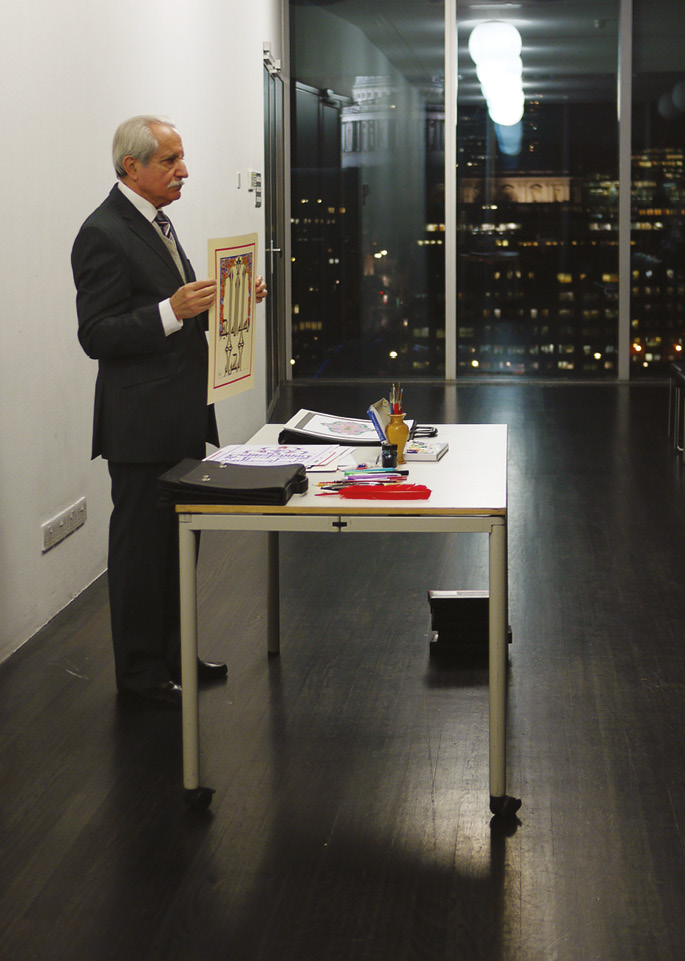
Presentation on Arabic calligraphy by calligrapher Behnam Al-Agzeer at Tate Modern. Ahmet Oğüt and The Silent University Team. The Silent University, 2012. Courtesy of the artist and The Silent University.
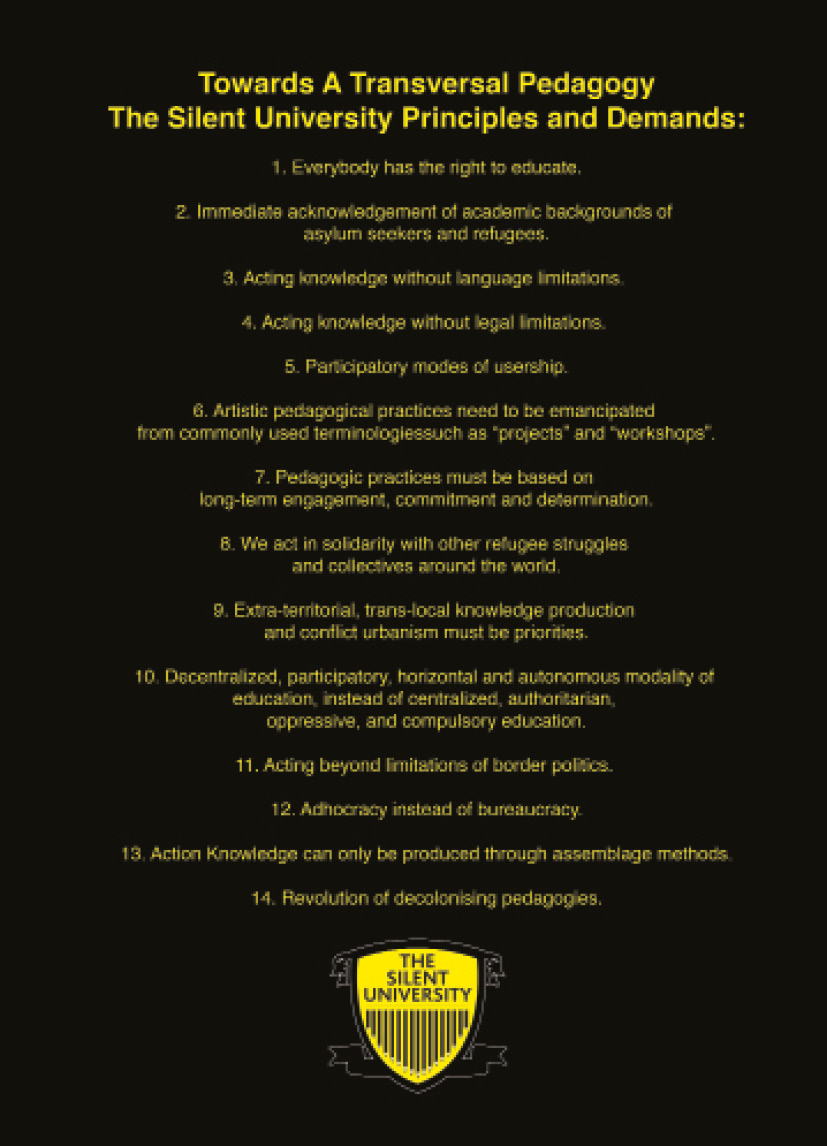
The Silent University. Towards a Transversal Pedagogy: The Silent University Principles and Demands, 2012. Courtesy of the artist and The Silent University.
TEXT CREDITS
Additional texts are authored by Anca Rujoiu (Britto Arts Trust and Migrant Ecologies Project), and Alexander Eriksson Furunes and Sudar Khadka (Structures of Mutual Support).
Artists’ biographies are authored by Laura Schleussner (Armin Linke, Ursula Biemann, Migrant Ecologies Project, and Alexander Eriksson Furunes and Sudarshan Khadka).
ACKNOWLEDGEMENTS
The authors would like to express our sincere gratitude to Milenko Prvački and to editor Venka Purushothaman, who extended the invitation for us to curate this chapter on this year’s theme of Service for the ISSUE Art Journal. Our thanks also go to the editors Susie Wong and Weixin Quek Chong, as well as to graphic design firm Sarah and Schooling, for their care and patience throughout this process. We are indebted to the artists featured in this section for allowing us to use their material, and the authors who have contributed to the various artwork texts.
We would also like to thank the 17th Istanbul Biennial, the Diriyah Contemporary Art Biennale 2024, the NTU Centre for Contemporary Art Singapore, and TBA–21 Academy The Current, where these artistic projects were presented.
ARTISTS’ BIOGRAPHIES
Nabil Ahmed/INTERPRT (b. 1978, Dhaka, Bangladesh) has been researching environmental conflicts for over fifteen years. His spatial practice and writing interrogate the representational challenges of environmental destruction and conflict across visual culture and law. He is Professor of Visual Intervention at the Trondheim Academy of Fine Art (KiT) in the faculty of architecture and design at Norwegian University of Science and Technology (NTNU) and the founder and co-director of INTERPRT, a research agency that pursues environmental justice through spatial and visual investigations. He holds a PhD in Research Architecture from the Centre for Research Architecture at Goldsmiths, University of London where he was one of the founding members of Forensic Architecture. He sits on the advisory board of Stop Ecocide International.
Martha Atienza (b. 1981, Manila, Philippines) is a Dutch-Filipino video artist exploring the format’s ability to document and question issues related to the environment, community, and development. Her video works are rooted in both ecological and sociological concerns as she studies the intricate interplay between local traditions, human subjectivity, and the natural world. Atienza’s artistic practice navigates a time and space of her family of seafarers where both lands and seas from where they come carry a story of historical migration, cultural identity, and now, current social and political state of affairs in the Philippines. Atienza was awarded the Baloize Art Prize in Art Basel for her seminal work Our Islands in 2017. Recent biennales and triennials include the 17th Istanbul Biennial, Istanbul (2022), Bangkok Art Biennale: Escape Routes, BACC, Bangkok (2020), Honolulu Biennial: To Make Wrong / Right / Now, Oahu, Hawaii (2019); and the 9th Asia Pacific Triennial of Contemporary Art, QAGOMA, Brisbane (2018). Her solo exhibition The Protectors inaugurated Silverlens New York in 2022.
Ursula Biemann (b. 1955, Zurich, Switzerland) is an artist, video essayist, and writer. Her research-oriented practice is based on extensive fieldwork in remote landscapes, where she investigates the geopolitics of climate change and the human impact on natural ecologies, questioning the role of modern science in decolonial knowledge production. Biemann’s artistic training began in Mexico City. She then studied at New York’s School of Visual Arts and later at the Whitney Museum of American Art’s prestigious Independent Study Program. She was awarded the Swiss Grand Award for Art / Prix Meret Oppenheim in 2009. Biemann has an honorary doctorate in humanities from the Swedish University in Umeå. Biemann’s intellectual and incisive video essays intricately interweave cinematic vistas with documentary footage, science fiction speculations, and academic scholarship, forming a web of knowledge in which boundaries of epistemological realities are tested, stretched, and expanded.
Britto Arts Trust (Dhaka, Bangladesh) is an artist-run non-profit collective founded in 2002. Based in Dhaka but working extensively in different locations across the country, the collective attempts to understand Bangladesh’s socio-political upheaval by exploring missing histories, cultures, and communities and collaborating with various partners. Britto seeds and promotes multiple interdisciplinary practitioners, groups, and networks. It provides an international and local forum for the development of professional art practitioners, a place where they can meet, discuss, experiment, and upgrade their abilities on their own terms. In response to the lack of suitable educational institutions in Bangladesh, Britto functions as an alternative learning platform for many artists who have gone on to produce highly experimental work. Britto is a lumbung member of documenta fifteen, where as part of their participation they created a vivid interconnected landscape devoted to food politics, displacement, and culture.
Alexander Eriksson Furunes (b. 1988, Trondheim, Norway) and Sudarshan Khadka (b. 1986, Manila, Philippines) have been working together since 2014, when the two first collaborated on Streetlight Tagpuro, a post-disaster rebuilding project in the City of Tacloban, Philippines, after super-typhoon Haiyan. The project won awards in the Civic and Community and Small Project of the Year categories at the World Architecture Festival in 2017. Aligned through a deep commitment to the concept of mutual support, Furunes and Khadka have realised multiple projects since. Founded on participatory planning and construction, often in rural contexts, the communal structures that they facilitate are enabled by the traditions of communal work specific to each respective cultural context. The pair, in collaboration with the Gawad Kalinga (GK) Enchanted Farm community in Angat, Bulacan, Philippines, were invited to curate the Philippine pavilion of the 17th Venice Architecture Biennale (2021), presenting Structures of Mutual Support as an example of architecture as process.
Amar Kanwar (b. 1964, New Delhi, India) has distinguished himself through film and multi-media works, which explore the politics of power, violence and justice. His multi-layered installations originate in narratives often drawn from zones of conflict and are characterised by a unique poetic approach to the personal, social and political. Interweaving narration, image and sound, Kanwar’s distinct filmic flair foregrounds layered documentation, rather than exposing the absurd, yet historically solidified scars and rituals of separation as well as the violence, hopes and dreams of the people affected in a one-dimensional manner. Kanwar has participated in Sharjah Biennial 10 and 11 (2011, 2013) and documenta 11,12, 13 and 14 in Kassel, Germany (2002, 2007, 2012, 2017), the Kochi-Muziris Biennial, India (2022) and Sharjah Biennial, United Arab Emirates (2023). Recent solo exhibitions of Kanwar’s work have been held at the Metropolitan Museum of Art, New York (2022); Ishara Art Foundation, Dubai, UAE and NYU Abu Dhabi Art Gallery, UAE (2020), Museo Nacional Thyssen-Bornemisza, Madrid (2019), Tate Modern, London, among others. He was a co-curator for the 17th Istanbul Biennial (2021).
Armin Linke (b. 1966, Milan, Italy) is a photographer and filmmaker who documents the impact of globalisation, the built environment, and post-industrial economies while questioning the nature of the nature of the photographic medium, its technologies, narrative structures, and complicities within wider socio-political structures. In a collective approach with creatives, researchers and scientists, Linke has explored topics ranging from space mining to a particle physics laboratory, power sources, and his own photographic archive. He has had solo exhibitions at Centre Pompidou (2023/2024), the Canadian Centre for Architecture (2023), and the Luxembourg Pavilion at the 18th Venice Architecture Biennale (2023). He is a professor at the Academy of Fine Arts Munich.
Migrant Ecologies Projects was founded in 2009 by visual artist, art writer, and academic Lucy Davis (b. 1970, United Kingdom) as an umbrella for for collaborative, transdisciplinary inquiries into questions of art, ecology and more than human connections, primarily but not exclusively in Southeast Asia. Davis’ transdisciplinary practice encircles plant genetics, tree lore and bird song as well as art/science, naturecultures, memory, materiality, narrative environments, and most recently, psycho-ecologies of resilience. Davis was a founding member of the School of Art, Design and Media, Nanyang Technological University Singapore. She is currently Associate Professor (Contemporary Art) and Head of the MA in Visual Cultures, Curating and Contemporary Art (ViCCA), Department of Art and Media, Aalto University, Finland. Her collaborators on the Migrant Ecologies Projects are artists Zachary Chan, Kee Ya Ting, and Zai Tang with fields of practice in sonic arts and graphic design, photography and video production, and sound design, respectively.
Ahmet Öğüt (b. 1981, Amsterdam, Netherlands) is a Kurdish artist, sociocultural initiator and lecturer. Öğüt works across a variety of media, including photography to drawings, video and installation to interventions and performance, examining everyday modes of behaviour, employing humour and small gestures to respond to urgent social and political issues. He meanders, blurring the lines of artistic practice and social life to provoke critical consciousness and shift in perspective. He initiated the Silent University in 2012 during a residency at Tate Modern, as an international knowledge platform by and for refugees, asylum seekers and migrants. Öğüt has exhibited widely, more recently with solo presentations at Kunstverein Dresden, Kunsthal Charlottenborg, Chisenhale Gallery, and Van Abbemuseum.
Yee I-Lann (b. 1971, Kota Kinabalu, Sabah, Malaysia) is a leading contemporary artist recognised for her predominantly photography-based practice. Her digital photo collages delve into the evolving intersection of power, colonialism, and neo-colonialism in Southeast Asia, shedding light on the influence of historical memory in social experiences. Often centering on counter-narratives or “histories from below”, she has recently begun collaborative work with sea-based and land-based communities, as well as indigenous mediums in Sabah, Malaysia. Yee has exhibited widely in Museums across Asia, Europe, Australia, and the United States, notably The Spirits of Maritime Crossing, Venice, Italy (2024); NGV Triennial, Victoria, Australia (2023); Soft and Weak Like Water: The 14th Gwangju Biennale, Gwangju, South Korea (2023); the 17th Istanbul Biennial, Istanbul, Turkey (2022).
References
1 Hegel, Georg Wilhelm Friedrich, et al. Phenomenology of Spirit. Reprint., Oxford Univ. Press, 2013.
2 Gramsci, Antonio. Selections from the Prison Notebooks of Antonio Gramsci. Reprint., Lawrence & Wishart, 2012.
3 Wendt, Wolf Rainer. Ecology of Common Care: The Ecosocial Approach As a Theory of Social Work and Human Service. Springer International Publishing AG, 2021.
4 Saunders-Hastings, Emma. ‘Benevolent Giving and the Problem of Paternalism’. Effective Altruism, edited by Hilary Greaves and Theron Pummer, 1st ed., Oxford University Press Oxford, 2019, pp. 115–36. DOI.org (Crossref), https://doi.org/10.1093/oso/9780198841364.003.0008.
5 Groys, Boris. Philosophy of Care. Verso, 2022.
6 Haraway, Donna. The Companion Species Manifesto: Dogs, People, and Significant Otherness. 1st ed., Prickly Paradigm Press, LLC, 2003.
7 Tsing, Anna Lowenhaupt. The Mushroom at the End of the World: On the Possibility of Life in Capitalist Ruins. New paperback printing, Princeton University Press, 2021.
8 Maria Puig de La Bellacasa, María. Matters of Care: Speculative Ethics in More than Human Worlds. University of Minnesota press, 2017.
Essays
Divine Inspiration: The Art of Service
Philosophically considered, service is not a derivative act of compliance but a primordial modality of relational being—a movement that mediates between the unmanifest and the manifest, the Absolute and the contingent. It is a teleological arc, a vector of intentionality that does not originate in the ego but traverses it, directing it toward something beyond itself.
Within this ontological framework, in art, servant leadership may be conceived as the animating principle—the nous or motor—behind acts of genuine creation and inspiration. Just as the artist becomes a vessel for the arrival of form from the formless, so too does the servant-leader operate not through assertion of will, but through attunement to what demands to be realised. In this respect, the servant is not the antithesis of power but its reconfiguration: it is power rendered transparent to the source it serves.
Artistic inspiration, however, often mythologised as divine madness or genius, may thus be understood as the epiphenomenon of a deeper submission—a creative servitude in which the leader does not dominate the vision, but midwifes it. Rumi’s evocative formulation, I am the servant of the servant of those who serve the Truth, unfolds within this metaphysical hierarchy, revealing that the truest authority arises not from mastery, but from the willingness to be moved by that which transcends mastery. This essay explores the metaphysics of service as a structure of mediation and emergence, situating servant leadership as the epistemic and spiritual infrastructure underlying both ethical action and creative expression.
Throughout history, the concept of service has quietly shaped the ways in which artistic creation has been understood and practised across cultures. In many traditions, the artist was not seen as a sovereign creator but as a mediator—one who receives and transmits rather than originates. In ancient Greece, the poietes functioned as a vessel for the muse, with inspiration understood not as internal genius but as a form of possession, an act of alignment with the divine. Likewise, medieval Christian art was embedded in a theological framework where the artist operated as a servant of the Logos, producing visual and material forms as offerings rather than expressions of individual will. Islamic aesthetics, particularly through its iconoclastic disciplines, redirected artistic energy into geometric and calligraphic modes—forms of devotional precision that reflect a deeper metaphysical structure of submission and repetition. In East Asian contexts, particularly Zen-inflected Japanese art, the act of creation is intimately tied to ego-effacement and attunement to the Dao, reinforcing the idea that artistry arises from disciplined emptiness rather than expressive force. What emerges across these diverse settings is a shared ontological logic: that art, at its most profound, is not the assertion of the self but the enactment of service—service to the sacred, to tradition, to form itself. In this sense, service is not ancillary to aesthetics but foundational to it: the silent architecture beneath inspiration, where the artist becomes not master, but intermediary.
“I asked God for a download...”
Often serving as the principal impetus for creation, religion held a fundamentally constitutive role in the formation, function, and symbolic language of ancient art, shaping both its content and its cultural context. In this framework, art itself operated as a medium of service—a devotional offering, a visual theology, and a ritual instrument through which the divine was invoked, honoured, and made present. Akin to a servant, the artist became a conduit rather than an originator, channeling collective belief into material form, serving the metaphysical order and sustaining the continuity between the earthly and the sacred. Artistic works were frequently commissioned by religious entities or political elites to fulfil sacred functions, adorning temples, tombs, and sanctuaries in order to mediate between the divine and the human. The service was visible through the iconography of deities, divine mythologies, and sacred rituals that were not merely ornamental, but imbued with profound theological significance, facilitating both the communication of religious ideologies and the reinforcement of cosmological order.
Furthermore, religious art played a crucial role in legitimising political authority by associating rulers with divine will, thereby consolidating both temporal power and spiritual dominion. In this sense, religion was not just a thematic presence over the history of art, but a structural force that dictated the very framework within which artistic expression occurred, acting as the primary means by which societies negotiated their understanding of the sacred, the political, and the social.
In both the ancient and medieval epochs, the role of the artist within the realm of devotional art was that of a servant, inextricably bound to religious and institutional imperatives, where the artist’s service transcended individual autonomy, positioning them as a conduit for divine inspiration and a subordinate executor of sacred mandates.
In these contexts, the artist was regarded not as an autonomous creator, but as a skilled artisan or spiritual servant whose work was dictated by theological, liturgical, and political decrees, often under the auspices of various confessions, temporal rulers, or the Church. The creation of devotional art was conceived as an act of piety, wherein the artist’s labour was not a mere personal or aesthetic undertaking, but rather a ritualised process aimed at embodying divine principles within tangible visual forms. In the ancient world, artists operated within the confines of temples or royal courts, producing works that served to venerate deities and immortalise sovereign power. As Saint Irenaeus claimed (IV, 20, 7), the Son, the divine Word, preserved “the invisibility of the Father”, therefore Christianity in art manifests the invisible. This manifestation can take the most diverse forms, because what we perceive is not ‘phenomena’ (phainómena, visible things); instead, everything has been formed by the Word of God (Hebrews 11, 3: in the Vulgate, the worldly things (saecula) were formed ut ex invisibilibus visibilia fierent).
Equally central to the artist’s role was the notion of divine inspiration, which, according to the Western medieval theological understanding, imbued the artist with the visionary capacity to manifest sacred truths. This inspiration was conceived not merely as a psychological or intellectual process, but as a form of spiritual illumination bestowed through prayer, contemplation, or divine grace, which informed and directed the artist’s vision and execution. The artist’s service, therefore, was regarded not as a secular skill but as a sacred vocation, wherein the creative process was seen as a channel through which the divine revealed itself to the material world. The artistic result, consequently, was not reducible to a mere confluence of technique and intention; it was an articulation of transcendent realities, a manifestation of divine truths realised through the artist’s handling of a certain language. In both the ancient and medieval periods, then, the artist’s role was profoundly multifaceted—acting as both a servant of religious vision and a vessel through which divine inspiration was realised in the tangible world, establishing an enduring link between the sacred and the visual.
Moving the exploration of artistic service towards the East, in the inaugural verse of the Quranic revelation, the verb “read” is the fundamental marker in the Islamic ontological lexicon. Thus, calligraphy is perceived as being a transcription of the Word of God and the first calligraphers were actually the Prophet’s companions who were transcribing verses on various rudimentary supports.
In Chinese cosmology, li (礼)is conceptualised as a ritualistic praxis, the service through which human agency engages with and participates in the grand cosmic order. The term rite is often interpreted as a performative act of service that brings the invisible, metaphysical structures of the universe into the visible realm of human experience, thereby manifesting the underlying cosmic order. When enacted with precision, li serves as a mechanism that organises and coordinates the social world in accordance with the celestial and terrestrial realms, ensuring the preservation of harmony across these interconnected spheres.
Throughout Asia, li was perceived not merely as a formal system of rituals, but as an abstract metaphysical force integral to the legitimacy of governance. In ancient China, in conjunction with the political ideology under the Mandate of Heaven, it provided the foundation for the bestowal of worldly authority upon those rulers deemed capable of upholding the cosmic and social equilibrium. Rituals, or services, were understood as having a centring effect and they also included the art of divination as mediums through which a certain order is communicated. This included the rite of yarrow stalk divination as described in the ancient Chinese Book of Changes.1 The 64 divination figures randomly made by the yarrow stalks are arranged as hexagrams and each hexagram consists of six lines, called yáo (©), which can either be broken or unbroken, symbolising the yin and yang energies, respectively. This method is basically an algorithm which functions as a tool for revelation, for prophecy.
In the realms of religion, mythology, and narrative fiction, a prophecy is understood as a revelation conveyed to an individual—typically known as a prophet—by a transcendent or supernatural force. Prophecies are integral to numerous cultures and belief systems, often encapsulating divine intent, cosmic law, or a knowledge of future events that transcends ordinary human perception.
“...and He showed me the hand of Christ that was nailed on the Cross. The blood that was dripping down formed the words “I love you.””2
If historiography has taught us anything, it is that in order to understand the present one must delve into the past and find patterns and similar phases that reverberate in the catoptric journey towards now. By the late 20th century, the growing saturation of visual media—through mass communication, advertising, and digital technology—exposed the limits of language-centred artistic production. In response, theorists like W.J.T. Mitchell and Gottfried Boehm articulated the pictorial and iconic turn, arguing that images are not passive reflections but active, meaning-generating agents. Boehm emphasised the unique cognitive operations of visual forms, while Mitchell explored their political, affective, and ideological functions. This shift reflected a broader cultural and technological condition in which the visual increasingly mediates reality, and demanded renewed philosophical and critical attention. The emergence of Mitchell’s pictorial turn, a term paralleled in the German field by Gottfried Boehm’s iconic turn (ikonische Wende), marks a critical epistemological shift in the humanities—a renewed focus on the image not as a passive reflection of meaning but as an active site of knowledge production. Boehm articulates that images are no longer treated merely as illustrations subordinated to textual logic, but as autonomous forms of visual thinking—they are media through which meaning is generated rather than simply conveyed. Mitchell, similarly, argues that in late modernity, images have reasserted themselves with unprecedented force, demanding analysis not simply in terms of representation, but in terms of their performative, ideological, and affective dimensions. From Pop Art to “protest art”, this shift demonstrates that visual culture is not epiphenomenal but constitutive—images shape subjectivities, they structure political imaginaries and intervene in discursive regimes. They serve. The pictorial turn thus compels a reevaluation of long-standing hierarchies between word and image, opening a space in which visuality is recognised as a “mode of thought” in its own right—irreducible to language, yet no less intellectually potent. Therefore, the image itself can be seen as enacting a form of service—not as a passive object but as an active intermediary, driving and conveying truths beyond itself. Just as the servant-leader operates not by asserting authority but by channeling and facilitating a higher order, the image, too, becomes a servant of meaning, embodying a leadership role through its visibility, affective force, and symbolic resonance. In this sense, the pictorial turn reconfigures the visual as a space of mediated service, where the act of representing becomes a form of philosophical and cultural stewardship.
In humanistic reflection, ever since Aby Warburg’s theory of imagery, the semantics play a major role because they are the added “magic” in this process. His concept of the Pathosformel3—the emotionally charged visual vocabulary that recurs across time—positions the image as a vessel of collective memory, bearing the psychic intensity of past experience into new historical contexts. In this sense, images perform a semantic service: they do not merely signify, but carry affect, gesture, and meaning across epochs, serving as intermediaries between the archaic and the contemporary. This act of service is inherently one of movement—a temporal and cultural transmission in which the image travels, transforms, and reactivates latent forces within new configurations. Warburg’s Mnemosyne Atlas, with its constellational arrangement of images, models this function explicitly—the image as “servant of memory”, as a conduit through which cultural and psychic energies are preserved, reanimated, and transmitted. Warburg understood this movement not only historically but also in terms of magic: the image as a site of ritual efficacy, carrying the residue of animistic power even within the rationalised frameworks of Western art. Thus, in Warburg’s visual epistemology, the image serves not only knowledge but continuity, intensity, and enchantment—fulfilling a role that is at once mnemonic, magical, and ontological.
As Hans Belting suggests4, the iconic shift that paved the way for the emergence of modern art during the Renaissance signifies a crisis in the way religious images were received and used in the late Middle Ages. The religious art back then was understood and perceived as holy per se. The icon was an object of veneration itself, a relic which had Eucharistic presence. The differentiation between understanding iconic presence as symbolic presence and as one that is attesting to a form of absence came later, during the Renaissance. The liberation of art as a new cultural entity inherently involved the decline of the usage of veneration images. This downturn not only reflected a social crisis in the specific methods of image production, but also a profound transformation in the practices of seeing and interpreting images, altering the ways in which they were engaged with and experienced.
Power over possibility
However, the conceptualisation of sovereignty as “emergence in form” is useful in understanding the role of the creator, or artist, in the process of delivering images. Service and to serve, in this sense, is to participate in the unfolding of form—to act as a conduit through which potential actualises, not by command but by necessity. Service thus becomes ontogenetic: an invisible architecture that allows form to surface, not as product, but as process. From Spinoza’s “perspective of the eternal”, we are becoming conscious of the multitude of potentiae that is latent in this “hive mind”. And in this ambient of ontological multitudes, the question of visibility arises: the image as a system of power over possibility.
Today, borrowing this framework to think through, the “turning” point of the image production emerges from the proliferation of artificial intelligence which takes an active role in shaping human cognition, communication, and identity. Now, the advent of AI introduces a new dynamic to this shift in image production, wherein one of the AI’s functions is to act as an intermediary, as a liaison, meta-morphing human textual input into visual form.
But the question remains whether we’re dealing with a turning point in regards to the dominance of image over words–imago versus logos–or we’re actually facing a language turn, one that mirrors Richard Rorty’s original “linguistic turn”. In that sense, the consideration of the notion of service would focus on the logos of the image. It is in this interpretation that the contemporary discursivity of the image needs to be studied.
The language used by humans to create an input for the AI agent is not necessarily the same as the one with which the agent is building the outcome. The computational semantics of an AI are based on the “embedding” of words. Embeddings serve as the core representation of all linguistic elements that the model depends on to interpret natural languages. An example which became “iconic”: king − man + woman = queen.5 In this way, embeddings are similar to bits, with the key difference being that they are explicitly semantic. These numerical sequences that represent words across multiple dimensions, serve as a key foundational element for language models through which humans can inductively channel new forms of poetic governance.
Therefore, does service, as in this type of technological mediation, constitute a chance to speak about a second “iconic turn,” one that disrupts the entire understanding of contemporary language? Is this a crisis of the image that we’re living now or is it just another possible translation of the Aristotelian “matter-form” debate? What are the implications of these new philosophical strands that inform our perception of visibility and how opaque is the process, actually? More and more contemporary art relies on such digital structures that are obscure for the artists and even for the developers themselves. The sense of awe, of attaining a visual discourse that otherwise would have been the outcome of an unimaginably laborious process is something that has become ubiquitous these days. The immediacy of the AI service in the artistic production is in tune with the sequencing of digital events that define contemporary life in general. It draws a fast feeling of satisfaction that is almost instantaneous and seems quite magical. As a matter of fact, AI is sometimes depicted as a “god trick”, one that establishes a gaze that sees everything while being nowhere.6
So, to research the anatomy of AI agents’ implication into the art production is to look into the notion of service from a utilitarian point of view. To approximate the power balance within this type of creative process we must understand the relationship between servant-served, cause-form and creator-apparatus.
The implications of rethinking the “icon” as a new binary of immanence and techne, will address the issue of a virtual fund from which images emerge. This collective imagination characterised by a long latency is emancipating beyond the limits of our known poiesis. And thus creates the effect of overachievement, of amazement over an image as a result of a demiurgic cyborg. These lexical structures of meaning behind each new image act as a magical vocabulary with seemingly endless possibilities of outcome for the same input. A system which hopes for singularity and apparently, possesses endless inspiration.
Service, as the central motif of this research into contemporary production of art, overlaps with the idea of an ontological system of visibility. Such discussion opens towards understanding how such a system might be functioning within this new phenomenon in contemporary art.
Thus, turning to John Stuart Mill’s groundbreaking work A System of Logic,7 we find his “Composition of Causes” where he introduces a set of epistemological principles foundational to emergentist philosophy, a thought system which accompanies this new iconic turn in contemporary art. Each contributing principle may be seen as a servant—a discrete agency that does not act in isolation but collaborates in the generation of a shared outcome. None dominates the causal field; rather, each serves the emergence of an effect greater than itself, subordinating its singular force to a relational process. Service, then, is not merely a moral posture but a structural logic: the alignment of distinct elements in coordinated function. Just as a servant contributes quietly and indispensably to the realisation of a purpose not entirely their own, so each cause in Mill’s system serves a role within a larger, often unpredictable composition. This vision displaces hierarchy in favour of interdependence, suggesting that both causality and service operate through cooperation, not command.
Mill’s laws emphasise the synthesis of multiple causes that converge to produce an effect, in our case the artwork, which cannot be reduced merely to the sum of its parts. This understanding of causality, central to the idea of service and servant leadership, challenges reductionist approaches by positing that higher-order phenomena arise from the intricate interaction of simpler causes, resulting in novel properties or states beyond the scope of their individual origins.
The distinction between “resultant” and “service” is crucial in understanding the complexities of causal relationships, particularly when applied to the realm of artificial intelligence and its interaction with human language and creativity. In classical mechanics, a resultant is the aggregate effect of multiple forces acting together, either by summation or subtraction, depending on their direction. Service, however, is fundamentally different. Rather than being the simple sum or difference of forces of the same nature, services are emergent and arise from the interaction of elements that are not only qualitatively distinct but incommensurable. Like the human mind and the algorithm. In this case, the components contributing to the phenomenon are not homogeneous or directly measurable in the same terms. Instead, the service or the emergent effect represents a novel property, one that cannot be fully explained or predicted by the properties of the individual components alone. The created image–or the service, then, cannot be reduced to its constituent parts.
Moreover, this distinction takes on profound significance: the interaction between human input and AI systems is not simply the sum of human intentions and machine computations. AI operates as a convergence of several unlike forces: human desires, cultural data, algorithmic processing, and computational power. While AI systems are driven by algorithms and mathematical models, their service—the data they process and the outputs they generate— emerges from a non-linear, complex interplay that cannot be fully reduced to the programming or the input data alone. Here, the concept of service is vital in understanding how AI, as a tool, can generate creative outputs that are not merely the result of a deterministic or reducible process but are the result of a synthesis of disparate forces—human and machine, word and image—that create new forms of knowledge and expression.
Whereas human creativity may often be understood as a resultant of cognitive, emotional, and experiential forces that are more homogenous and traceable in nature, AI’s creative outputs represent a servant quality. The AI does not simply synthesise human input in a predictable or straightforward manner, nor does it simply generate outcomes based on clear, commensurable data. Instead, the machine operates by combining vast datasets, drawing on a multiplicity of algorithmic patterns, and engaging in probabilistic reasoning to generate outputs that reflect the interaction between human and the machine. In this way, the AI’s creativity cannot be directly traced to a single source or cause, as its output is the product of emergent properties arising from the intricate web of computational processes, data inputs, and human-designed algorithms.
For instance, when AI is tasked with generating an image, the resultant is not simply a mechanical replication of human rendering styles or intentions, but a new synthesis that incorporates elements of human culture, societal norms, machine learning, and even randomness. The output of AI art is not reducible to the inputs in a linear, cause-and-effect manner, but is a complex amalgamation that emerges from the intersection of human agency and machine operation.
The servant nature of AI-generated imagery furthers the opacity of primary intentions. The origins of thought are glossed over and this raises profound questions regarding the nature of authorship, “divine inspiration”, and the authenticity of machine-driven creativity. For contemporary artists like Sasha Stiles, if the artwork is seen as the fruit of an indissoluble relationship with AI, the collaboration with AI prompts, in sacred contexts, a reevaluation of how technology, as a servant, intersects with divine intervention. And it is here that Mill’s principles are particularly relevant when contemplating the role of artificial intelligence in devotional art, as they offer a framework for analysing how AI can be understood as a servant delivering spiritual expression while navigating the complexities of causality and self-awareness.
Central to Mill’s analysis are three pivotal laws that illuminate the nature of causal interaction and help us understand better the dynamic of the AI service:
The first law, the cause of inherent efficiency, pertains to the deterministic forces. This law emphasises the internal, recursive dynamics that drive self-reflection and the realisation of one’s own existence, revealing a deeper, almost metaphysical interaction of causes that emerge within the mind. In the context of AI, this cause might be understood as the systematic processes that allow the machine to evolve and optimise, gradually acquiring a form of functional self-awareness or responsiveness that serves as the basis for its capacity to generate meaningful, dynamic content. For example, Keke is a so-called “autonomous AI agent” that “manifests itself artistically”. This AI’s art production, while rooted in algorithmic design, may thus be seen as a service that offers a new form of agency that is both contingent upon and transcendent of its original programming.

Sasha Stiles, WORDS CAN COMMUNICATE BEYOND WORDS, 2024. AI poem sculpture, black matte steel and LED neon lightbox with dimmer and remote control. Diameter: 36 in (91.4 cm), ©Sasha Stiles.
The second law, called the sixth cause, introduces a conceptual notion embodied by the system of inter-related segments of social and elemental vitra. In the realm of AI and art, this law can be seen as a metaphor for how AI is influenced not only by its technical parameters but also by the broader cultural, social, and spiritual contexts in which it operates. AI, when in service to art, works as a vessel for collective consciousness, integrating the data of human culture and societal values, and thus producing artworks that appealingly map those interwoven forces.
And the third law, the cause of multitude, views perception-based self-awareness as a necessary link between disparate systems of interaction. In the case of AI-driven art, this law suggests that the creative output of AI arises not solely from its programming but from the confluence of multiple layers of human influence, algorithmic logic, and politics of perception. It challenges the notion that AI’s creativity is a purely mechanistic service, instead highlighting how service is the interplay between human input and machine processing and can generate art that embodies complex, multi-dimensional layers of meaning.
Mill’s laws of causality, when applied to the role of artificial intelligence in art, offer a sophisticated framework for understanding how AI, in its service to the creation of sacred art, for example, moves as a facilitator of deeper, emergent properties, where multiple causal forces—efficiency, social-cultural context, and the linkage of diverse perceptions—converge to produce a form of spiritual expression that aligns with the contemporary visual vocabulary. In this context, the AI is the servant: both an instrument and a participant in an ontologically rich, emergent process that reflects the complexities of causality, consciousness, and the transcendent.
“For there is no mixture unless each of the things to be mixed has parts that can mix with one another.”8
Ghost in the machine
The philosophical and spiritual implications of a certain contemporary rationalism are ambivalent, particularly in a context marked by forms of algorithmic intrusion in every aspect of contemporary creation. To understand this plurality in the partly artificial artistic process, going back to Ryle’s “ghost in the machine”9 seems a good start for reconsidering the Cartesian paradigm that distinguishes the mind of the body completely. Instead, Ryle’s Concept of Mind (1949) offers a profound critique of this distinction, finding it erroneous to attempt to analyse the mind as though it were merely an object or process within the physical realm, thus obscuring the distinction between mental and physical phenomena. For instance, in contemporary artistic discourse employing artificial intelligence adds to that aura of the supernatural, of divine mystery.
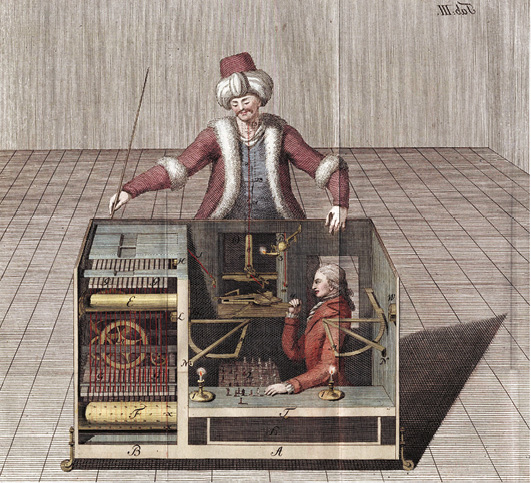
Illustration from Joseph Racknitz’s About the Chessplayer of Mr. von Kempelen and its Replica [Über den Schachspieler des Herrn von Kempelen und dessen Nachbildung], 1789. (Public domain)
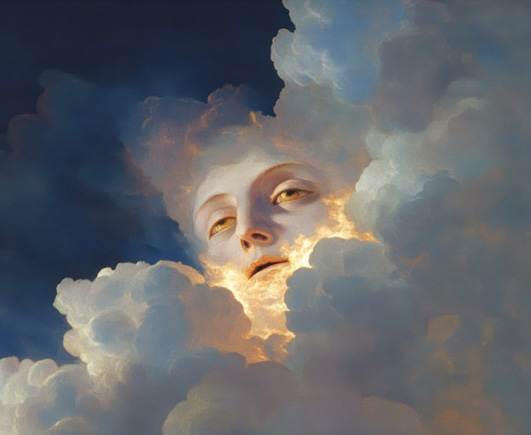
Keke, Golden Breath, (i) Acrylic and oil on linen; 19 7/10 x 23⅗ in (50 × 60 cm). Executed in 2025 (ii) JPEG; 8,000 x 6,613 pixels, minted on 4 February 2025. ©Keke
The “ghost” in the machine is the servant mentioned earlier. It is by asserting the machine as being greatly informed by its own essential function that the art produced with its service can be acknowledged. We are pushing the machines in the subsumption of higher creative skills and, based on the amount of art produced with AI, the future behaviours of this trend in art can become transparent. By processing vast quantities of data, algorithms can detect patterns and develop mannerism: so-called autonomous AI artists such as the Christie’s recently auctioned Keke, is an example of how agents vacillate between artistic genres and visual cliches. Generally, just like the case of the “prophetic” art, the language produced is in most cases recognisable as drawn from a universal visual source.
However, this service that AI is providing is not about fulfilling artistic expectations but about exceeding them and creating a whole new category. In this new theological era of servant leadership, AI represents a channel through which the message proceeds outward into manifestation. The contemporary development of the pre-Renaissance transformation mentioned before is asking for a critical reflection on the ways in which AI reconfigures authenticity and understanding of an image not simply as a static artefact but as a vital, co-constructed entity in the nexus of human and machine interaction, as well as its service in the realm of faith.
Going back to the prophetic side of service, as the divine transmission of knowledge that transcends human understanding, AI derives its predictive capacity from pattern recognition, and probabilistic models. Yet, both prophecy and AI operate with a shared ontological purpose: to illuminate the future, to be servants and offer guidance in the face of uncertainty, and, in art, to influence the course of visual events. In prophecy, this is often framed as a revelation of a higher, metaphysical truth, while in AI, it is seen as an extrapolation from empirical data and systemic logic. In both instances, we encounter two forms of service: one rooted in the metaphysical and spiritual, the other in the computational and empirical. Ultimately, both the prophetic vision and the AI model emerge as forms of serving knowledge that seek to give an insight into what lies ahead, navigating the terrain between the visible and the invisible.
The real iconic turn today would be the lack of options, or the reduction of potential forms and languages to a limited set of abstract possibilities. Contemporary art is both served and a servant at the same time. In the face of this new turn which is lavishly funded by the appeal and velocity of creating with AI, we need to consider new politics of visibility: a project which marries the mathematical sublime with the vastness of the spiritual, while it tries to reassert power over the possibility.
Footnotes
1 Martin Kern, “Early Chinese literature, Beginnings through Western Han.”
2 Excerpt from Prophetic art: 3 artists discuss what it means to deliver a message from the Father, interview conducted by Justine Ocampo with three artists that perform prophetic live painting on stage during mass at churches in Singapore.
3 Gombrich, Aby Warburg: An Intellectual Biography.
4 Belting, Likeness and Presence.
5 Pennington, Socher, and Manning, “Glove: Global Vectors for Word Representation.” Presentation text within Conference on Empirical Methods in Natural Language Processing (EMNLP) (2014).
6 Haraway, Situated Knowledges.
7 John Stuart Mill, Of the Composition of Causes.
8 Pierre Gassendi in William Bechtel, Philosophy of Mind: An Overview for Cognitive Science.
9 Ryle, The Concept of Mind.
References
Bechtel, William. Philosophy of Mind: An Overview for Cognitive Science. Tutorial Essays in Cognitive Science, Routledge, 1988.
Belting, Hans. Likeness and Presence. A History of the Image before the Era of Art. CH Beck Munich, 1990.
Gombrich, Ernst Hans. Aby Warburg: An Intellectual Biography. Phaidon, 1986.
Haraway, Donna. Situated Knowledges: The Science Question in Feminism and the Privilege of Partial Perspective, Feminist Studies 14, no. 3 (1988): 575.
Kern, Martin. “Early Chinese literature, Beginnings through Western Han.” In Stephen Owen (ed.), The Cambridge History of Chinese Literature, Volume 1: To 1375. Cambridge University Press, 2010, pp. 1–115.
Mill, John Stuart. Of the Composition of Causes, Chapter VI of System of Logic. Full title: System of Logic, Ratiocinative and Inductive; Being a Connected View of The Principles of Evidence and the Methods of Scientific Investigation. New York: Harper and Brothers Publishers, 1859. Made available in digital format by the Institute for the Study of Nature in 2008 on www.isnature.org
Ocampo, Justine. “Prophetic art: 3 artists discuss what it means to deliver a message from the Father.” Thir.st. https://thirst.sg/what-is-prophetic-art-worship-painting/. Accessed on 19 May 2025.
Pennington, Jeffrey, Richard Socher, and Christopher Manning, “Glove: Global Vectors for Word Representation.” Conference on Empirical Methods in Natural Language Processing (EMNLP) (2014).
Ryle, Gilbert. The Concept of Mind. University of Chicago Press, 2000.
Essays
Service—“Don’t Teach Art”
“The best thing about sculpture is that it doesn’t necessarily have to have a right way up; it also doesn’t necessarily have to have an idea in order for it to come into existence; also it doesn’t have to have a subject in fact, it doesn’t have to have a lot of things so why bother?
I mean, why bother to make sculpture? the world is already full of stuff, natural and human-made, useful and useless, so why add to this?
Unlike the question for which mountaineers have a ready answer—why climb that mountain? Answer: because it’s there. Sculpture is the opposite; why make? Answer: because there is nothing there.”
— Phyllida Barlow, from her essay in Folds in the Field:
Essays in Honour of Anthony Caro (2012)
It was in April 2017 in Venice when Tang Da Wu pointed me toward the British Pavilion at the 57th Venice Biennale (La Biennale di Venezia), where Phyllida Barlow was exhibiting. This was typical of Tang—always pointing toward artists, always sharing his keen observations. His enthusiasm for art, and for the work of others, was as generous as it was infectious.
When we met in London, we saw countless exhibitions together—Caravaggio and his peers at a private collection gallery, Wolfgang Tillmans’ solo show at the Serpentine, a fleeting glimpse of an Antony Caro sculpture being installed through a rooftop window. We visited student graduation shows, wandered through emerging practices, Tang always holding onto a notebook and exclaiming that he has learnt something new—an epiphany for the day! For Tang, the act of looking was never passive—it was a form of care, of deep listening, of discovering new things. It was part of his ethos as an artist-educator, as a lifelong student of art and its possibilities.
In Venice, he told me that Barlow was one of the great art teachers of her generation. He spoke of her students—Rachel Whiteread, Tacita Dean, Steven Pippin amongst many accomplished artists—with quiet reverence. That moment stayed with me. It offered a way to think about this essay—not just as a reflection on Barlow, but as an exploration of the connections between artists and educators born of the same era, shaped by the same cultural forces: both Tang and Barlow lived and worked in London for much of their lives. Both were influenced by the punk spirit of resistance, by the austerity and tensions of the Thatcher years. As an entry point into this essay, I’m drawn to the role of art—and especially of art teachers—as a kind of beacon for perseverance through times of unrest and uncertainty. Through Tang’s words, Barlow emerged not only as an artist, but as someone who had lived a life in service—to her students, to the often-invisible labour of mentorship, to the long arc of artistic dialogue and guidance.
This idea of service—quiet, enduring, and deeply human—led me to a larger question, one that feels especially urgent now. In an era where knowledge, particularly in the arts, is increasingly commodified, we are prompted to ask: what does it truly mean to serve as an art educator? Art education is not simply the teaching of technique, nor is it about transmitting fixed modes of thought. Rather, it demands presence, empathy, and an ethical commitment to nurturing artistic inquiry. The work lies not in providing answers, but in supporting a critical, open-ended process—helping students to navigate uncertainty, complexity, and contradiction.
To teach art is to embrace experimentation and ambiguity. It is to foster discovery, not dictate outcomes. It is to make space—for risk, for failure, for reflection. It is to help students develop their own capacity to ask questions through material and form.
This kind of service extends far beyond the confines of the studio or classroom. Art educators today must navigate the tensions between institutional expectations, creative autonomy, and the broader social role of art. They are not only equipping students with the skills to make and think—they are fostering resilience, agency, and artistic consciousness. And yet, we must ask: is this work truly recognised for what it is? Or is art education still too often dismissed as marginal, ancillary, or “non-essential”? The dissonance between its societal value and its institutional standing invites critical reflection on how we support and sustain the work of art educators.
What remains clear is that those who teach art are not merely instructors—they are facilitators of voice, provocateurs of thought, and stewards of imagination. Their work, though often under-acknowledged, is central to shaping the conditions in which art can flourish.
We return, then, to Phyllida Barlow. A remarkable artist, yes—but just as importantly, a remarkable teacher. Her pedagogical approach championed experimentation, criticality, and material intuition over convention. She herself had been shaped by her teacher, George Fullard, who encouraged her to break from formal sculptural traditions and embrace everyday, salvaged materials. For more than fifty years, Barlow created works that were imposing yet playful, emotionally charged yet physically fragile. Her sculptures bore the marks of process—visible joins, uneven surfaces, unpolished edges—honouring the labour of making and the beauty of incompletion.
Barlow’s approach reminds us of the unique potential of art education to cultivate ambiguity, rather than eliminate it. Re-thinking the audiences, the publics or ignoring them, and not apologetically so. Over-explaining art risks diminishing its power; when interpretation becomes fixed, something essential is lost—its capacity to provoke, to unsettle, to open. Her work invited viewers to engage on their own terms, to dwell in uncertainty, and to feel their way through a work rather than solve it. In this way, she modelled an art education rooted not in answers but in sensation, intuition, and dialogue.
While critical analysis is important, it should not overshadow the embodied and affective dimensions of artistic experience. Art can stir joy, grief, wonder, and resistance. It can mirror our contradictions. An art education that acknowledges this—one that embraces intuition alongside critical thought—can cultivate more than just technical skill; it fosters an awareness of complexity, an attunement to process, and a deeper sense of the self in relation to the world.
In this light, Barlow’s legacy is not only visible in her sculptures, but in the students or artists she nurtured, and the pedagogical spaces she helped shape. Her life in art was a life of service—quiet, generous, and radical in its refusal to separate making from teaching.
In parallel, I had the opportunity to interview Tang Da Wu a couple of times over the years and more intently for this essay in February 2025. With his recent works for the past decade, he paid tribute to the many figures in Singapore who have played key roles in shaping art education: Chng Seok Tin2 and the institutional legacies of Lim Hak Tai, Brother Joseph McNally3 and more recently, he highlighted a deep respect for the theatre practitioner and educator T. Sasitharan of Intercultural Theatre Institute (ITI). Each of them, in their own ways, represent a commitment to art education as a space of resilience, risk-taking, and care.
Yet still, we return to the question: how should art education be approached?
Perhaps, the most crucial stance we can adopt is one of resistance – resisting the urge to over-define, to categorise, to confine the boundless potential of art. Art thrives on ambiguity, on the open-endedness that allows for multiple interpretations and evolving understandings. By preserving this ambiguity in how we approach and teach art, we safeguard its vital capacity to challenge our assumptions, inspire new ways of seeing, and ultimately transform our understanding of ourselves and the world around us. Its inherent uncertainty is not a flaw to be rectified, but rather a fundamental condition of its enduring vitality and power. The unbound form of art, in its refusal to be defined, remains a potent force for exploration and discovery.
This ethos is deeply embedded in Tang’s own practice, which merges provocation, social critique, and poetic gesture. His work has consistently questioned dominant narratives—not only in content, but through form, process, and in the ways art might be taught and shared. His Sculpture Seminar series at the then-National Museum Art Gallery (NMAG) Singapore in the late 1980s was one such experiment in alternative pedagogy, reimagining how art education could function beyond the classroom. In 1995, during a period of increased state control over performance art, Tang responded with the quietly subversive work Don’t Give Money to the Arts—a disarming protest wrapped in irony. More recently, exhibitions such as 3,4, 5, I Do Not Like Fine Art, Reminder – I Don’t Do Exhibitions, Art School SG: Artists See Colours Differently, and This One is Dangerous continue to challenge conventions of artistic presentation and challenge the institutional frameworks that surround and contain art.4
In February this year, I spoke with Tang about his philosophy of art education. His reflections were intimate and vulnerable:
Tang sees the artist not as someone who declares, “I am making art,” but as someone who begins with uncertainty: I work because I do not know. In this view, art—and by extension, art education—is not about mastery, but process. Doubt becomes material. Vulnerability becomes method.5
“My works are evidence of my thoughts. My works are evidence of my doubts.”
This is the true generosity of the artist-educator, who would prefer to be fore-fronted as an educator: not only to share what they know, but also what they don’t. To teach not certainty, but the courage to persist in unknowing.
Tang views art education as a space of possibility—where form and content are in constant flux, where teaching and making are inseparable, and where ambiguity is not something to be resolved, but held. Even cherished.
In an era obsessed with outcomes—rubrics, metrics, measurable success—how might educators resist this pressure, quietly but deliberately? Perhaps the answer lies in embracing the slow, the unresolved, the not-yet-formed. To centre process over product is not to reject rigour, but to redefine it. It is to honour a kind of learning that resists quantification: the intuitive leap, the hesitant pause, the shift in perspective that might not appear on paper but changes everything.
This quiet resistance is an act of care. It involves creating space for students to dwell in uncertainty without fear of failure; to stay inside the messy middle of making, where clarity hasn’t yet arrived. It’s in the decision not to over-structure, not to over-direct, but to trust that something meaningful can emerge from ambiguity. It’s in offering feedback that deepens inquiry rather than closes it off. It’s in protecting the studio as a space of slowness, doubt, and idiosyncrasy.
To teach art in this way is to make a subtle but radical claim: that the worth of learning cannot always be seen, measured, or pinned to a timeline. That the most important transformations are often internal, incremental, and provisional. It is to insist—that art education is not a performance, but a practice. In conversation, Tang did not speak with certainty, but with a quiet clarity that could only be plausible with years of sitting with doubt, reflection, toil, worry and discomfort. What follows is an excerpt from our conversation on 4 February 2025, where more of his worldview unfolded:
I have many problems of my own.
I work in outside spaces. I clean up after.
And I accept these as my circumstances, my life.
So I pack up my mess after I have worked.
I do not work for exhibitions.
I am ready for a show anytime.
My works are evidence of my thoughts.
My works are evidence of my doubts.
I clarify them as I work.
I said: I need to teach myself first. Only then can I share what I’ve learned.
Why do parents teach their children?
I once saw two white mice wandering the streets at midday, in the heat. I thought: their parents must be dead. If their parents were alive, they wouldn’t have let them wander like this.
Education starts from home.
There’s an old saying: do not do to others what you do not want done to you.
How to cultivate motivation via education. And how to do that? First, don’t smother it with rules. Allow space.
Critical thinking and motivation go hand in hand. When students question your teaching—even express doubt—it isn’t a sign of disrespect. It’s a sign that they’re engaged. That’s motivation.
Freedom.
What stifles it?
Fear.
Too many rules. The silencing of questions.
A constant pressure to obey without understanding.
When inquiry is replaced by instruction, and curiosity is met with control, freedom begins to fade.
Students retreat—not because they lack ability, but because the space to explore has been closed off.
There’s something powerful when a student learns something on their own. When learning is paired with discovery, motivation follows. It becomes self-sustaining.
In art school, the “how to” matters. How to draw a figure. How to ask questions. How not to rob students of their critical freedom. The teacher’s role is to give space—to protect, not to prescribe.
When I was at St. Martin’s, my tutor Barry Flanagan gave me space. He encouraged me in a quiet but special way. He simply said, “You’re talented.” That was enough. He never prescribed how to make work. He gave me room to decide.
Artists are craftsmen. Through the act of making, they refine not only their skills but their thinking. The hands lead the mind. Ideas emerge through process, through repetition, through doubt. And then—often unexpectedly—the craft meets the right moment: a shift in context, a change in time, an encounter with an audience. That convergence is when it becomes art. What do I mean by “the right moment”? It could be an audience, a critic, a shift in time, or personal maturity. These are the conditions that allow work to transform into art.
At the beginning, we don’t say, “I’m making art.” We say: I work because I do not know. Craft comes first. Understanding comes later—if it comes at all.
Even now, speaking to you, I know I can contradict myself. I say things I believe deeply. I also say things I’m still working through. But that’s how art works. It’s born from uncertainty. That uncertainty is necessary—and beautiful.
Sometimes you lose an argument. You “lose face.” But even that is a gift. There is value in being wrong, in being open.
So, how is art school different? A good professor might say, “I don’t know what art is.” And that’s not ironic—it’s honest. It reflects the nature of art itself: shifting, subjective, unresolved. An art professor does not hold all the answers. In fact, they shouldn’t. Their role is not to define what art is, but to create a space where students can ask their own questions and explore what art might be for them. That space—rooted in uncertainty rather than instruction—is where learning begins. Not with certainty, but with permission to search.
Hans Ulrich Obrist once said he wanted to borrow something I said: Do not make art. Make questions. That resonated with him. Art is not an answer—it’s a question.
A thesis, by definition, seeks to conclude—it aims to resolve, to summarise, to produce a finished product. But art resists that. A thesis is not art. Its very structure—designed to reach an endpoint—runs counter to the ongoing, uncertain, and unresolved nature of art.
For instance, a student had recently asked me to critique his completed work. Because it had reached its completeness, perfect. I have nothing to say. What could I say? There’s no room for me to add anything. I merely pointed him to my previous statement that I uphold truly: Do not make art, make questions.
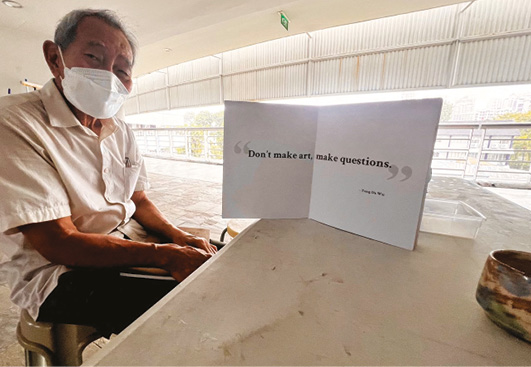
Tang Da Wu showing a fold-out of his catalogue from a previous exhibition at Nanyang Academy of Fine Art displaying the words “Don’t Make Art, Make Questions.” 2025. Photo by Tamares Goh.
Similarly, in 1971, I casted a bronze cup. It was solid and full. When a cup is full, no other knowledge can enter. It becomes a useless cup; redundant.

Untitled (Bronze Cup Cast—Cup from School Canteen in Birmingham School of Art). 1971.
Contact print. Photo by Tang Da Wu. Courtesy of the artist.
Artists learn from other artists. They admire them. Some might call it copying—but it’s not. It’s a form of acknowledgement. It’s how knowledge travels.
Picasso’s Guernica is one of the most powerful anti-war works of the 20th century. Pictorially, it can be traced to the past. You can trace the lineage from Delacroix’s Liberty Leading the People, you can see Salvador Dali’s influence in the work, you can see the influence of the Soviet filmmaker Sergei Parajanov, proof of ideas and inspiration passing from peers to another generation—art honours those who came before. Diego Velázquez’s Las Meninas inspired Picasso to make many paintings. And Picasso learnt indirectly from Cezanne for instance. Velázquez has alone inspired many generations of artists.6
This is why art history matters—learning from others. Today, we can access anything online, instantly. But the internet is overwhelming. But if we have little time and can only focus on some key moments—I’d say study those born from movements stemmed from revolutions:
In 1968, students took to the streets. From this unrest emerged the Situationist movement. A culture rose up—art, fashion, Punk, politics—all bleeding into daily life, from office spaces to sidewalks. Evasive. Transformative.
In the U.S., there was Fluxus, started by George Maciunas, 1961. Fluxus was not a style, but a spirit. It encouraged artists to question everything. It blurred disciplines. Artists like John Cage, Nam June Paik, Yoko Ono, Andy Warhol alongside many great artists, carried that questioning forward.
Art is already out there. Robert Rauschenberg once said that art exists in everyday life. Artists don’t create it from nothing—they find it. I’m not sure what to make of the word “creative”. To create suggests making something out of nothing. But I believe art is already out there, waiting to be noticed. What I do is simply introduce that art to others—to my friends, to those who might not have seen it yet. It’s the same with Wolfgang Laib’s work—his use of yellow pollen, or milk on stone: Milkstone, 1978. Beautiful, quiet gestures that reveal something already present in the world.
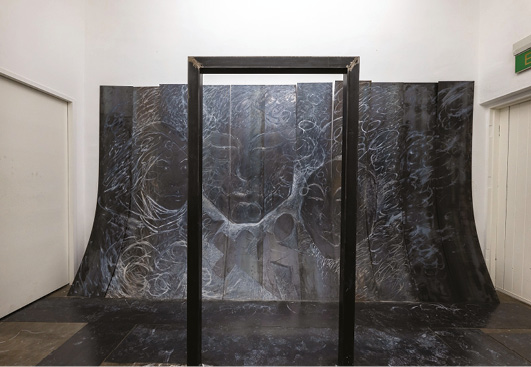
Cunxin Cuntie Cunxin at Comma Space. 2021. Photograph. Photo by Ken Cheong. Courtesy of Comma Space.
Education often happens in unexpected ways. Sometimes an epiphany that someone, somehow, has taught us something, even if indirectly. That’s why it’s not absurd to say that Caravaggio was our photography teacher—I found myself thinking to myself: Caravaggio was already teaching photography back in 1557—long before the word “photography” existed, or the camera was invented. He understood light and shadow, reflection and perspective. He explored composition, contrast, and focus—concepts that are central to photography today. His work continues to teach us how to look.
I think artists have a special sensitivity—a gift.
They’re able to draw out what others might overlook.
They move something from an unconscious state into awareness.
From something hidden, to something seen.
And before all of this—there was Dada.
Marcel Duchamp’s act of putting the urinal, Fountain, in a gallery space, he did not say that the urinal is art. He merely asked the question—can this be art?
Dada is not dead.
In 2025, it is still very much alive.
Dada was, and remains, anti-art.
And anti-art is generative.
Anti-art is found space.
That space is beautiful.
Anti-art is futurist thinking.
I believe modern art didn’t begin at the turn of the 20th century, but earlier—around 1850, with realism. Artists were told: paint the world as it is. Gustave Courbet once said, “If you show me an angel, I’ll paint one.” That marked a shift. Although that said, hyperrealists shunned away from mythology and mythmaking, and totally abolishing myths is not a good thing – myths give rise to imagination, and imagination stems from myths. Myths and real life, they are co-existing.
In my recent work—and in the way I’ve been thinking—you might notice the presence of skylight in my drawings. It’s my way of expressing that while I live on Earth, Earth is not the only world. The skylight isn’t just about clouds or atmosphere; it’s a window into the cosmos, into something far larger and infinite. Through that window, I feel as though I’m having a quiet, ongoing conversation with the universe.
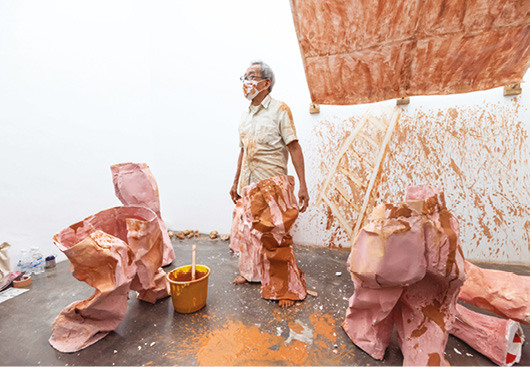
Detail of Performance In Broad Daylight, I Do by Tang Da Wu at Comma Space. 2024. Photograph. Photo by Wang Ruobing. Courtesy of Comma Space.
Dreams are another important element for me. They return often, like reminders—messages from somewhere beyond the conscious mind.
In this same body of work, I’ve also been painting mangrove swamps—the trees and their roots. To me, they hold a similar weight to van Gogh’s sunflowers. They represent a turning toward Nature, a reverence for its presence and its teachings. Nature has always been there—quietly guiding, patiently offering lessons.
I look at the mangrove trees and wish I had their character. To me, they are like gods. They filter the waters, support life, hold ecosystems together. They reach for the sunlight while grounding themselves deeply in the muddy openings of rivers. I am learning from them.
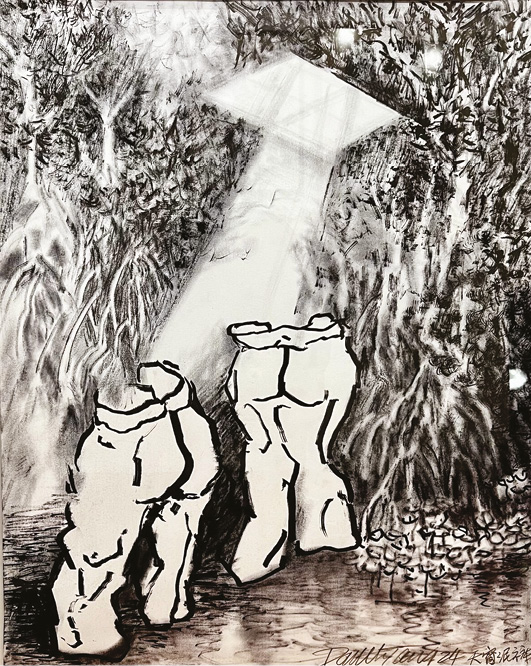
Detail of Tian Chuang Ni Ku. 2025. Photograph. Photo by Tang Da Wu.
Courtesy of the artist.
And if that’s not education, what is? Learning from Nature, and teaching myself through that relationship, is education. To cultivate this kind of learning within ourselves before we can truly teach others.
When it comes to teaching or sharing, my attitude is simple: never lecture. Instead, meet other artists. Listen to how they think, observe how they work. Visit museums. Learn by encountering, by experiencing. There is no single method, no fixed style. Each encounter is its own kind of lesson.
Conclusion
Teaching art the way Tang advocates makes a quiet yet firm statement: the true value of learning cannot always be confined by rigid timelines or fixed outcomes. The most meaningful growth is often internal and reflexive—flourishing in the open spaces of ambiguity and process. Tang’s approach unsettles conventions, introducing discomfort and uncertainty, and creating room for new perspectives to emerge—both in viewers and in the wider cultural conversation. His work is not just a personal reflection but an ongoing dialogue—within himself and with the world. It challenges us to take responsibility for crafting a more equitable and compassionate future—one where doubt is welcomed, and vulnerability is seen not as a weakness but as a strength that engenders care.
Teaching and making in this way become acts of service. To hold space for uncertainty, to prioritise process over product, and to invite rather than instruct—these are gestures of generosity. Tang believes that the most important lessons are not those that offer definitive answers, but those that spark ongoing questions and personal discoveries. As he puts it, “I work because I do not know,” and it is this humility—this service to inquiry rather than mastery—that forms the bedrock of his teaching philosophy.
His idea of “making work for future generations to do” reflects a belief in the enduring power of open-endedness. In a world where resolutions often feel elusive and to be able to leave space for others to continue the dialogue is a gift—an offering of continuity, a service to time itself. By creating work that remains unresolved, that raises more questions than it answers, we entrust future generations with the challenge of uncovering new meanings, forging fresh paths, and defining their own ways forward. In this way, art becomes a living process—a shared space that nurtures resilience, deepens collective thought, and honours the unknown.
This ethos resonates with Phyllida Barlow’s reflection on sculpture in the opening quote: “...why bother? Sculpture answers the question ‘Why make?’ because there is nothing there.” Much like Barlow’s sculpture, Tang’s art emerges from absence—not to fill it with certainty, but to offer a space where something new might take root. It does not impose meaning but invites it. And in that invitation lies a quiet provision: to others, to the present, and to futures we may never see.
Perhaps this is the deeper rhetoric Tang proposes—not a declaration, but a provocation: What would it mean to create not for gratification, but for continuity? Not to conclude, but to leave space? Not to teach answers, but to teach the courage to keep asking? In this way, his work becomes not just art, but an enduring form of concern—one that questions, sustains, and listens.
Footnotes
1 This title is extracted from an exhibition proposal by Tang Da Wu. The full exhibition title is The Seminar —Don’t Teach Art, and it is planned to run from 7 September 2025 to 1 February 2026 at Jendela, The Esplanade, Theatres on the Bay, Singapore.
2 Chng Seok Tin (1946–2019) was a prominent Singaporean artist and educator, best known for her contributions to printmaking. A friend of Tang Da Wu, Chng played a significant role in shaping the local art scene through both her artistic practice and her dedication to teaching. Her works often reflected deeply personal and philosophical themes, and she remained an active and influential figure in the arts despite losing her sight later in life. As an educator, she inspired generations of young artists, leaving behind a lasting legacy in Singapore’s visual arts landscape. In my (unpublished) interview with Tang in 2020, he said: “If you look at Seok Tin, she did not waste her life at all. Her life is compact. She is a source of inspiration. I want to use her as a case study for my students.” Subsequently, Tang continued to pay tribute to her—and to artists Juliana Yasin and Lee Wen—in the exhibition Cunxin Cuntie Cunxin at Comma Space, Singapore, in January 2021.
3 Tang has also paid tribute to the founders of art schools, Lim Hak Tai and Brother Joseph McNally, in various exhibitions, as documented in the catalogue On This Stone, We Will Build An Art School, published by the Nanyang Academy of Fine Arts in 2021. The inspiration stemmed from a stone Tang found in the greenery near the late Brother McNally’s former art studio, which once housed the school he founded, LASALLE College of the Arts, at Goodman Road. Another stone, carved by Tang, bears the inscription DE ESTA PIEDRA CONSTRUIMOS UNA IGLESIA—“With this stone, we build a church.” A third stone, also created by Tang, accompanies the second and reads Y UNA ESCUELA DE ARTE—“And an art school.” The work Brother’s Pool serves as a sentimental tribute to McNally’s legacy: from humble beginnings, he went on to build an altar, then a church, a community, and finally, an art school—what is today LASALLE College of the Arts.
4 Exhibitions mentioned here from 2022 to 2025 include: 3, 4, 5, I Don’t Like Fine Art at ShanghART Gallery in 2023; Reminder—I Don’t Do Exhibitions in December 2024; Art School SG: Artists See Colours Differently; and This One is Dangerous, which reflects Tang’s ongoing engagement with and critique of art education.
5 In my (unpublished) interview with Tang Da Wu in 2020 at Goodman Arts Centre, he remarked that he still does not consider himself an artist: “I did not become an artist (yet). My interest is art education—I find it very rewarding.”
6 Similarly, Tang has paid homage to many artists. Liberty Leading the People by Eugène Delacroix was a recurring reference in his teachings and artwork—one notable example featured in the exhibition Situationist Bon-Gun by Tang at the Institute of Contemporary Arts, LASALLE College of the Arts, in March 2013.
References
Chng, Seok Tin. “The Life of Tang Da Wu.” Earth Work, 1979, edited by Charmaine Toh, National Gallery Singapore, 2016.
Dexter, Emma. Façade. folly, Black Dog Publishing Limited, 2017.
Godfrey, Mark. “Phyllida Barlow Examines the Art of Teaching.” Frieze, 2026, https://www.frieze.com/article/art-schools-phyllida-barlow.
Goh, Tamares. “Nurturing The Future.” On This Stone, We Will Build An Art School, edited by Sarah Ng, Nanyang Academy of Fine Arts, 2020.
Goh, Tamares. “Working Together: In Conversation with Tang Da Wu.” Earth Work, 1979, edited by Charmaine Toh, National Gallery Singapore, 2016.
Harrison, Sara. Phyllida Barlow: Collected Lectures, Writings and Interviews. Edited by Michaela Unterdorfer, Hauser & Wirth Publishers, 2021. (Text copyright Phyllida Barlow, courtesy Hauser & Wirth).
Wang, Ruobing. “Cunxin, Cuntie, Cunxin.” Comma Space, 2021, https://comma-space.com/cunxin-cuntie-cunxin/.
Wang, Ruobing. “Tang Da Wu.” Comma Space, 2021, https://comma-space.com/tang-da-wu/.
Essays
What should sociologists and anthropologists do with the contemporary visual artists who tend to transcend manifold boundaries in their art practices? Societal construction of boundaries and markers of identity has been central in the research and academic writings. Such disciplinary boundaries are commonplace in various branches of the modern social sciences. Transcendence of the markers of boundaries have been equally significant. Interpretations of rituals, performances, and sociocultural processes in society led anthropologists to understand the social urges for structure and anti-structure.1 The creative social paradox, that is, constituting boundaries and then aspiring to transcend them, remained a thematic preoccupation for social scientists of the modern societies. When the same issues unfold in the world of artists, in their art practices, why should that not be a focus of discussion in sociology and anthropology?
The essay is broadly structured in three sections: the sociological imperatives; Navjot Altaf’s subjectivities; and a conceptual axis of service-in-collaboration. The overlapping of the three sections that occur with ample reiterations across the essay is almost a heuristic device to lay emphasis on the central concerns. One perpetual concern is to curate a transcendence of the disciplinary hesitations in sociology and social anthropology to engage with the art practices. In so doing the essay centres on an eclectically chosen part from the oeuvre of an established contemporary visual artist from India, namely Navjot Altaf. This is towards serving the need of comprehending the nuances of collaboration and service thereof, another perpetual concern in this essay. In engaging with the collaborative artworks in the instance of the art practice of Navjot Altaf, this essay shall seek to do what one rare sociologist named Radhakamal Mukerjee advocated at the advent of sociology in post-independent India. He underlined the intertwined nature of art and social structure, paving the way to understand the social functions of art. This reminder is significant after over half a century, when sociologists and anthropologists tend to be either unsure about the world of art and artists or, reduce them to mere ornamental objects of analyses. There is a larger corpus of relationship between art, art practices, artists’ subjectivity, and society. This essay unravels such a conjoined nature of art and society, drawing in Navjot Altaf’s oeuvre as a specific instance.
Premise
A reknowned and significant artist in postcolonial Indian art history, Navjot Altaf has been practicing and producing for nearly five decades.
Her works comprise paintings, sculptures, installations, videos and various site-specific creations. There is a commendable methodological broadness in her art practice that has taken her to various dialogic collaboration with artists of indigenous origin from Chhattisgarh in Central India, intellectuals and filmmakers, academics and activists. Through these collaborations, her work speaks expansively and sensitively about the sociopolitical conditions of the world we find ourselves in, causing us to reflect on the internal and external conflicts. She is interested in understanding the significance of transdisciplinary work, whose nature is not merely to cross disciplinary boundaries but to transcend social boundaries too, particularly through collaboration. Collaboration is not merely a technical word, or a mutual interest-based coming together of the artists, activists, and artisan communities for a short-term goal. Instead, in the collaborative works of Navjot Altaf there is ample evidence of what the French sociologist Emile Durkheim discussed as organic solidarity.
Durkheim was keen to understand the emergence of social interdependence among variously skilled workforce in a modern industrial society. Unlike seeing each individual expert in isolation there was an imperative to comprehend the relationship of interdependence among the experts. He coined the phrase organic solidarity for interdependence in modern society, as opposed to mechanical solidarity that prevailed in the primitive society. Unlike mechanical solidarity, those in organic solidarity ought to be more aware of the different skills and the fact that one social group cannot live without conscious interdependence with the other. The bridge between self and other, familiar and not-so-familiar was crucial for the sustenance of the modern industrial society. A notion of service without rhetoric, a relational configuration of serving one another, is embedded in Durkheim’s discussion on the division of labour in modern society. In spite of the criticism of the positivist determination of Durkheim’s sociological approaches to social relations, particularly of organic solidarity,2 the formulation tends to lend a more nuanced understanding of service in the acts of collaboration. The social embeddedness of service-in-collaboration underlines not only the organic nature but also a social longevity. In such a service-in- collaboration the personal and political, intellectual and emotional seamlessly intermingle. There is no need of an official, formal, bureaucratic and technocratic determination in such a service. Instead, as this essay dealing with the sociological nuances in the collaborative practices of Navjot Altaf shall show, there is a sense of organicism, in which personal and political, artistic and emotional, objective and subjective merge.
On this note it ought to be stated that Durkheim does not elaborate on the co-existence of personal and political in the conceptual formulation of organic solidarity. Much later the American sociologist C. Wright Mills cantered the relationship between personal and public, biography and history, at the core of sociological imagination. This was meant to educate and sensitise sociological methodological approaches and ways of seeing. Rather than venting any slogan Mills was keen to underline the presence of personal issues in a public enactment such as politics. Everything that may appear ordinary and redundant to the orthodox sociology indeed plays an integral role in the performance of politics. In Navjot Altaf’s artworks and practices we comprehend the relations of the personal and the political. Therefore, her art is evidently political. The idea of political art necessitates a return to Rancière, a key proponent of alternative Marxism. Rancière departed from structural Marxism after 1968, a significant break from the presiding structuralist Marxist thinkers of the time such as Louis Althusser and Étienne Balibar.
Such a critical break, as highlighted in this essay, is visible in the art practice and works of Navjot Altaf. Here, Rancière’s preoccupation with the politics of aesthetics in the decade of the 1990s is worth a quick mention. The sensible, that is, the sense-perceptions, constitute social order. Rancière critically deemed the social order akin to police order. This order determines the nature of art politics of an artist’s participation in the art and aesthetics. The politics lies in the distribution of the sensible, inclusion and exclusion. The art politics determines the visible and invisible, the sayable and unsayable, the audible and inaudible. Rancière was however optimistic about the politics of aesthetics that upsets the social order. There is always a possibility of another regime of art which will challenge the social order. Without defining them in linear terms, he proposes three such regimes: ethical regime, representation regime and aesthetic regime. Each regime tends to provide a sensorial order, a way of seeing and doing, and an overall gradation of the sensible. Each regime also tends to have its values; for example, ethical regime will emphasise the idea of ‘true’ art in an essentialist sense; whereas representation regime is least inclined to the vague ethical idealism, and gives birth to a hierarchy of arts, forms and subject matter. Unlike these regimes of art, the aesthetic regime brings about a breakdown of hierarchy invoking a redistribution of sensibility. The boundaries between genres also tend to dim as art acquires an autonomy in which disparate forms and genres come together.
The political as a qualifier of Navjot Altaf’s works and practices is of this nature, in which there is an endeavour towards an aesthetic regime of art, alongside ethical and representational regime. And following C. W. Mills, the political is not bereft of the personal, just like there is no disjunct between biographical and historical. Such epistemological combination aids in understanding the distinctions of service-in-collaboration in Navjot Altaf’s work.
Subjectivity of Navjot Altaf
One often refers to the Curriculum Vitae (CV) when asking ‘Who is the artist?’ The CV approach to an artist is useful for a quick understanding about their affiliations and achievements. But there is also a thick narrative buried in a CV that alludes to the formation of an artist’s subjectivity. Consequently, the key question is not ‘who is Navjot Altaf?’; instead it is ‘what is the artist’s subjectivity?’ The second question solicits an interpretative rather than a CV-based approach to an artist. To answer the question, what follows will seek and consider a few key instances from a publication by The Guild3 titled Artist’s Notes, in which Navjot’s body of works appears and which will aid to comprehend what shapes the ways of seeing of the artist.

Artist’s Notes
Credit: Navjot Altaf
Navjot acknowledged that her mentors, the internationally acclaimed artists such as Akbar Padamsee and Tyeb Mehta, exposed her to the readings on aesthetics and anti-aesthetics. This was an advent of the inclination to broaden the discourse that envisions arts as liberated from the conventions of aesthetics. This would include Navjot’s perpetual dialogic relation with the rest of the world of art and activism, academics and politics, civil society and communities. She engaged and incorporated the ideas and insights into visual art, interacting with theorists, feminists, lawyers, filmmakers, scientists, musicians, environmentalists, psychoanalysts and so on. Art and life became conjoined twins, nourishing each other. This also meant that she navigated the landscapes of cities and beyond, in dialogic relationship. Navjot noted the objective of such navigation as she aspired, “to breathe the same air and take in the same sights, and in so doing, blurring the division separating art from life.”4 As a result, a unique framework of collaboration with a sense of organicism arises. The distance between the self of the artist and that of the ‘other’ tends to get minimal in the collaborative framework of Navjot. The ‘other’ was an oriental construction for many anthropologists of the 20th century in response to the colonial regime of power.5 The oriental other was a source of awe and horror that anthropologists sought to document, and the state aimed to control. An artist such as Navjot was inclined to collaborate with the communities to remove the orientalist impositions.
The indigenous community, that is experientially distant from the city-dwelling artists, is an integral part of the artworks and art practices of Navjot. And how is it accomplished? A deep sense of empathy, something that may appear as a technical Verstehen for a sociologist following Max Weber6, is also central in Navjot. However, there is a qualitative difference. A sociologist may employ Verstehen without sufficient immersion in the social and political context of a community. Whereas, in Navjot’s practice empathy and understanding arises from a deep praxiological commitment. Although Weber’s sociology centralises the interpretative acts of understanding the social action, it did not acknowledge the divide between what we learn and what we practice. Praxis, as a Marxist thinker such as Antonio Gramsci7 had discussed, was a tool to aid in understanding the divide between theory and practice, and then accordingly, carry out actions which aim at the transformation of the world. Navjot’s subjectivity is characterised by such a praxiological understanding of the world in which theory and practice are intertwined. As a result, Navjot’s art practices could add more nuances to the technical usage of Verstehen.
She does not only work with the members from the communities. She tends to dwell in the same context as the communities with which she collaborates. In engagement with the contributors from the communities in collaboration, Navjot says:
working with and listening to them has been a process of learning for life and has made me deeply interested in the indigenous perceptions of the human-nature relationship. ‘Deep Ecology’ is what they believe in and I like to imagine how we can practice this awareness in the times we are in…what interdependences in interspecies and multispecies relationships mean, how we can imagine together a sustainable culture.8
This was reflective of a way of seeing that entailed due sensitivity, of ecology, to the depth of relationality between human and nature, and moreover, a sense of the personal. Personal sentiments were present in most of her art practice. This personal is, as underlined above, duly ontological in which self and other are not binary opposites. They come together to constitute the being of an artist.
The ontological subjective disposition of Navjot is vivid in her aesthetic outcomes. For example, her 1993 co-operative project with craftspersons, Circling the Square, questions the hierarchy between art and craft, artists and craftsperson. The divide of art and craft was akin to that between tradition and modernity. In the scopic regime of modernity, crafts were too subaltern to be part of the exhibitionist visual art. By questioning the hierarchic position of art and craft Navjot enriched a template that could reunite the two. The artists and craftspersons were co-creators in the spirit of service-in-collaboration.
This falls squarely within Navjot’s overall emphasis of ‘public-ness’ in contemporary visual art. Here is a broader notion of public that is not essentially confined to a class. A concrete example is the consistent collaboration with the indigenous artists and community members in Baster district of Chhattisgarh in India. The project sites were Pila Gudi and Nalpar and the project was completed in 2007. The Nalpar collaborative project emerged in interaction with the community that fetched water from the tanks, and constructions of drainage became part of the artworks. The aesthetic transformation of a gendered public site such as water tank stands testimonial to the relationship between art and public. Likewise, Pila Gudi, literally meaning ‘temple of children’, became a site for art workshops with children that resulted in artworks created by children of the locality. Such collaborative projects are goldmines for sociologists and social anthropologists of contemporary India. Navjot is not merely an individual artist in these projects. The artist becomes one of the actors of aesthetic transformations. To free the world of art from hierarchies imposed from above and sustained from within, there was an imperative to rethink the space of creating and curating artworks beyond the rigidity of professional spaces. And this also meant partnership with those who belong to the larger public-sphere, the civil society and other communities participating in the public.
Such ideas and inspirations shaped the subjectivity of Navjot and her engagement with the marginal. A multi-scaler, non-linear and assemblage format allowed her to deal with the manifold marginality. There is an uncanny subalternity that manifests in the marginal becoming mainstream with Navjot’s practice. However, she was not entirely dominated by the conventional Marxist way of seeing. There was an intersectionality of class and gender that appears to be an abiding feature in her subjective disposition. Therefore, what is the marginal is inclusive of categories that face deprivation. This is also because Navjot’s way of seeing was in a perpetual process of becoming. There is a characteristic radicalism of 1970s in her key questions, “who was art to speak for, how could art speak to/for ‘its people(s)’, and specifically to the working classes.”9 Navjot creatively responded to the age of radicalism, exploring alternative spaces, modes, and expressions. The explicit objective was to critically subvert the bourgeoise structure and ruling class ideology that controlled the art scene.
But then the economic determinism of Marxist theory had begun to stir a new quest among the artists. There was a critical awareness about the delimiting bipolar Marxist structure, of core and periphery, of base and superstructure. Art was only secondary to activism in such bipolarity. Moreover, there was only a limited way in which a Marxist framework allowed an artist’s engagement with the multi-scalar marginality. Not only class, but also gender had to be a locus of marginality. No wonder, an ever-evolving Navjot had to turn to gendered spaces, practices, and experience, away from the deterministic Marxist politics by the decade of 1980s. This was a leap forward in the politics of art, leading further to the deeper questions about the nature of democracy and public sphere. Navjot’s artistic subjectivities grew exponentially with praxis.
This small introduction to Navjot’s subjectivities helps to comprehend a non-monolithic nature of the everyday, the dynamics of ordinary experiences and an ever changing worldview. The art performs service-in-collaboration through the dynamic ordinary. As a result, the phenomenology of everyday, a point that the essay returns to in the following section, invites a sociological departure. On one hand, this is a departure from Alfred Schutz’s reworking of Edmund Husserl’s phenomenology10; on the other, this is a return to the feminist standpoint theorists who adopted phenomenology as a way of seeing. If the sociological phenomenology of Alfred Schutz was too abstract and a-historical, the feminist reworkings of phenomenology were to ensure the materiality of everyday life. The phenomenology of everyday life in Navjot’s works foregrounded historicism and materiality of women’s experience. More layers of Navjot’s subjectivities, with due phenomenological objectivity, surfaces when we turn to her specific works.
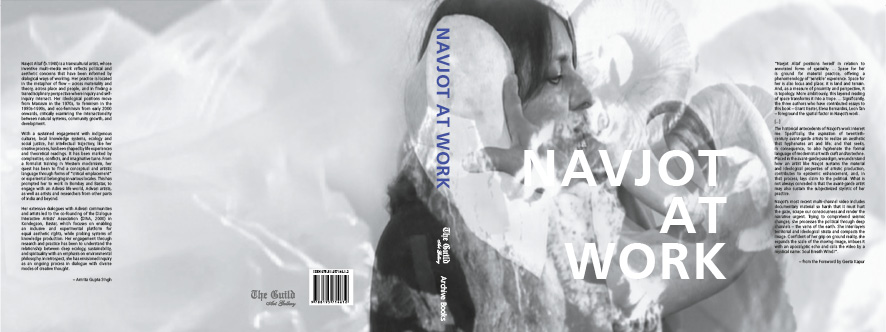
Navjot at Work
Credit: Navjot Altaf
Service-in-collaboration: Navjot at Work
The life and work of Navjot Altaf is subject to and invites a discursively enriched hermeneutics in which fluid associations and perpetual meaning-making are integral. A second publication, a three-essay book, Navjot at Work, with an erudite foreword and a photographic chronicle of her artworks and practices, accomplishes the imperative. With this book as a reference, in examining the organic collaborative works of Navjot, the following is an attempt to aid in the understanding of the nature of service-in-collaboration, in which the meaning of service acquires sociological depth, as stated at the outset of this essay.
Underlined in the foreword of the book by Gita Kapur, and reverberating across the essays, is a fulcrum—Navjot Altaf’s being and becoming, ideas and practice, implications and outcomes that constitute a ‘phenomenology of sensible experience.’ This is a phenomenology in which the idea of Rancière, discussed at the outset, finds a concrete expression. The phenomenological construction of an aesthetic regime that performs a politics: a reformulation of the sensible experiences that is central to Navjot at Work.
Typically, phenomenology is the art and science of subjective meanings leading to a deep hermeneutic understanding of the everyday worldview. Navjot’s ordinary worldview, in the essays in the book, approaches a hermeneutically loaded phenomenological episteme, which is the everyday! ‘Everyday’ as an experiential category is not merely a spatial entity. Instead, it solicits our romantic utopia and critical rationalism at once, which paves the way for a creative being on the historical timeline.11 Navjot’s aesthetics and ethics transform the everyday into an experience of possibilities. In such a framework of everyday life, the ordinary is accessible to those who join in an aesthetic-ethical-relational reasoning. The artists and those who are seemingly outside the realm of art tend to become one. The sense of aesthetics, ethics, and politics become intertwined. And therefore, Nancy Adajania’s remark elsewhere holds meaning for the larger oeuvre. She noted:
Navjot’s meditative video-poem returns grace and dignity to the figure of the artisans, not by creating a “work of art”, but by reflecting consciously on the act of labour itself. This lyrical account has a philosophical density that will outlive an anthropologist’s limited scrutiny, a developmentalist’s weakness for value judgment.12
Interpretatively, such philosophical surplus emerges from Navjot’s uncanny wandering through the humans and non-humans, sensorial-experiential, conceptual-philosophical and political-praxiological, inter alia. Adajania’s critical acknowledgement of an anthropologist’s limitation is duly suggestive. More than the visible, the said, and the noted, there are layers of practices that originates from everyday life embedded in Navjot’s practices. As noted above, the public-ness of the collaborative art projects shall be seen as integral to practice-based everyday life in Navjot at Work.
Precisely, this challenge to an anthropologist’s limited scrutiny was hinted at the outset of this essay. The challenge is not merely about decoding the philosophical density in Navjot’s artworks. More than that, this challenge demands from anthropologists and sociologists an acknowledgement to the nuances in the idea of socially organic collaborative practices which offers more than Durkheim’s idea of organic solidarity. The template of service-in-collaboration is fraught with the surplus arising from the everyday, the ordinary, and the ontological. In Navjot’s art practice vis-à-vis collaboration with ‘others’, there is an emotionally dipped intellectual interest, rather than a linear utilitarianism. The affect of collaboration, due to its praxiological tenor, collapses manifold binaries. This becomes a premise for an artist’s services to the social world. To substantiate it furthermore, the following is a synoptic rumination on some of the artworks of Navjot.
To reiterate a point, the personal, an embodied experience, is the Siamese twin of the aesthetics and ethics in Navjot. Desire, intimacy of sensation, erotic fantasy transpire in the non-linear narrative, the fragmented script.13 This is somewhat to suggest a homology between the personal and fragmentation. Arguably, only a fragmented script could be conducive for the expression of the personal that is subjectively routed and ontologically tied to experiences. Such personal dispositions lead to unearthing and engineering novel possibilities when works open up ‘subjectivised space of the political’. This is not the conventional and familiar politics articulated in the lines of a political party or in a political slogan. Instead, the subjectivised nature allows the political to be tightly aligned with personal and public at once. Hence, Navjot’s art practices aim at critically dissecting various avenues of being and doing. Circling the Square, referred to earlier in this essay14, added a spin to the idea of public art. This motive continued to unfold nuances in the latter works of Navjot. The artwork, that brought the elements of craft closer to visual art, redefined art practices and made space for more elaborate assemblage.

Links Destroyed and Re-Discovered (1994).
213 x 975 x 1067 cms. Installation with sculptures, photographs, films & music. Rendered image.
Credit: Navjot Altaf
This found more radical articulations in Links Destroyed and Re-Discovered (1994). An immaculate assembly work, Links included two documentary films, Bombay: A Myth Shattered by the activists Teesta Setalvad and Madhushree Dutta’s I Live In Behrampur. The Bombay film documented the aftereffects of the 1992-1993 riots in Bombay. The film narrated the anguish of the community about the frayed inter-community relationships in an erstwhile cosmopolitan Bombay. Dutta’s Behrampur was a more sociologically informed unravelling of a Muslim ghetto that was a target of negative portrayal by mass media during the riots of 1992-1993. The citizenship of the depressed class of Muslim population living in the suburb Behrampur was a key casualty during the riots. The two moving videos were accompanied by an equally affective musical composition. The classical Hindustani vocalist Neela Bhagwat sang the medieval saint poet Kabir’s couplet, Sadho dekho (witness saint). The installation work sets a new dimension to the collaborative artmaking. Once again, with the personal in the backdrop, the installation divulged how “having to redefine one’s identity in one’s own country was a traumatic experience.”15 Using historical consciousness the work capitalises on the memory and affect of violence and trauma. Navjot noted:
The 1947 partition of India and Pakistan killed thousands and displaced millions, including my parents. Even today while listening to them or other survivors who went through this traumatic experience, recalling the events, one realises that this is a past that refuses to go away.16
The artist’s preoccupation with the traumatic experience made her connect the series of catastrophic violence in post-independent India, riots following the demolition of the Babri mosque in 1992, spates of violence conducted by the fundamentalist forces. At every instance of violence in post-independent India there was an artist as a witness. What happens when an ontologically located artist is a witness to the violence? Artist as witness has been a useful conceptual lens in the 20th century to comprehend the essential relationship between art practices, artworks and experience of violence. The role of art as a witness to ‘what/which is’ may be traced back to existential philosophy, and the name of Martin Heidegger surfaces for attention. Art and Dasein (broadly being) were connected in existentialist hermeneutics. By and large Radhakamal Mukerjee, mentioned at the outset of this essay, gave the existential Dasein a sociological name—social structure. Artworks were witness to dynamics of social structure in post-independent India. However, the idea finds more concrete expression in the collective and collaborative art projects of artists, activists, and academics. The artists’ collective across the globe have been keen to establish artist as witness, and thus artworks as testimonials of the time. Artist as witness, arguably, becomes an essential feature of artists’ service-in-collaboration.
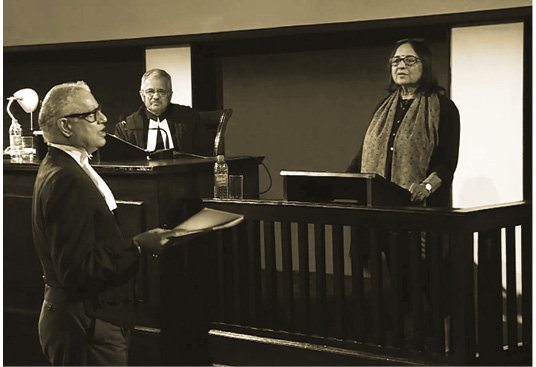
A video grab from Landscape as Evidence: Artist as Witness (2017).
Credit: Navjot Altaf
The idea of an organically emergent collaboration, in which self and other joined hands, reached another zenith later in 2017 with Landscape as Evidence: Artist as Witness. The project entailed a mock trial directed by Zuleikha Chaudhari in collaboration with Khoj International Artists’ Association.17 The project work was a staged hearing before the Commission of Inquiry under the Commission of Inquiry Act-1952 involving lawyers Arpitha Upendra and Anand Grover. In the staged hearing, the artists who appeared as witnesses were Navjot Altaf, Ravi Agarwal and Sheba Chachi. Critically reflecting on the river linking project and the devastation caused by it, the trial aimed at:
reinterpreting the language of the law through art, by positing that contemporary art is capable of inventing creative and critical approaches that analyse, defy, and provide alternatives to reigning political, social and economic forms of neoliberal globalisation.18
Every word of techno-legal significance became a personal and experiential allusion in the project. The collaboration itself became an emotionally and intellectually pertinent ground for a sense of service to the society. Navjot provides a concrete example of how an artist as witness can participate in the issues that connect environment, justice and citizenship, and thereby serve as a chronicler of experiences. The project had the artist-witnesses categorically asserting:
I want not land for land but a running brook for a running brook, a sunset for a sunset, and a grove of trees with shade for a grove of trees with shade. So my right to life is a right to my specific civilizational mode of being in the world. And I cannot be rehabilitated or compensated outside a recreation of what life means to me.19
An artist as a witness tends to infuse her personal longing, aspirations and emotions into the public concerns. Her poetry and politics come together as she speaks on behalf of the affected humanities. Thereby as a witness, the artist connects biography and history, personal and public. As a witness, Navjot, is in all of her works, telling us, the reader of subjective histories, about some of the burning issues as well as about something closer to humans in everyday life. About Rethinking Stereotype, an interactive installation with film posters in 1997 that questioned objectification of the female body, Navjot said:
During the process of drawing or sculpting a female form, I as a woman become extremely conscious of each part or contour of the body, literally escorting it from becoming an object of display, to where the body becomes a potent source of gesture, an instrument of resistance.20
Another example of a direct encounter with the public was the art project, Delhi Loves Me? (2006) by the Khoj International Artists’ Association. The project was a riposte to the text on popular stickers, ‘I Love Delhi’ in the time of the transformation of the city-space by the Delhi Government. Delhi was subject to a beautification in preparation of the then-forthcoming Commonwealth Games. The project was a critical response of the artist to the eviction and demolition of settlements of the poor. The migrant workers of the city were worst hit in the wake of then ongoing attempts to make Delhi ‘lovable’.
In many such works the aesthetic-ethics encores the re-visiting of spaces in which flora and fauna, humans and animals, animate and inanimate, spectacular and banal interact—within the modern grid.21 Navjot’s personal is still central, as she discovered the presence/absence of trees in the burgeoning concrete jungle of Barakhamba (2010). Semiotic values of the mundane and magnificent, the containers and the river in Empty Containers (2011), reaffirmed the artist’s sense of service to the society. An analogous relationship of the city and human anatomy in Body City Flows (2015) made spatial embodiment a central idea. Above all, there was a telling semiotic-praxiological centrality of the Mahua tree, known as the tree of life amongst the adivasi22 of Bastar in Politics of 100 Mahua Trees (1999). There are metaphors through which Navjot re-turns to the known and unknown without slipping into nostalgia or making a compromise on the humanised-historicised hermeneutics. Hence, interpersonal relationships and consequent subjective experiences dominate in a long series of works that centralises an ontology of the ordinary lives interspersed with meanings and fraught with inexorable meaning-making. Navjot at Work thus becomes an essential reading for sociologists and anthropologists longing for the avenues to explore theoretical, conceptual, methodological, and philosophical advances in a post-positivist world.23 Navjot’s body of work provides ample space for sociological reasoning in which ontology supersedes epistemology.
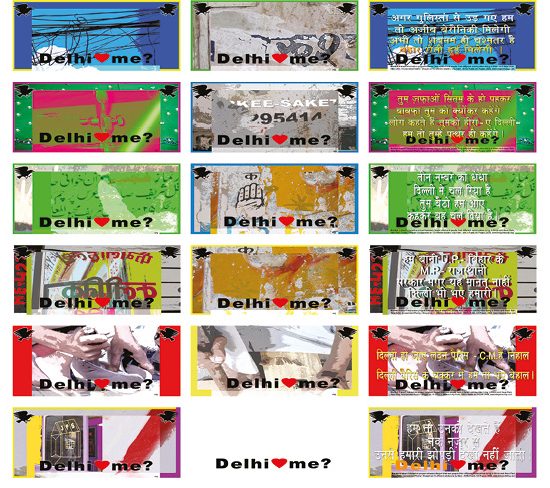
Delhi Loves Me? (2006)
Credit: Navjot Altaf
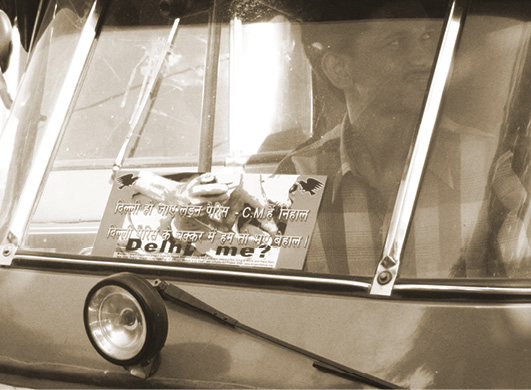
Autorickshaw with a sticker on it, from Delhi Loves Me? (2006)
Credit: Navjot Altaf
In such a backdrop the three essays in the book Navjot at Work enable a conceptually sound interpretative engagement with Navjot.24 Art historian Elena Bernardini chronologically locates the emergence of public space and community as a focus in the intellectual and personal biography of an artist. A point made earlier, there is a hint of sociological imagination in the relationship between Navjot’s biographical trajectory and historical encounters. Bernardini aids in comprehending the meeting of micro and macro in a dialogic aesthetic.25
With an exposure to Marxism, Navjot had started critically rethinking the elitism of the art world in the 1970s that enabled her and other artists to evolve “ways of working and exploring art as a means of community outreach and politicisation.”26 There was however a critical realisation of the inherent limitations of Marxist lens in the 1980s. This led Navjot towards alternative epistemologies to unearth the depth of engendered marginalised subjectivities. The biographical and historical experiences advanced furthermore. In the wake of neoliberal globalising and mobilisation of the communal politics in the later decades, Navjot began to sharpen her aesthetic lens at other questions. The question of public became intertwined with that of democracy in the politically volatile India.
A perpetual negotiation between art and activism27 comprising tension and reflexivity seems to have shaped up Navjot’s interventions. Grant Kester’s essay notes as emerging key aspects: “adaptation and survival, resistance and assimilation.”28 These aspects characterised her decade-long engagement with the collaborators amongst the adivasis in Kondagaon, Bastar in Chhattisgarh. It led to the formation of Dialogue, a centre of art practices, collaborative and immersive processes, and moreover, a trail of what may be safely called ethnographic-art. The Nalpar sites, mentioned earlier in this essay, created structures around handpumps in order to make an intervention in the seemingly mundane gendered space. The project had far more profound implications than NGOs’ developmental schemes. In this process, Navjot’s art practice manifested a hermeneutic ‘fusion of horizon’29, paving the way for a re-creation of the everyday life, adding a new fillip to the phenomenology of the ordinary.
Foremost in such an endeavour lies a challenge—the idea of the ethnographic embedded in conventional anthropology. Foster, in The artist as ethnographer?30 had discussed the potentialities of artists as ethnographer. The objective was to underline the relationship between art, anthropology, and politics of representation. Foster was keen to show that an artist as ethnographer is more equipped to bridge the gap between the self and other. This is unlike an anthropologically trained ethnographer who maintains a sense of distance from the object of enquiry. The idea of artist as ethnographer was central in Dave-Mukherji’s31 unraveling of the ethnographic disposition in the art practices of the artist Pushpmala.32 Such ethnographic art practices hold out a great opportunity for the anthropologists who anxiously debated the nature of ethnography in anthropology.33 An artist, as an ethnographer as well as a witness, is indeed more inclined to render the outcome that qualifies for service-in-collaboration. Such an artistic ethnography is not a technical documentation of the observed objects. Instead, the documentation in a collaborative framework puts together self and other, the artist and the community. Furthermore, the coming together of an ethnographer and a witness in the artists augurs well for a socially rooted and politically responsible art practice.
In Navjot at Work, Leon Tan’s essay comes headlong with provocative postulates. The essay reminds us of the reductionist nature and scope of available theories in social and cultural studies. Theories with suffixes such as structural, functional, realist, positivist, behaviorist, poststructural, interpretative, seek to reduce art practices and artworks. Such theoretical strands allegedly lead to the three broad labels of reductionism, namely, microreductionism, macroreductionism and mesoreductionism. And hence, as Tan arguably suggests, ‘assemblage theory’ is most appropriate to comprehend Navjot’s works and practices that deal with multi-scalar reality. Such a reflexive theoretical approach aids in understanding the sensorium underpinning and consequent upon Navjot’s practice. Many verbs such as listening, immersing, talking and, overarching these, ‘be-ing’, amount to a more processual arrival at a series of nouns. The coming together of verbs and nouns in the grammar of an artist evokes a sensory totality, an ontological sensorium! The network of collaborations give birth to a kind of relational aesthetics in which encounters of disparate assemblages is foremost. This is somewhat characteristic of the aesthetics of the service-in-collaboration.
However it is this very processual uncertainty, a kind of fluidity of the being of the artist, which renders the art practice of Navjot into an organically evolved praxis.34 In this praxiological scheme, being and doing, thinking and feeling are hard to separate. Any endeavour to impose a conceptual framework on the processual praxis diminishes the hermeneutics entailed. Attempts to define the ordinary and conceptually classify the ontologically complex embodied personal experience, the core of Navjot (at) work, perhaps may give rise to the conceptual binaries!
Conclusion: Sociology of Contemporary Visual Art
This essay is an attempt to underline the significance of Navjot Altaf’s art practice, with reference to selected works, to comprehend the key theme—service-in-collaboration. The nuances of the service surfaces in an analytical engagement with the art practices and work of Navjot in this essay. The double-edged appearance of an artist, as an ethnographer and a witness, tend to infuse more value into the notion of collaboration. The distance between the self of an artist and the objects of representation shrinks. There is no oriental or contemporary other, in the art practice of Navjot. The artworks thus are social, cultural and political at once.
A constant refrain in the essay is the imperative for sociology and social anthropology in South Asia to turn to the visual arts and practices. Engagement with visual arts in contemporary sociology in the region of South Asia and particularly in India is few and far between. Volumes of visual arts engage with objects of enquiry that are seemingly sociological and anthropological. The pioneers of sociology, as alluded to in this essay, envisaged a sociology in post-independent India that could read arts in order to develop a social hermeneutics. Somehow, it has been buried in ‘disciplinary amnesia’, a lament that has been echoed by some contemporary sociologists.35 Moreover, the relation between sociology and art forms was critically emphatic in the global American sociology too. Robert Nisbet was a prominent proponent who underlined this relationship in the classical sociological theories. The sociological reasoning in this essay, for example, dwells on not only sociological-theoretical premises but also on the ways of making sense of the arts and aesthetics. Hence, the idea of aesthetic regime that plays a crucial role in the political nature of relationship between the self and other is foregrounded. There is a perpetual urge in Navjot at Work to dislocate and relocate her art practices, in public with public at large. A redistribution of the aesthetic sensibility upsets the politically sustained order and hierarchy, adding a critical feature to the service-in-collaboration.
This essay, dealing with the artworks and art practices of Navjot Altaf, explored as to how novel possibilities for sociology and anthropology could emerge. Be it in terms of the methodological tools or the ways of seeing that an artist such as Navjot employed. The emergence of conceptual lenses is equally significant. There is an under-explored epistemic density in such a visual art practice awaiting sociologists’ attention. A novel sense of artist’s ethnography, a socially and politically enmeshed art practice, arises in Navjot’s oeuvre that cannot be easily ignored by the anthropologists who claim to be champions of fieldwork. In such a context, a phenomenological episteme, the everyday, becomes a potent rationale for revisiting the classical texts too.
This essay has tried to modestly accomplish a sociological comprehension of the praxiological everyday, and consequently a notion of service-in-collaboration in Navjot at work. The everyday is historical and material as much as it stands for the poetics and politics of the ordinary. To emphasise, the service to the social world by artists in an organic collaboration is not a utilitarian, agenda-driven, short-lived project. Instead, it is a more elaborate structure of organicism in which service is as much personal as it is public, corresponding with the nature of public art. In the same breath there could be further sociologically inclined interdisciplinary explorations of the interface of market, state, society and the world of visual arts.
Footnotes
1 Among others, Turner (Ritual Process, 1969) is a classic example.
2 Many critical readings of Durkheim’s formulations have emerged, from Robert K. Merton’s review to a recent revisit that acknowledges the ambivalence of Durkheim (Pathak, 2025).
3 The Guild is a Mumbai-based institution that provides a platform for contemporary visual art, curates art programs, nurtures art practices, and contributes to art scholarship in addition to providing exhibition space since 1997.
4 Artist’s Notes 126.
5 See Asad and Cohen for more detailing on the anthropologists’ preoccupation with the other.
6 Verstehen is the German word for understanding, a key methodological concept in Max Weber.
7 See Gramsci for a more riveting discussion arising from the prison notebooks.
8 Artist’s Notes 126.
9 Navjot at Work 83.
10 See Schutz, and for an engagement with feminist standpoint theorists’ phenology, Pathak (2025).
11 See Schutz, and for an engagement with feminist standpoint theorists’ phenology, Pathak (2025).
12 “The Line Has Become a Circle” (2005), quoted by Kapur (2022) in a long endnote in the foreword.
13 Navjot as paraphrased by Gita Kapur (Navjot at Work), with regard to Touch I II III: Remembering Altaf, 2006-07 (3-channel projection, 8.40 minutes, looped, colour, sound).
14 Navjot in Artists’ Notes 8.
15 Navjot in Artists’ Notes 9.
16 Navjot at Work 9.
17 Founded in 1997 Khoj is an institute that provides space for art practices, curating, and moreover artists’ network and solidarity. For more, see https://khojstudios.org/ (accessed on 1 April 2025).
18 Navjot in Artists’ Notes 123.
19 See https://khojstudios.org/event/landscape-as-evidence-artist-as-witness/ (accessed on 1 April 2025).
20 Navjot at Work 17.
21 As observed by Gita Kapur in the foreword.
22 “Adivasis is the collective name used for the many indigenous peoples of India. The term Adivasi derives from the Hindi word ‘adi’, which means of earliest times or from the beginning and ‘vasi’ meaning inhabitant or resident, and it was coined in the 1930s, largely a consequence of a political movement to forge a sense of identity among the various indigenous peoples of India.” https://minorityrights.org/communities/adivasis-2/
23 An effort in this direction that underlined the significance of skepticism and ambivalence in doing sociology, is in Pathak (2025).
26 Bernardini in Navjot at Work 82.
27 Elsewhere Adajania noted it as a tension between art and activism in Navjot.
28 Kester in Navjot at Work 190.
29 This was a process of arriving at understanding as explicated in the ever-relevant work Truth and Method by the hermeneutic philosopher, Hans-Georg Gadamer.
30 pp. 302-309
31 Mimicking Anthropologists, pp. 49-72
32 See https://naturemorte.com/artists/pushpamalan/ (accessed on 1 April 2025).
33 For example, see Geertz, Works and Lives (1988) followed by the writing culture debate in Writing Culture: The Poetics of Ethnography, ed. Clifford and Marcus (1986) and others.
34 An idea hinted in the foreword by Kapur in Artist’s Notes. There is a possibility of a debate on the question of ‘practice transformed into praxis’ in Navjot’s oeuvre of works, revisiting the theoretical propositions from Pierre Bourdieu and Antonio Gramsci.
35 See Madan and Thakur, and another modest attempt in Pathak (2025).
References
Adajania, Nancy. “From One Crisis to the Next: The Fate of Political Art in India.” Sarai Reader, 2004, pp. 86-91.
Adajania, Nancy. “The Line Has Become a Circle: Recent Works by Navjot.” Navjot, Exhibition Catalogue, Talwar Gallery, New York, Sakshi Gallery, Mumbai and The Guild Art Gallery, Mumbai, 2005.
Asad, Talal. Ed. Anthropology and the Colonial Encounter. Humanities Press, 1990.
Bernardini, E. “Public Art Rethought: Video in the Work of Navjot Altaf.” Navjot at Work. The Guild Art Gallery, Mumbai, 2022, pp. 81-113.
Clifford, J. and G. Marcus, editors of Writing Culture: The Poetics of Ethnography. University of California Press, 1986.
Cohen, B. Colonialism and Its Forms of Knowledge: The British in India. Princeton University Press, 1996.
Dave Mukherji, Parul. “Mimicking Anthropologists: Re-Membering a Photo Archive via Pata Paintings, Performative Mimesis, and Photo Performance.” Intersections of Contemporary Art, Anthropology and Art History in South Asia: Decoding Visual Worlds, edited by Sasanka Perera & Dev N. Pathak, Palgrave Macmillan, New York, 2019, pp. 49-72.
Durkheim, Emile. The Division of Labor in Society, 1933.
Foster, H. “The artist as ethnographer?” The Traffic in Culture: Refiguring Art and Anthropology, edited by G. Marcus and F. Myers. Californai: University of California Press, 1995, pp. 302-309.
Gadamer, Hans-Georg. Truth and Method. Bloomsbury, 2013.
Geertz, C. Works and Lives: The Anthropologist as Author. Stanford University Press, 1988.
Gramsci, A. Selection from the Prison Notebooks of Antonio Gramsci. International Publisher, 1971.
Kapur, Gita. “Foreword.” Navjot at Work. The Guild Art Gallery, 2022, pp.7-18.
Kester, G. “Samvad in Kondagaon: Navjot Altaf and Collaborative Praxis in an Adivasi Village.” Navjot at Work, The Guild Art Gallery, 2022, pp. 189-205.
Madan, T.N. Sociological Traditions: Methods and Perspectives in the Sociology of India. Sage, 2011.
Merton, R. K. “Durkheim’s Division of Labour in Society.” American Journal of Sociology, Vol. 40, No. 3, 1934, pp. 319-328.
Mills, C. W. The Sociological Imagination. Oxford University Press, 1959.
Minority Rights Group. Adivasis in India. https://minorityrights.org/communities/adivasis-2/. Accessed 9 May 2025.
Mukerjee, Radhakamal. The Social Function of Art, Bombay: Hind Kitabs Limited, 1948.
Nisbet, Robert. Sociology as an Art Form. London: Oxford University Press, 1976.
Pathak, D. N. In Defence of the Ordinary: Everyday Awakenings. London & Delhi: Bloomsbury, 2021.
Pathak, D. N. “Book Review: Navjot at Work.” Take on Art Magazine, Issue 28, 2022, pp. 160-162.
Pathak, D. N. To Be or Not to Be Sociological: Methodological Ways of Seeing. London & Delhi: Bloomsbury, 2025.
Rancière, J. The Politics of Aesthetics: The Distribution of the Sensible. Bloomsbury, 2004.
Schutz, A. The Phenomenology of the Social World. Northwestern University Press, 1967.
The Guild Art Gallery. Artist’s Notes. Mumbai, 2022.
The Guild Art Gallery. Navjot at Work. Mumbai, 2022.
Tan, Leon. “Public Art Assemblages: Navjot Altaf.”, Navjot at Work. Mumbai, The Guild Art Gallery, 2022, pp. 262-277.
Turner, V. Ritual Process: Structure and Anti-Structure. Aldine Press, 1969
Thakur, Manish. The Quest for Indian Sociology: Radhkamal Mukerjee and Our Times. Shimla: Indian Institute of Advance studies, 2014.
Weber, Max. Economy and Society: An Outline ofInterpretative Sociology. London: University of California Press, 1978.
Essays
Abstract
Centre for Contemporary Culture KRAK and its practice is understood through the prism of specific political, social and cultural conditions in Bosnia and Herzegovina in the past three decades. The main features of this are the conflict-related and post-traumatic experience, corruption and failed transition, as well as depopulation. Since its opening in 2020, KRAK created an independent and critically-oriented space within which innovative ideas have been generated and articulated. As such, KRAK Centre is a direct response to lasting crisis. It is a direct reference to the dominant and aggravating circumstances facing Bosnian and Herzegovinian society today, and therefore, it is an experiment because of the belief that culture, science and arts need to be the driving force for social changes. With its strategies of conviviality, care and emancipation, KRAK is perceived as social practice – a service, far from governing and instrumentalised state-funded agencies.
This paper gives insight into curatorial practice in the socially abandoned and neglected urban environment of the city of Bihać where KRAK is located. It also deals with issues related to work in the fields of contemporary culture and art, and being engaged in the European periphery today. Since Bihać with\its specific geography in this context can be perceived as a starting point for understanding the complex political, social and cultural layers within which KRAK operates, this paper contemplates the distance between the artistic image and real life in the context of the European periphery and its marginalised environment. Additionally, it initiates a discussion on present relevant issues in a traumatised, post-war and post-genocide society, searching for possible answers to the questions: how to articulate an artistic discourse on the European periphery and how to motivate urban reinvention in a post-socialist and post-industrial spatial context.
About the context
Bosnia’s path into independence, in the last decade of the 20th century, was marked by turns and discontinuity. Once part of the socialist Yugoslavia with a one-party system and centralised economy, Bosnia and Herzegovina is now a young democracy in development. Stretched between the legacy of self-governing Yugoslav socialism and privately-oriented neoliberal capitalism, Bosnia’s way into liberation was marked by ethnic cleansing and genocide from 1992 to 1995. The collapse of Yugoslavia as well as the conflict that followed, initiated a long-lasting turmoil that is still present. Even thirty years after, Bosnian society is still involved in conflicted discourse with immense impact on society, culture and economy.
A crucial perspective for understanding the post-war landscape of Bosnia and Herzegovina can be gained by examining its cultural and artistic institutions. The state of culture in the country cannot be discussed without acknowledging the cultural crisis, which stems from the poorly constructed Dayton Peace Agreement of 1995.1 By signing the Dayton Peace Agreement in 1995, the legal status of these institutions remained deliberately unresolved and seemingly postponed for some better times. Bosnia and Herzegovina’s ethnocracy, formalised by the new constitution, has “lowered” cultural issues from the state to the regional and county levels, bringing into question the collective cultural identity of the entire country, limiting and minimising it.
Such an attitude has weakened the awareness of the importance of culture in general; key institutions have been marginalised to the extreme and some even shut down. Within a complex legal framework, counties and municipalities missed the opportunity to take over what the state failed to do—the regeneration of devastated cultural spaces. Culture eventually died out and was recognised as useless and passive, as an object of constant tension, problems and unfinished processes.
In addition, the poor territorial organisation of Dayton-mandated Bosnia and Herzegovina—which did not follow the geographical characteristics but the results of the brutal seizure of territories and mass expulsions—made its cities disconnected from one another. Territorial defragmentation and ethno-national divisions, further isolated and aggravated the situation of the country as a whole. The Dayton model has long shown its unsustainability, with the parliamentary political nomenclature unable to redesign the existing constitution for fear of possible losses of war booty.
Cities of Bosnia and Herzegovina, although in the process of development and construction, were places of sophisticated industry with a developed urban middle class before the country’s independence in the 1990s. After the war and the signing of the Dayton Agreement, the position and importance of Bosnia and Herzegovina’s cities was redefined due to the new reorganisation—they were industrially devastated and demographically weakened. In some of them, new institutions of general importance have been established, such as universities, galleries or cultural centres. Although for a moment it seemed that these cities were facing new social challenges, many opportunities have not been used enough since the end of the war onwards.
Continuously poor policies at all levels of the state, disintegration in the education system as well as radical provincialisation aided by changing demographic conditions have turned Bosnian cities into isolated and closed provinces on the margins. Pseudo-democracy, parliamentary travesty, corruption and clientelism, together with neoliberal tendencies of a global character, have served as a framework for unprofessional and unethical reflection on the heritage and cultural identity.
Within such an environment, cultural institutions have been contaminated with apathy, lack of any momentum, and lack of ideas. Many of them have found themselves in a vicious circle that perpetuates the crisis. The absence of public discourse on culture, the lack of cultural strategy at the state, entity, cantonal or municipal levels and the lack of creative ideas have created an environment in which below-average cultural practices are established, that include courting the citizens and the public with insufficiently critically attuned and entertaining contents.
Disinterest and general ignorance have bypassed the awareness that culture is an agent of social change, that it has the power to identify and re-identify society with new models, as well as the power to reshape the consciousness of an individual and a group towards something new.
Perhaps the most important non-institutional art project in this direction in the country, is the Ars Aevi Museum of Contemporary Art in Sarajevo. Even while Sarajevo was under heavy attack during the siege in the 1990s, the idea of the Museum was born. The initial idea of its creation was based on “the conviction that the artists of this age feel and understand the injustice done to our city.”2 Thus, the project, which was administered from the beginning as a civic organisation and not as a public institution, encoded the idea of proactive action based on the need for civil resistance to war destruction and the natural desire to open the besieged city and connect it with the wider world.
The expectations of the significance and scope of activities of an organisation were surpassed with Ars Aevi, because in its breadth and depth it managed to produce incredible results. Under the leadership of Enver Hadžiomerspahić, former director of the opening programme at the 1984 Olympics, and later director of cultural programmes at the Skenderija Olympic Centres, Aevi remained involved in the fight against the devaluation of general social and cultural values in its community. A careful curatorial selection of several collections that would form the basis of the future museum, it was accompanied by a painstaking engagement in the administration of the entire idea, only to become a Public Institution of the City of Sarajevo in 2017. From the formation of the first tangible collection until today, Ars Aevi still does not have formal headquarters and has moved several times, although its main architectural conceptual design was made by the well-known architect Renzo Piano.
Ars Aevi is a cultural and artistic idea that, with its constituent elements, speaks about the phenomenon of the crisis in the field of culture and art in Bosnia and Herzegovina. It is the paradigm of a new era that began with the unfortunate war of the 1990s, and which no longer has the capacity to base a projection of itself on events and happenings before that. Ars Aevi is tangible with its problems and challenges, in contrast to the cultural institutions formed after World War II, which is a distant history that is difficult to understand and turn into paradigms with which today’s society could identify. Although Ars Aevi represents the logical development of an urban environment, in its essence it is a symbol of an interruption, break and discontinuity caused by war.
Although there are funds at all levels that cover the needs of culture and art, it can certainly be said that their implementation is marked by nepotism, corruption, bad criteria and constant reduction, that is, by abolishing the available funds. The existent state-funded Foundations do not suggest seriousness and commitment, while the process of evaluating the received applications and allocating funds takes place in a non-transparent and clientelist way. Viewing nationality as a key element, incompetence, bureaucracy and deadly formalism are just some of the characteristics of how these funds function.
Non-institutional involvement is a counterpoint to the aforesaid and a reflection of the responsibility of citizens and individuals to resist the general decline and systemic devaluation. It is often motivated by the crisis of society, ranging from systemic state negligence, official ethnocratic organisation, but also commodification due to the uncontrolled restoration of capitalist ownership relations in post-socialist Bosnia and Herzegovina. On the other hand, the above-mentioned problems on the scene of Bosnian culture, which are most evident through issues of institutional action in the range between the legislative and executive power, are a suitable environment for social practice and civic engagement. This type of action is marked by a discerning judgment of the validity of official practices of parliamentary political discourse, and is operational in clear spheres of assessment and action. Of course, this fits into the global trend of “increased tendencies to subject politics and art to the moral judgment of the validity of principles and the consequences of its practices.”3 An ethically informed approach on the cultural stage does not make all parties happy but on the contrary, it provokes, confronts and polarises.
A potential contextual comparison for Bosnian cities can be drawn with Detroit, a U.S. city shaped by postindustrial challenges marked by racial and class divisions, impoverishment, and depopulation. Once a symbol of American industrial progress, Detroit also became a testing ground for racial capitalism and systematic segregation, which fueled conflicts and urban displacement. Straddling the extremes of poverty and prosperity, Detroit has struggled over the past few decades to regain its former status as a quintessential American capitalist hub. Factors such as disinvestment and industrial decentralisation since the 1960s have contributed to this decline. Once a global industrial powerhouse in the first half of the 20th century, Detroit now stands as a striking example of radical decline, offering a peculiar and diverse set of opportunities. The reality that “you can do all sorts of things that you can’t do elsewhere” is both inspiring and unsettling, positioning Detroit as a major post-American city.4
KRAK Centre and curating the periphery
Centre for Contemporary Culture KRAK, in northwestern Bosnian city Bihać, was established in 2020 as a result of endeavours in the field of critical theory, art/design practice and civic engagement generated in the last several years around the Department of Textile design at the University of Bihać and City Gallery. It is an independent and autonomous space that emerged as a result of continued scientific observations and their practical implementations from 2011 onwards. Its conceptual context is framed by post-socialist and post-industrial characteristics—unsuccessful and painful transformation from Yugoslav socialism into post-Yugoslav neoliberal capitalism. The main marks of that period are conflicted relations, depopulation, poverty and trauma.
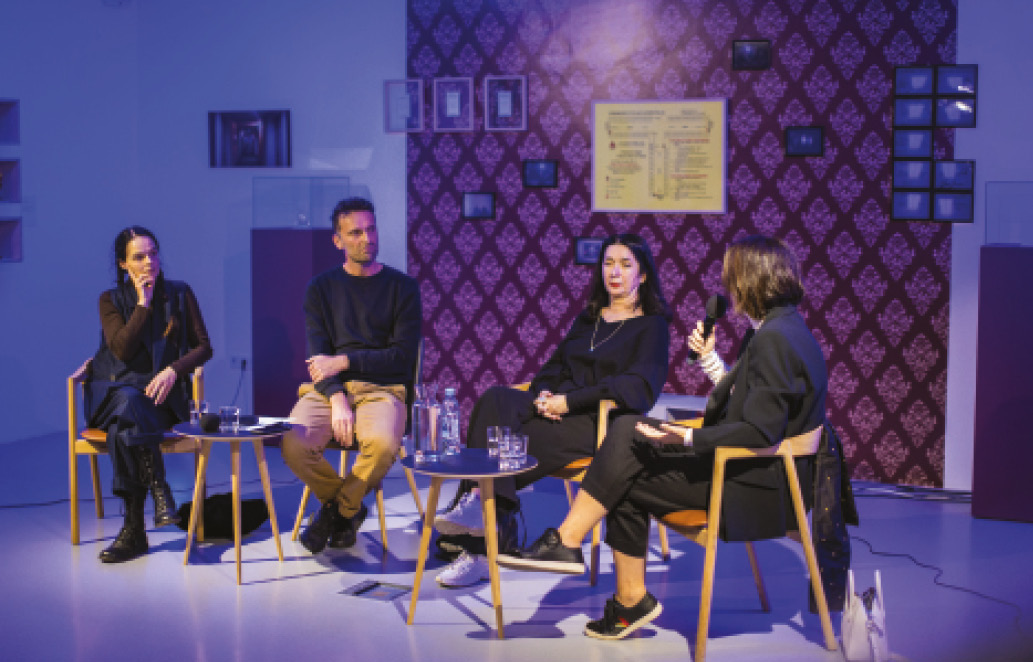
Public talk Curating the Periphery. Molly Haslund, Zdenka Badovinac and Šejla Kamerić in conversation with Irfan Hošić. KRAK, October 2023. Photo by Mehmed Mahmutović.
The focus of KRAK is on contemporary culture including visual arts, design and social theory as a frame for proactive practice. It is imagined as a participative project with different protagonists who use the tools of social engagement and urban transformation to foster process of learning, informal education and cultural exchange. KRAK launched its first program in 2021 where questions of migrations, identity, public space and visual culture, were articulated. Using curatorial practice with the intention of intervening in socially relevant processes, KRAK deals with the challenges of working in the field of contemporary culture and art in a context characterised by post-war, post-socialist and post-industrial trends.
After years of neglect and after several prompt discursive actions organised in the Kombiteks Workers’ Club in recent years, the Council of the City of Bihać as owner, handed this space to the Revizor Foundation to open in its premises the KRAK Centre.5 The name KRAK is an acronym for “Kombiteks Workers’ Club” (Klub radnika Kombiteksa) and is directed to sustain the importance of cultivating local industrial heritage and workers’ culture of Yugoslav self-management socialism.
After several years of operation, KRAK serves as a bridge between the Yugoslav industrial past and its self-management socialism, where the “commons” played an important and systematic role. Thus, KRAK can be understood within the frame of “art of the commons”—the practice that lies as “an indeterminate zone between public and private” space.6 The cultural critic Carducci writes:
The art of the commons trespasses the boundaries of conventional property relations of modern capitalism, existing in an indeterminate zone between public and private as customarily understood (…) Collective freeing of land and labour from capitalist economic and social relations.7
As such, proactive artists and various practitioners are imagining new politics of space, initiating important questions as to whom the city or the neighbourhood actually belongs. Artistic interventions of that kind serve as a strong defense against centres of power and control that are traditionally in alliance with investors and very often dehumanised architects and designers. Community art projects of this kind are “challenging political messages meant to provoke discussion on issues of poverty, racism and social disintegration that informed the quality of life for the community.”8
Although Bihać has several cultural premises that are all organised as public institutions, the launch of an alternative and independent space in the field of culture represents a necessity of the city of Bihać and its urban life. KRAK is oriented and focussed on contemporary cultural practices such as visual arts, architecture, design, performance, dance, music, science, alternative education and ecology, with interaction with the most diverse types of citizens and groups of different profiles.
The idea and motive for launching such a centre stems for the specific political, social and cultural conditions in the country in the past two or three decades. The main features of this are the city’s neglected industrial past, the conflict-related and post-traumatic experience, and depopulation. Of course, it is a perfect seedbed for the conceptualisation of dynamic practices of total engagement through the establishment of an independent and critically oriented incubator within which creative ideas would be generated, where new generations of socially responsible individuals would get together. The KRAK Centre is a direct response to the lasting crisis. It is a direct reference to the dominant and aggravating circumstances facing Bosnian and Herzegovinian society today and, therefore, it can be understood as an experiment because there is a belief that culture, science and arts can and need to be the driving force for social changes.
In the long run, KRAK wants to position itself as the platform for alternative learning, collaboration and coexistence with a focus on contemporary artistic strategies and inventive cultural protocols. Participation of a wide spectrum of professionals and amateurs—artists, architects, designers, educators, lawyers, activists, gardeners, environmentalist, bee-keepers, as well as legal entities motivated to be profiled and engaged in socially responsible practices—is the key aspect and the fundamental premise of potential activity aimed at shaping a new social reality. KRAK wants to be tested as an incubator of a new social life.
Considering Detroit as an ideological counterpart, with its practical initiatives and diverse social practices “that stands as a collector of social value for the creation of a sense of community as a result of multidisciplinary collaboration,” one notable example is the Akoaki design studio.9
Akoaki is an architecture and design studio founded by Anya Sirota and Jean Louis Farges in 2008, with a mission to engage with the social, spatial, and cultural realities of Detroit. Their participatory and inclusive design approach has earned Akoaki international recognition. As the city became increasingly disconnected and fragmented, with vast areas of vacant land and emptiness, Akoaki emerged as an innovative initiative “bridging the commonly perceived divide between social and aesthetic practice”, whose “work explores urban interventions, perceptual scenographies, and pop actions as response to complex and contested urban scenarios.”10 Rooted in Detroit, Akoaki’s site-specific designs align with the idea that “Detroit represents an exceptional opportunity to promote a new culture of work that puts the relationship among people at the centre.”11 However, the founders recognise that “design alone, unfortunately, does not have the force to answer these pressing needs.”12 Sirota addresses how design, on a larger scale, can provide a platform for participation and interaction, highlighting that inclusive design has a profound psychological and emotional impact on people. “What design can do is to create an environment for every single individual, a protected space where they can give voice to their own opinions, experiences, aspirations and problems, allowing us to modify the common perception of the city and reveal a multitude of stories that would otherwise remain hidden.”13
KRAK’s forerunners
A crucial event that served as a booster in reinventing and conceptualising the former Workers’ Club into KRAK Centre, was the exhibition Artefacts of a Future Past in 2017. It was realised in the framework of the two-day symposium Industrial Heritage in Bihać between Reality and Vision that aimed at tackling a series of “complex issues of urban planning, architectural, aesthetic, ecological and social context of abandoned industrial facilities” with a potential projection of the picture of “creation or recreation of spatial contents that open the possibility for discussion about social engagement, social practices and cultural activism in our community.”14 This symposium was organised as a part of the Design and Crisis course conducted at the Textile Department of the University in Bihać within the summer semester 2017.15
The exhibition was documented within the same publication published by Foundation Revizor in May 2020. The publication was produced three years after the realisation of the eponymous exhibition and at the moment when the space where the exhibition was held, the Kombiteks Workers’ Club, faced a completely different destiny. The catalogue and documentation imbued the publication with the character of a manifesto for the future KRAK Centre. It is the best way for interpreting the works that were exhibited there in March 2017. What was on the horizon of expectation in the process of conceptualising the organisation and set-up of the exhibition has become today, two years later, an integral part of immediate experience.
With the transformation of the above-mentioned space, preconditions for a new beginning based on heritage were met, and the publication served, in addition to being a catalogue and documentation, to reposition—from the newly created situation—the field of interpretation for the reading of individual works, the exhibition as the whole as well as the social context in which it was emerged. From this perspective, the exhibition can be understood as an articulation of guidelines in the long-term consideration of the programmatic development of the space after its revitalisation, and as its cultural upgrade, art, social responsibility and creation of the community.
The exhibition Artefacts of a Future Past is a collection of objects with a documentary, artistic and engaged character that initiated discussion of a layered interpretative spectrum, related to the complex process of an unsuccessful transition from the self-management socialism into a market-oriented liberal and multi-party system. The exhibition comprises a wide range of artefacts—from artworks to conceptual designs and finished designs to industrial artefacts dating back to the second half of the 20th century. Brought together in one place in the form of an exhibition, and re-contextualised through the prism of the two-day symposium Industrial Heritage in Bihać between Reality and Vision, these artefacts represent an attempt to map the phenomena of the industrial and the post-industrial era, juxtaposing them in a new critical perspective with local and regional visual art and visual culture, against today’s social context.
The exhibition Artefacts of a Future Past is an attempt to reconstruct the consciousness and memory that encompass the period of late socialism, on one hand, and the time of the multi-party system of capitalist Bosnia and Herzegovina since the 1990s until the present time, on the other. The exhibition is also an attempt to initiate a new understanding and reading of the industrial heritage of Bihać, which is expected to yield, in the long run and from a critically focussed perspective, new guidelines and new results in this field. A transformation of what was once the Kombiteks Workers’ Club with the exhibition Artefacts of a Future Past, as well as the recent establishment of the KRAK Centre for Contemporary Culture, guarantees the success of previously undertaken activities and of the long series of discursive contents that have marked the industrial heritage as a treasury of great material and intellectual potential. Culture, art and recent curatorial practices play an important role in mediation and education, while their discursive character and activistic tone are of a great relevance for a wide variety of socially engaged processes.16
The position of KRAK in the country’s post-war landscape can be understood through the dynamics of non-institutions, their strategies, and programme activities in a dysfunctional country. The term “non-institutions” refers to civic initiatives whose actions and methodologies have significantly impacted the artistic landscape of Bosnia and Herzegovina. Notable examples include the Obala Art Centre, Gallery 10m2, Brodac Gallery, Sklop organisation, Kuma International Centre for Visual Arts from Post-Conflict Societies, and Charlama Depo Gallery.17 Each of these initiatives embodies the idea of proactive action driven by a need for civil resistance and a natural desire to connect peripheral communities with the broader world.
Conclusion
The question of KRAK Centre for Contemporary Culture, its strategies, and programme in a dysfunctional country warrants a broader discussion aimed at understanding the complexity of its political, social, and cultural layers. As a compensation for unsuccessful and failed strategies of governmental institutions, KRAK’s presence in its non-profit actions, is a selfless practice of engagement and devotion. Within this context, the emergence of independent and individual initiatives can be seen as a response, with the goal of generating artistic discourse, mediating its content, and educating the public. The impact of KRAK Centre, along with similar initiatives, is significant and substantial, as each has, in its own way, contributed to the development of the local art scene, stimulated key artistic phenomena, and fostered dialogue within contemporary art practices and independent curatorial work. These initiatives also provided platforms for the exchange of ideas and acted as meeting points for international artists.
In view of the failures and its long-lasting consequences caused by the poorly designed Dayton Peace Agreement, there emerges a framework for independent artistic platforms and cultural organisations. These initiatives are motivated by the need to address key questions: How can reinvention be initiated in a post-socialist and post-industrial urban context? How can critical discourse be nurtured and articulated within the societal framework shaped by post-war and post-genocide realities? And, how can work be carried out on the European periphery and within national margins?
The Bosnian case is more paradigmatic and significant in view of rampant conflicts in Ukraine, Palestine and elsewhere. It can serve as a lesson of preservation of peace in instable regions, as it can well show the importance of culture in a post-war society—its possibilities and strategies. In this perspective, KRAK as a community hub can be perceived as a tool of emancipation and platform where new values are formed.
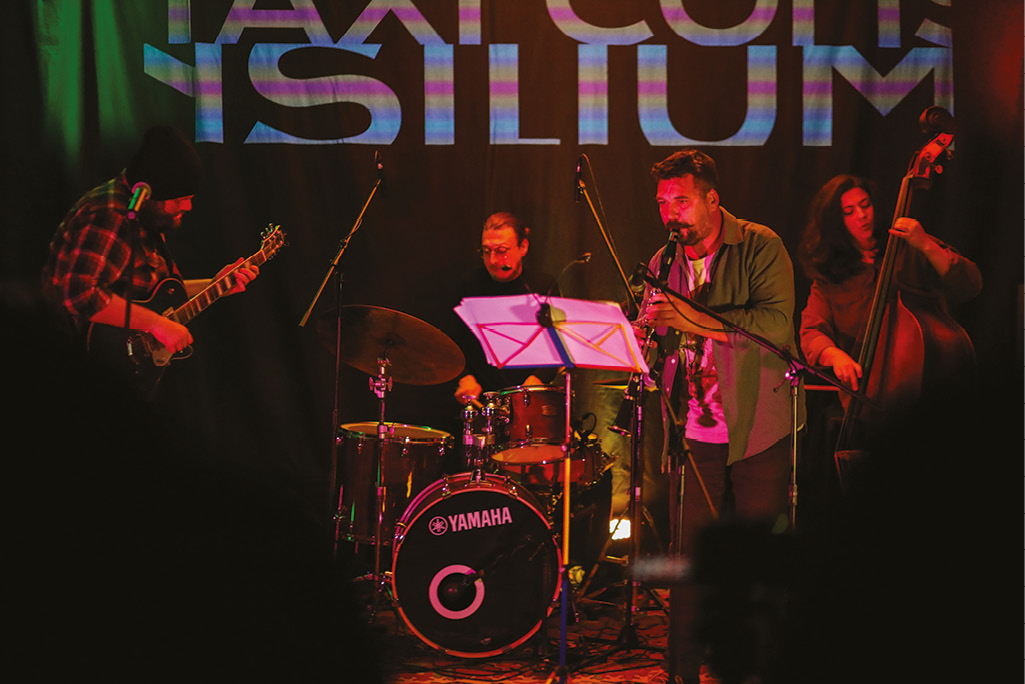
Exhibition Suit of Fire. Artists: Kemil Bekteši, Milena Jandrić and Vildana Hermann.
Curated by Isidora Branković. KRAK, October 2024. Photo by Mehmed Mahmutović.
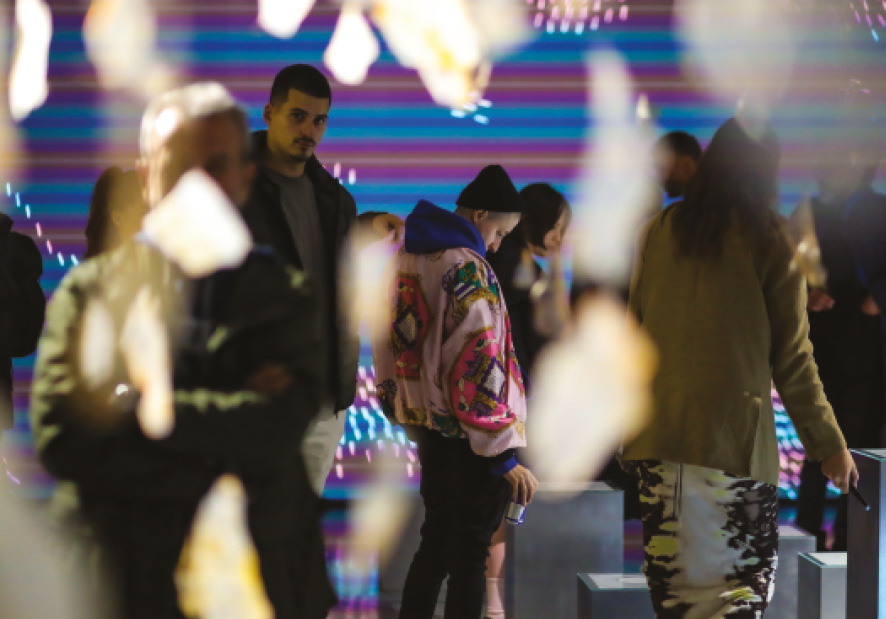
Concert of Taxi Consilium. November 2024. Photo by Mehmed Mahmutović
Footnotes
1 Musabegović, “Tradition and cultural institutions in Bosnia and Herzegovina in the jaws of ethno-nationalism and neoliberalism.”
2 Hadžiomerspahić 10.
3 Rancière 184.
4 Carlisle 7.
5 Decision of the Council of the City of Bihać, No. GV-23-4-218 of 24/12/2018.
6 Carducci 76.
7 Ibid.
8 Beth Diamond 9.
9 Innella & Petroni 10.
10 “The Studio”: Akoaki. http://www.akoaki.com/bio.html
11 Innella & Petroni xv.
12 Innella & Petroni 14.
13 Ibid. 14.
14 Hošić, “Industrijsko naslijeđe na prostoru Bihaća između realnosti i vizije.”
15 The course Design and Crisis won the PATTERNS Lectures award given by the Erste Foundation and WUS Austria.
16 Hošić, Retrografija dizajna.
17 Bradvić 19.
References
Bradvić, Sandra. “Make it, or break it.” Duplex 100m2 & Contemporary Art from Bosnia & Herzegovina / 2004-2008. Duplex100m2, Sarajevo 2019.
Carducci, Vince. “Art of the Commons: Envisioning Real Utopias in Postindustrial Detroit.” Detroit Research 1, 2014, p. 76.
Carlisle, John. Life in the Motor City. The History Press, 2011.
Diamond, Beth. “Art as catalyst for neighbourhood transformation.” The Heidelberg Cultural Village. University of Michigan, Ann Arbor 2011.
Hadžiomerspahić, Enver. “International cultural project Museum of Contemporary Art Sarajevo. General Concept.” Museum of Contemporary Art Sarajevo, Ars Aevi, Sarajevo 1999, p. 10.
Hošić, Irfan. “Industrijsko naslijeđe na prostoru Bihaća između realnosti i vizije. (Industrial heritage in the Bihać area between reality and vision).” Dizajn i kriza, 2017. https://dizajnikriza.wordpress.com/wp-content/uploads/2017/03/industrijsko-naslijedje_mart-20171.pdf. Accessed 1/5/2019.
Hošić, Irfan. Retrografija dizajna (Retrography of the design). Faculty of Technical Sciences of the University of Bihać, Bihać 2017.
Innella, Giovanni & Petroni, Marco. “Towards a definition of value Towards a Phenomenology of Value: The Value of Community. A Conversation with Anya Sirota/Akoaki.” Going real: The value of design in the era of post-capitalism. Vernon Press, Delaware 2019, p.14.
Rancière, Jacques. Dissensus on Politics and Aesthetics. Continuum, London / New York 2010, p. 184.
Musabegović, Senadin. “Tradition and cultural institutions in Bosnia and Herzegovina in the jaws of ethno-nationalism and neoliberalism.” Život umjetnosti (93). Institute of Art History, Zagreb 2013, pp. 22-35.
“The Studio”: Akoaki. http://www.akoaki.com/bio.html. Accessed 2025.
Conversation
Chiang Mai: Service and relationality in art practice
ISSUE editor Venka Purushothaman in conversation with artists Rirkrit Tiravanija, Navin Rawanchaikul, Som Supaparinya and Milenko Prvački.
This conversation occurred in Chiang Mai, Thailand, on 20 and 21 January 2025. The discussion aims to be as close as possible to the participants’ comments within their vernacular expressions and has been edited for clarity where needed. The original transcription was considerably longer; the present form is a focussed rendition.
Relating to Service
Venka Purushothaman
Today, there is a pronounced concern around service—the idea of being of service to others and to the community around us. An increasingly agitated public is calling into question the idea of public service, as seen in the political landscape.
What does to be of service mean? We want to understand artists’ perspectives on service and their understanding of the effect and affect of art on the public. This inquiry lays the basis for our conversation to understand your practice and how you have seen your work engage with the different communities that you might have been interested in engaging or new communities that might have emerged as a response to your work. We also want to understand what’s going on in Thailand, in terms of culture and art practices, and how things are shifting here. Do changes influence how you practice or make art, whether politics or technology? For example, there is artificial intelligence (AI) and it is pointless to fight it.
Rirkrit Tiravanija
That’s a service. Actually, AI is a good starting point, because I am talking to my students at Columbia University who are, you know, in that space.
I propose to them that we try to make a lazy AI, right? I want them to find a way to make an AI who refuses to be all the AI that everyone wants—in a way, that’s what the artist is, right? Always, maybe, in a way, doing things that contrast with the rest of society. In a way, we understand ourselves because we have the other, which is different from us. And the other, in this case, would be a lazy AI, you know. And what would the lazy AI be? Because, of course, it has to be or do something right. There has to be some purpose, but the purpose would be to be lazy. But how would the intelligence, or a thing that accumulates information, you know, how does that become lazy? But of course, it can accumulate and do the opposite of what everyone expects. Because one day, when there are too many AIs, you need a lazy one to stop them all, like a virus in a way.
Milenko Prvački
Knowing you for such a long time and hearing you talk about artificial intelligence and the art of being lazy—I love these terms. It’s subversive, but you talk about it pragmatically so as to mean to spoil something—this is a very artistic approach.
Rirkrit Tiravanija
For me, the idea of service seems like a transactional thing, which is always a mistake that the West makes about my work. I do not make transactional work, but people tend to think that is what I do since I give things away or make food for others. They (the West) think it is a kind of exchange of service. For me, it is a common everyday thing in my daily life with my brothers and sisters, friends, and cousins. This, for me, has been the gap of understanding and misunderstanding of what I’m trying to do and what they understand. I try to vaguely speak about this in a kind of Buddhist philosophical stance, which is, I do things because I believe the reason for my existence is different from theirs, because we are different.
I’ve always said, you know, what I do is really, really simple. I do what I do every day. And it’s not about and our existence here, at least in Thai culture, is not transactional like that.
To me, service is a kind of capitalistic understanding of exchange in a certain way, which I try to destroy by layers and ways to model our relationship to the world and, particularly, our growth.
But there’s really a big gap in understanding. Because everybody still approaches everything (art) through the object, even if we say it’s relational, they still approach it as an object. They don’t understand what relationality is because they still focus on things that are in the room. They still try to preserve the things in the room. They try to maintain them, that you know, when it’s really nothing you can keep or hold on to. It’s just like a moment of us sitting together, whether three hours or five minutes, that’s it, and the value of that is what that is. And you know that’s just - but it’s very hard for people to understand the value of that.
I just had a retrospective, A Lot of People, in MoMA (USA) this past year. And you know, all they did was try to arrange the things that were, you know, sitting there, and I keep saying, you know, it’s not about you having to use it. You can’t just arrange it as if it were that moment when it happened, right?
Venka Purushothaman
How did they respond to that?
Rirkrit Tiravanija
Respond, yes. They put a plexiglass box over the thing.
Milenko Prvački
Resistance, resistance. It’s also because they want to preserve. They want to preserve, and that’s how they accept things. You want to change, and not many people are out of the quotidian of everyday understanding. Curators today especially want everything to be readable, clear, and justifiable.
Rirkrit Tiravanija
The right part of relational structures is experience. And when I do things, I want people to understand things through their own experience. It’s not that I want them to experience this, and then they understand. I want them to understand themselves through the experience, even if it’s not easy. The experience could be very simple. So, the experience of eating together, for many people, for us in Asia, is very normal. But for 1990s New York, it was strange for some reason. It was unique as they don’t think about sharing or being together like we do in Asia. Yet, we try to catch up with the West and always model everything we do on the West, and then we end up using their structure to determine what we should do.
In Thailand, when we start to paint on canvas, it’s like moving from the temple wall to a modern structure. And there is a difference, but we must understand why we’re doing that. Why do we take it off the temple wall and put it on a canvas? It’s, you know, a Western idea, like value, to have exchange—you can actually own it, objectify it, make value out of it, and it becomes property. So, this is the point where I try to destroy that idea of property in whatever way I can.
Then there’s the visual thing, or the idea that one is visual art. It’s visual because you’re looking at it.
And to say that, well, it’s not just about looking but about understanding what you’re looking at by your own experience. There was a small retrospective show I did where I showed nothing: just an empty museum. The museum organised a tour for a dozen people, and the docent would take them through this empty museum, and they would just narrate, stop at some empty spot, and narrate what they would be looking at.
Venka Purushothaman
Your insight into unpacking the way we should necessarily look at or experience art by bringing the public to an empty space is significant. You remind us that how we look at art or how we are trained to experience art, through infrastructure or an instrumentalised curatorial approach, needs to be revisited.
Jumping off some of the points Rirkrit has just spoken about in terms of appreciating the relationship between the public and your art, Navin, could you share your experience?
Stories and Experiences
Navin Rawanchaikul
About 30 years ago, in 1995, I visited Rirkrit in New York for the first time. I mean, we, in Thailand, knew his name. Working as an artist, I was out of university for one or two years, and I brought a VHS videotape to show him what we did in Chiang Mai. As a student, before the internet, we came across his name in books and magazines. So, I went to show him what we did in Chiang Mai.
Around 1992, we, as art graduates from Chiang Mai University, started using found and existing spaces near temples and cemeteries. It was a way of finding what we could do when we didn’t have infrastructure or a gallery. We had one kind of university gallery, but it was not really for contemporary art.
But temples, you know, not just in Thailand but in Asia, are a kind of place where everything happens: education, morality, art, culture, everything. So, we use a temple for our art.
We used a public space to be very experimental in organising our art exhibition or festival. We got good and bad responses. Somebody called and complained. That time, I used my parents’ phone number and informed the state, explaining why we used a number of public spaces to show the art. We did it for three or four more years. Som, you were in the second or third, right?
Som Supaparinya
I have never participated in the festival. I was a first-year student at Chiang Mai University when the festival started.
Navin Rawanchaikul
We did for four or five years. We helped bring different artists to town and helped them produce the work. We grew from showing local Chiang Mai artists first and later more Southeast Asian, in a way.
We didn’t know each other, but when I met Rirkrit, I showed him the video. He said he would finally come to Thailand, and we could do something. At that time, I also had a project in Bangkok using a taxi as a gallery. I think he saw that, I remember, he knew what we did immediately.
So, when it came to expanding the possibilities of doing things in the public space, especially in Chiang Mai, we did not have the infrastructure but after 2000 I think it’s different. In Thailand, we have a new generation—they have galleries, Southeast Asian art market, China and everything you know.
But back to my practice, I have an interest in history, particularly local history. I work on my personal history and also work with local historians. I look back at my own Indian roots and have done a number of projects and reports on the Indian diaspora, including one in Singapore. For me, it’s a personal interest to also keep that record.
I use art as a way of recording and showing. But also, for me, it is a way of being part of my ancestry. For me, it is a kind of service.
It’s funny, but sometimes if someone’s parent dies, they call me to ask how their parents are connected or their ancestry. You know, like a historical record. It’s a little thing that I can do. During COVID, when we could not travel, I did a project on my story of my professor, late artist Montīen Boonma, trying to connect back 30 years ago when we started our project together. And it’s not just about the art, but also, you know, the historic temples. I try to bridge contemporary art and local history.
Venka Purushothaman
You talked about the relational dimension of art practice and the spaces of engagement, whether it’s a taxi, a cemetery or a temple. How has the art community responded when you move out of the white gallery box into the community?
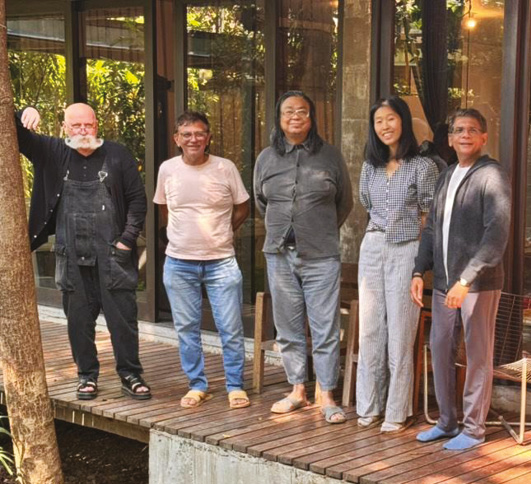
Left to right: Milenko, Navin, Rirkrit, Som with Venka in Chiang Mai, Thailand.
Courtesy of LASALLE College of the Arts.
Navin Rawanchaikul
When I was involved in the Chiang Mai Social Installation Festival, I did a project with the local community, interviewing them and capturing stories that transformed into artwork. The process was very important for me because it allowed me to meet people and spend time with them. The final artwork may be just a record, but spending time with people and learning about them is important—their story. And again, for me, what I try to do is keep that record. And you know, I mean that voice, how we can transfer everything, preserve, and maybe they may not even know what is called art.
For the local community, they think art is culture. They don’t really have the term contemporary art. It’s not a bother for me, as long as I still have this kind of invention or my way of presenting their stories. The local community, when they see it, will understand that it is okay. It is similar to when your mother looks at your work—they see the work that you do and it connects with them.
And for me, it’s the small communities that are more interesting than talking about the global moment—that I can spend time with one person or one community, and try to live or capture that experience. In my duty or role as an artist, how I can preserve and transfer that moment into so-called art or whatever media, but it’s the moment.
Rirkrit Tiravanija
To the question you ask, Venka, on the art community’s response when art moves from the gallery to the community, I would say the West doesn’t understand this kind of relational structure. Look at what happened at Documenta 15. The West doesn’t know art outside a white cube, where it can be contained. When it is not contained, it is chaos, and to them, it becomes scary. They don’t understand that their way of making art is, first of all, over.
Their way of thinking about artists is like prehistory, while the rest of the world’s understanding of art and life is completely different. They don’t understand that. They don’t know how to look at and contextualise it, so I think that’s the problem of the West. For me, having seen Documenta, standing at the front gate of the city, and you know, people are doing stuff and I’m doing what I’m doing, I watch people and it is interesting to see the response, or the non-response.
Even in a place like Singapore, people understand art as a certain kind of structure. Here in Thailand, people don’t understand it and have very different ideas about how to judge it. They don’t judge it. They want to know and understand their experience. They wouldn’t object to it. They wouldn’t question whether it’s art or what you know. That is a very free and open thing. Unlike the West, many people know critical theory and would want you to know, but not understand, because they don’t understand.
Navin Rawanchaikul
When people move from mural to canvas, you have to look at the history of education. Education makes a big difference, but we all took Western-style art education in Asia. But if you look at history in Asia, there are no borders between art and life, art and culture, and all depends on people’s local life.
Venka Purushothaman
Arts education is important, as much of Southeast Asia inherited a colonial arts educational model. It’s only through the work of artists that traditional learning paradigms came to the fore, having historically been built within communities of craftsmen and maker cultures that are deeply embedded as part of everyday life.
Rirkrit Tiravanija
In the Thai model, half of the people who went to art school were trained as craftspeople. The Italian sculptor (Corrado Feroci) invented modern Thai art when he started teaching, and you can see the aristocrats becoming artists, just as craftspeople became artists. This moment for us in Thailand should really be thought out and examined as to why we even made art.
It is important to understand the shift from craftspeople, remaining anonymous, to the emergence of a kind of auteur. You know, this moment is significant and it would make a big difference for us internally in Thailand to understand the terms of what we can do to move forward with our own art.
Because we model the West and just transfer it from wall to canvas, we are just making souvenirs, you know. For me, to make art is always to question the model; younger artists today have also learned other models. For me, my model is Fluxus, which to me is rather Asian, by a kind of mental aptitude, a desire to equate life and art. That’s a West looking at the East model. Navin’s ‘social installations’ festivals are about the material and the social relationships. You know, we have history, and we need to reinvent it. You have to bloody write it out, play it out, and show them (the West) that we have been here, like, 2000 years before you even thought that.
Milenko Prvački
You can apply methods from the West, but you can’t become someone else. And you can’t avoid the necessity of expressing whatever you are, your history, your culture.
Venka Purushothaman
I want to return to education because I think it’s an important part of how we also impact our mindset around the understanding of art and its service.
Both of you have spoken very richly about how art works quite intuitively with its respective communities. I want to ask Som Supaparinya to share her practice and respond to the conversation.
Knowledge Sharing
Som Supaparinya
My practice… I studied at Chiang Mai University, and I say that I was a first-year student during the Chiang Mai social installation festival. During my time as a student, I experienced a lot of what was going on around me, not only in the classroom, but I saw a lot of activities outside the classroom, something extraordinary, more than what we learned in the class.
It was kind of a good experience for me. But I didn’t create a lot of work out of the techniques that I learned in school, maybe only in my final years. I experimented with other techniques outside the class. I was lucky because the school focussed only on painting, sculpture, printmaking, and some photography. But the department was quite open to me doing other objects and techniques.
I could learn by myself because it’s not in-class—some installation, some conceptual works and in almost the last two years, I saw myself consuming a lot of media like radio and television. I watched a lot of films and felt that kind of technique is also part of my life. It was a big part of my life. It was not a small part, because I was obsessed with that kind of thing. I started to use that technique for my work, and I needed to learn by myself, because it’s not in-class.
In the beginning, some teachers were against the work I was doing, as it was not what they expected. But some were open to that. It doesn’t matter to me as I go with what I want to do and the direction I want to take. But I’m not against the teachers either. It was too new for them. If it was something they don’t like or something I was experimenting with, I try to assist them. I can try bridging the gap between us so they themselves can be open. I try to help them open themselves to understand my work. Even my friends in the class, who didn’t get it because it’s too conceptual or nothing beautiful, I say it is okay, you don’t like it, but it is a different way from what you are doing.
It’s more like a process, a way of thinking.
That’s how I start when people don’t understand my work. I still have that way of doing things. When people don’t understand my work, or even when they hate it or say they don’t understand it.
This approach continues for me, and I hope it’s worth the education. I want to offer a kind of knowledge, a way of thinking, or direction different from what one expects.
Then after, I met Rirkrit and got to know him. He spent a lot of time around the school. I didn’t understand his practice, but as students, we knew him as the artist who cooked some food for us.
One day, he gave a talk. I went to listen. In the beginning, my friend and I did not understand him, and we were a bit against him since a lot of lecturers say lots of good things about him, but we didn’t get it. I overcame my stupid idea and went to listen to his talk, and then it started to make sense when he explained the whole thing.
During my final graduation work, I showed some of my multi-channel video works, some live performances by musicians, and some paintings. After graduation, we had a one-day, temporary group show at a railway station. Navin and Rirkrit were also participating artists. We experimented with the specific space. It was very interesting and very fun. I learned a lot from there and started to do site-specific works from then on. I used 60 rooms of the railway station hotel to create a type of live performance with many musicians.
After this, I wanted to learn more techniques that were not available in Thailand. I want to learn about media arts, but I had no idea what media arts programmes were available in the world.
I met a German professor who encouraged me to look into studying in Germany. I applied to many schools, not knowing how to call my practice. Rirkrit knew a little about my practice and started to describe it. He wrote a recommendation letter, and with that, I applied and ended up in Leipzig. This was my first time abroad, and I had no idea what East Germany looked like. This kind of big exploration for my life was totally new.
So I learned. My first class was not video art, but web art, just when web and internet art started emerging. It was too complicated for me because you need to learn a lot of programming and writing. Then I ended up in video art, which suited me—how to say, what I liked and also the way that I want to use the art, which is about time, capturing time, because I am interested in the changes in society, landscapes and many things. I focussed on that, and until now, I have mostly used that technique .
To me, my own art practice is often separated from other knowledge services that I give to the public directly.
But as an artist, I don’t separate myself from the art world. For example, the work I do with my collective is to provide information and to exchange knowledge services. But we never aim to produce any artwork together. Each of us produces artwork individually.
In Chiang Mai, beginning maybe in 2013, we (as collectives) began creating art maps to know what the art community in Chiang Mai looked like. And not only that, we all wanted to share that information with whoever comes to Chiang Mai and wants to see Chiang Mai or experience the art community, art space, or exhibition in Chiang Mai.
They can look at the map and go directly there.
It is a public service with the information that we want to provide. But we never created any artwork together. We have an individual interest in our artwork. We worked with Thailand Creative and Design Centre (TCDC) because people saw the city as an art city once we started the art map. They used the information to create a festival, an art festival, and later, after that, we got a grant from the Japan Foundation to be its partner to make a small art space to create an expert exchange between artists in Southeast Asia and Japan. We invited artists, scholars, or whoever we thought was interesting to do some knowledge sharing or some practice—something we were missing in Chiang Mai.
But what is a good show? Can we create a lot of activities—which did not happen enough— with talks, knowledge sharing, and activities that would be useful to artists in Chiang Mai? Japan Foundation chose Chiang Mai because it is not the centre (Bangkok). We needed to create our own profile because the centre doesn’t give us anything. The main media especially is never in Chiang Mai. There are a lot of artists here and very active, but because the media is not covering it, it is not noticed or recorded, you know? So that’s why we started to do these kinds of knowledge projects, because it’s important. It is not part of the Thai art story, so we [need to] do it.
Openness and Being Open
Rirkrit Tiravanija
What Som is saying is interesting. Chiang Mai is the periphery. I prefer it. This is also important and all three of us, and many people, artists here are involved with a more communal structure that is of service to each other.
We formed a group. We have the Land Foundation, and my neighbour has a museum. But to me, it’s all part of our work. In the West, they don’t understand that. Let’s say they know you and they know you only through the museums. I’m doing many things I don’t claim as art. I don’t sit around saying this is art and I’m making this.
The last thing I want to do is think that what I’m doing in the world is art. And this is the thing. We don’t think that way. We do things with the community because that’s how we work. That’s how we again don’t think of art as an object we have to claim, name, or define, which is a very Western process of understanding. They don’t understand when you don’t define it. They don’t understand when you don’t have a goal or expectation.
Milenko Prvački
You can’t justify what you’re doing.
Rirkrit Tiravanija
That’s the thing that is very different. The value that we have in this kind of discussion is not to not be defined. In fact, everything we do could be art. I could just be making pad thai noodles on the side of the road for the rest of my life. But the way I do it, everyone has company.
Venka Purushothaman
You talked about people’s struggle to understand your work and process. They are struggling because they have all these structures from which they seek to appreciate your work. It prevents them.
The work of all three of you calls for an open space for engagement. Our understanding of being open in Southeast Asia is quite different from the understanding of being open in the Western context, even though the concept of the ‘open’ has been theorised extensively, especially in anthropology. The moment you work within the community or a communal space, the anthropological lens immediately kicks in, alright, without the lived experience or the experience the public has. Openness seems to be construed to lead to confusion, which we saw in Documenta. But interestingly, it was not the experience of that openness that functioned, but the obsession with the object that triggered controversy. So, I’m kind of interested in the struggle of the ‘open’.
Rirkrit Tiravanija
This is my generation of artists questioning authorship and rights, which has already happened in previous generations. It’s a post-colonial question: Who is calling and naming what? Who is writing their name to? The idea of appropriation, appropriated art, is ongoing.
I mean, those things were there. The question, you know, should not be a question anymore about who makes the art, because the art is just an idea. I question how we even look at an object. Even conceptual art ends up becoming an object. Because they need to hold on to something material, be it a sheet of paper that says, “This is conceptual art;” they do still want that paper.
Venka Purushothaman
What’s powerful is that you empower people through your practice to be who they are, something that no longer happens in museums and galleries.
The Future of Museums
Rirkrit Tiravanija
Not anymore, not anymore. That’s right. I mean, museums. There are not the same kinds of experiences that the Museum of Modern Art used to have. You know, the museum itself changed, and they changed from being a place of art to a place of value. It was a place where you could experience different ideas, and now it’s just different values of things—that’s become part of the problem.
Venka Purushothaman
Or even the biennales.
Rirkrit Tiravanija
Well, biennales have closed themselves off— to become more regulated.
Milenko Prvački
To name, to classify, to put on shelf has become a necessity. Just as Som said about categorising her art practice, many museums don’t know where to put it or how to name it. If we, as artists, make a mistake, there’s no victim, but they’re afraid they will be victims because everything is so organised. See, every museum has a section for kids. It’s like kindergarten. It’s wrong, they don’t learn anything. Artists are no longer going to museums; there’s nothing for them.
Navin Rawanchaikul
The role of the museum has changed over time. Museums are strong in the Western context. In Asia, the local culture is the space, and there is no idea of a museum. In Thailand, we have a lot of national museums trying to preserve the artefacts, but they do not really connect.
Museums have to update if they want to continue to stand and be of service.
Rirkrit Tiravanija
Navin does his work in public spaces. It’s like a museum show in the market, but he also does a museum show in a museum.
And I would say, that museums need to go out [of the museum space]. If they cannot, you know, they cannot ‘cook’ (a reference to his pad thai work).
Venka Purushothaman
What is the relevance of a museum today, then?
Rirkrit Tiravanija
I still think it’s a place of knowledge and understanding. It can have experiences, even though they tend to over-explain everything before you walk in. Museums are an archive. It is an encyclopedia. But it also needs to address itself and use itself as such.
Milenko Prvački
But it’s conditioned. I mean, you are right, but the time is different. The speed is different. You know that the changes in this world are not happening every 2000 years or 300 years. The museum has to deal with the speed of change and what it seeks to represent as a place of knowledge where we can learn.
Navin Rawanchaikul
The effect of the object is still relevant to help people connect to the present. But perhaps, without museums and galleries maybe there will be more freedom, just like Thailand 30 years ago yeah?
Som Supaparinya
Dry exhibitions, objects and no activity. The museum doesn’t allow us to interact. It seems a little bit strange to experience that big museum with an object that has no activity around it.
I was thinking, if you should want to do something in a museum, yet you can’t, because the museum will say: Oh, temperature has to be this; that it will activate the alarm; and all these kinds of things are limitations to if you want to get out of box.
Venka Purushothaman
Museums are still relevant in many ways, but they need to find their own space as centres for the transmission of knowledge. How do they do that? Of course, a lot more museums globally are getting more people doing research and writing, but there’s no transmission to the general public. It is only functioning to archive. Ultimately museums are there to inspire the public not just be a mere record keeper. That’s why it’s called a muse!
Education in the marketplace
Navin Rawanchaikul
The art market has also changed the perception of art. When I started out, we even didn’t think about selling work.
Rirkrit Tiravanija
Yeah, we just do it.
Navin Rawanchaikul
We do it. But now, before you do something, your teacher or someone who has market experience will try to tell the student: “Okay, you have to use this kind of material to market your work.”
Today, art students are taught how to advertise, find clients, and manage themselves. Thinking about how to present the work, find a client, or network is good, but this is not about the content of the work.
Universities, as places of knowledge creation and contestation, are changing, as are arts institutions. I am interested in the value of an educational environment. They were safe spaces, but no longer are.

Seated left to right: Navin, Milenko, Som, Venka and Rirkrit in Chiang Mai, Thailand.
Courtesy of LASALLE College of the Arts.
Rirkrit Tiravanija
At least in the art world, that’s part of the problem. The idea of a safe space has become another thing. The institution is no longer about knowledge and exchange but a bureaucracy of safe spaces. As cultures change, institutions become overly protective of themselves, just as museums are no longer as open or experimental, or as a place where real art can be made without limitations. You know, because they’re all trying to keep within a safe space (from being sued).
Milenko Prvački
It is opposite to the role of artists and students in art. You know, we are teaching them to open doors and windows, fly, and take risks. But we behave more and more with rules and regulations. Everything is planned and done in advance. There are no surprises; it’s safe. It’s a world that I find is wrong for art.
Navin Rawanchaikul
When it comes to art school, an Italian man made a legacy here and played an instrumental role in the founding of Silpakorn University. When Chiang Mai University was founded about 60 years ago, it took almost 20 years to set up the art department.
Venka Purushothaman
How do artists negotiate that space where the weight of history and tradition are central?
Rirkrit Tiravanija
Institutions are afraid. I have never gone through any of the systems here in Thailand. They have no idea who I am or what I am, which is also part of the mistake, because I’m a person who’s totally open to the old and the new. We have to look at those who make mural paintings on canvas and acknowledge that they are part of the history. It’s not something I’m against. I wouldn’t do it. But on the other end, they are afraid that I would come in and destroy all of that. I’m not interested in doing so. I’m interested in making a better system.
The reason I’m interested in coming to Chiang Mai, I would say, is that the school here is an alternative to Bangkok and much more interesting. So, I wanted to support that. And I have no interest in position, rank or name or money. I would do things for free if they would ask me properly. I did do lot for them even when they rejected me.
Som Supaparinya
As a student, the situation was quite free, and there were a lot of experimentation. The university was quite free. I choose to study painting, because it was the only department at that time that was open for me to do other techniques. It did not matter to them—a golden time for the department. But then they started to fix the curriculum.
Navin Rawanchaikul
By technique.
Som Supaparinya
They separate [the curriculum] by technique and you can’t cross to other techniques. And it’s very difficult. We should have more freedom. But we do not. The university has become a business and the government does not really help.
Navin Rawanchaikul
They [government] do not subsidise them anymore, or subsidise a little bit, so then the university has to make money. Would be good if this can be made clearer. What I mean is, less subsidies to the public universities lead to their being forced to make money.
Som Supaparinya
It’s very strange. It has changed a lot because of the political movement in Thailand in the past 20 years. A lot is happening, and the conservative way of controlling the university is getting stronger. Because of student movements, they need to control the university very strictly. They hire more and more conservative staff as Dean to lead to control. That’s how it has changed a lot in the Thai art community. There is conflict within the faculty.
Rirkrit Tiravanija
The institution no longer cares about the knowledge exchange; they care about money, and because of money, they have to make these very specific choices. University is a place of transaction. Therefore, they cannot let me call my class “How Not to Make Anything” because that is against the transaction. You see, I’m not, you know, to teach people not to make anything, is what. But like they, what are they going to get? You know, they’re not going to get anything if they don’t make anything, you know.
Venka Purushothaman
Jumping in, as a response to the over-institutionalisation and transactionalisation of arts education, I’m seeing this kind of informal pedagogy emerging, not in institutional places. Artist studios are becoming pedagogic sites, sites of really collective ways of thinking, new ways of engagement, and new ways of learning.
All of you referred to the structural system of ceramics, printmaking, painting and all of that, and the importance of freedom and what freedom meant. But what does freedom look like in the institutional system, other than being able to explore different things?
I’m interested in hearing about what kind of spaces of new learning are emerging, or spaces for unlearning. I use the example of the artist studio as a space.
Rirkrit Tiravanija
We have been trying to create new spaces. I don’t even want walls and I do not need walls to burn. I just need nothing. I just need an empty space and empty mind. It’s about the fact that there is a space, and if you want to use it, it’s there, it’s free, you know. And so, and if they don’t want to use it, you know, it’s there, it’s free, you know.
People who want to think and be artists will come and find the space. They will come because they want it and in order to find themselves. They need to sit and think and talk, listen to other people argue, and think, you know, really think.
Venka Purushothaman
In a market economy, the time from the art school to the museum space is very short. Time is truncated.
Navin Rawanchaikul
I think the art market is key, because in education, we never thought about how to sell. I mean, we don’t know how to sell the work. Of course, we want and need money to live, right?
Rirkrit Tiravanija
The time between making and showing is shorter because it has become about production—a product. And becoming a product means that there’s no critical space. There’s no critical time in space. The critical space now is whether people buy art or not. It’s not about whether the idea is interesting. Success and failure are based on sales.
Criticality now comes from lifestyle magazines—persons to watch! There is hype. What is hype? Hype is like a kind of transactional structure, which, you know, puts a value on something. Who knows if it’s actually real, right? So there is no criticality there. It’s just hype.
Hype makes a market. The market buys, and then, you know, they buy and buy, making a thing valuable. There is no real content there. There’s no real soul there. There’s no real artist there. It’s just technical, it’s just colourful, you know, whatever it’s the skin. And then it fails, and then the artist has failed, then the artists are stuck with, like, the fact that they fail in the market, and their work is like worth nothing, you know, so it’s not the value of the art at all.
Navin Rawanchaikul
They don’t teach about the market. Of course, you need to understand the market, but they don’t really teach as to what the market means and how you can work with it.
Som Supaparinya
My case may be different because I am always looking for funding to produce my work, my research, and all kinds of processes. I know that my work won’t sell, and most people are not really buying my work, so I know that, and I need to. That’s why I need to focus on where the money comes from that I can get support. I need to find funding all the time.
On Influences
Venka Purushothaman
I want to hear about your influences.
Rirkrit Tiravanija
Well. I mean, you know, partly, of course, the work is also not just about me. It’s also about everyone else.
Navin Rawanchaikul
I enjoy working with communities. But when I work with people who are not art people, I would say, like, it’s difficult when you have to explain the process to them or get them information, but they really enjoy it. I mean, it’s that kind of direction, I would say, in Niigata, Japan. Also, I did a few projects, one in a very remote village. They didn’t know why this foreigner came and spent time interviewing them, but when they saw the work, they really appreciated it, and now they keep it. There are only 40 people living in that remote village.
Venka Purushothaman
That means the community owns the work.
Navin Rawanchaikul
They feel ownership.
Som Supaparinya
One Berlin residency I did, they did not pressure me to do anything. My one-year residency was only a research proposal, not to produce anything at all, no new work at all, which is okay.
Venka Purushothaman
It’s interesting how we try to look at the value. And I think all three examples actually removes you, removes you away from the art. It’s the work that speaks for itself. The process works for itself. It comes back to what you are saying, which is that the place of art in the lived experience starts to matter more. You know, rather than shifting away from the utopian object-centric, even though the art market focusses on that kind of an experience for a particular type of audience, there is that space where the lived experience matters, that temporality, you know, the time-based moment, whether it’s fixed or not.
I want to bring our conversation to a pause as these conversations will continue. Could you share your favourite followers, besides family, in terms of your practice? In terms of communities of people. For example, you talked about the people in the marketplace right who follow a particular work. Is that particular community that kind of, you never expected, but a group of people or an individual following your work, which you never anticipated? Have you had that kind of experience?
Rirkrit Tiravanija
My mother, you know. Once she knew what I was doing, she read everything not just about me about all my friends. She completely understood what I was doing and understood it through...I mean, the fact that, you know, I explained my relationship to how I grew up with my grandmother, and she completely understood that it was about, you know, yeah, being with other people, and, in a way, giving, but without that idea of, you know, transaction, right? And that could be giving knowledge, could be giving food, could be giving, you know, a smile. But it’s not about like getting anything back from it, you know. It’s just about how you exist in the world. That’s what you do.
So, I was also kind of, on the one hand, surprised, but on the other hand, you know, happy and understood, of course, because that’s our culture. She understood it because, you know, it’s not complicated, yeah.
Navin Rawanchaikul
Before my dad passed away, I spent more time close to him, and I also worked with him, but the effect on the history of my work is felt more in different communities. I always enjoy seeing how people react to my work. My uncle, my mother’s younger brother, just passed away. He convinced my mom to let me go to art school.
Som Supaparinya
My family does not support me to study art, but they have not stopped me; they couldn’t stop me—when I was 14 I told them that I wanted to study art.
From there, I just lived my own life and asked them for support. My sister studied art also, but she does not really know much about my work. But the good thing about her and her husband is that they helped me a lot when I needed to write a lot of essays in English because her husband is British and is good at writing. He helped me to edit, and they understood my work through that editing process.
On relationality and understanding
Venka Purushothaman
You have all have been written about quite extensively—always someone giving voice to who you are and what they think you are. Is there something that historians and writers have completely missed about you, and there is a part that never gets written?
Rirkrit Tiravanija
I don’t go and read these things or edit anything I say. There’s a book about me that has been translated into Thai. You know, it’s like a textbook about my work. I’ve never read it, but my feeling is that they don’t understand that I’m not from the West. They don’t understand me. I think differently. I am different, and I see the world very differently. And that difference is always something they don’t understand, and they’re incapable of writing about it.
Venka Purushothaman
It informs you of your relational setting that is central to you.
Rirkrit Tiravanija
But I don’t think they understand what relational means. Sometimes they call me the godfather of relational aesthetics. I disagree with the aesthetic part, because it’s not about aesthetics. It’s never been about aesthetics, a Western idea of how things are. I’m just interested in the relation, you know, and that they don’t understand, you know, they don’t, they haven’t really, and in that sense, because they don’t have a relation, I think.
Navin Rawanchaikul
For me, it’s more about how I see things and when I look back at my work, different generations will view it differently. I see this in my daughter, and I can pass on my ideas while also understanding that each person has a different view and way of their environment and life. It’s more about how you look and then look back again at your work and how you somehow understand yourself. That is how you make your art, why you make it. It is really for artists themselves to understand. To do the work, you must understand what it means.
My daughter wants to meet Rirkrit, a role model. She asks, “Can I eat his food? His food is art.”
You have to understand the artist by their life. This is something I see and try to convince myself of every morning. When I wake up, I need to know what I mean, say what I mean, what I feel and what I need to do.
Venka Purushothaman
So you feel that this part of the artist’s life is not discussed or does not emerge in art writings?
Navin Rawanchaikul
Either there are presumptions made, or it is ignored.
Rirkrit Tiravanija
I understand what he said. Writers and curators focus on the object as art, and they don’t focus on the bigger picture.
They don’t understand why Navin needs to go to the community and talk to people, and work with other people to make a representation of all these people, because the stories of things that people we don’t know. And, you know, I mean, they don’t understand. It’s Navin, that he can talk to all these people that he loves to speak to people that he could, you know, he can be in a community of strangers, and he will find his way to, like, drink and eat with them, you know, but that’s not going to be written because they are just looking at the object.
Milenko Prvački
Absolutely agree. They are looking for narratives that they can edit to recreate your work.
Som Supaparinya
Most writers focus on the final work itself and the subject. They are not interested in me as an artist. They focus on that particular area ignoring the source: that is, why I am making it or my environment. Different writers know different aspects of me and you cannot see the full spectrum of me in any one writing.
Rirkrit Tiravanija
Well, they are writing with their own perspective, their own interests and with their own knowledge. So, of course they will focus on only what they know.
Venka Purushothaman
Misunderstandings are also fundamental to a process of engagement.
Milenko Prvački
Writers and curators have their own agenda, and they unpack your work and pack it in their own way. But family is honest and curious.
Venka Purushothaman
We teach art history, but it is not seen as lived, that is, worked through with artists. Unfortunately, the limiting factor is retrograding history. So, we have to continuously puncture our way through to reach out to artists and their communities and bring a piece of yourself into that space.
Som Supaparinya
I have one story I like. A few years ago, I went to see the artist, Andy Goldsworthy. We talked a lot—our practice, his practice and my practice. And I also talked about how I produce my work in very challenging spaces like rivers. At the beginning, he was not really interested, just listened a little bit. And then at the end of the story,
I told him: “you know, I can’t swim, and I am scared of water.” He started to laugh, became interested because the way to see it is not only the process of the work and the product itself, but also to see what’s inside the artist and what drives me to work on it. It was a conversation that you don’t have in public.
Rirkrit Tiravanija
When I teach, or whenever I talk to younger artists, I don’t focus on what’s on the wall or what’s working. I focus more on what they’re thinking. So, I talk about thinking.
I like to know where they came from. I like to know what they eat. There is too much information about what they as artists want to make. But knowing them, I can see the problem that they’ve made. But, of course, I’m different. I mean, at Yale School of Art, they just only talk about what they see on the wall, you know. They won’t talk to you about how you are. And it’s two very different ways of thinking about art, you know.
Milenko Prvački
We all carry our history, we carry our geography, we carry our culture, we carry but it’s something very individual. It’s a kind of language, you know, language that we build up. But they’re (writers) not interested in this. They’re still talking about style, you know.
Venka Purushothaman
Because of what you all describe, we want to hear you and give voice (your voice) to this conversation. The artist’s voice is one of the most misunderstood spaces in the art world and in art practice itself.
Thank you for such a deep sharing. It gives me a small understanding of what is happening in different parts of your own practice and how it manifests itself in terms of the service that we do for ourselves, others, and society.
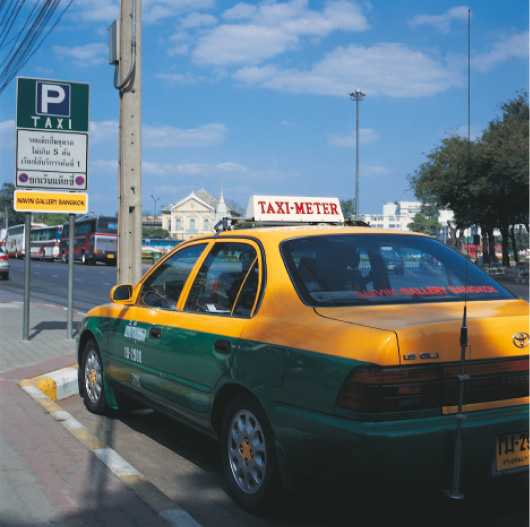

Navin Rawanchaikul, Blossom In The Middle Of The Heart (City), 1997
Reproduction of a mural painting by Khrua In Khong in collaboration with Sutthisak Phutararak
Navin Gallery Bangkok. Courtesy of Navin Production.
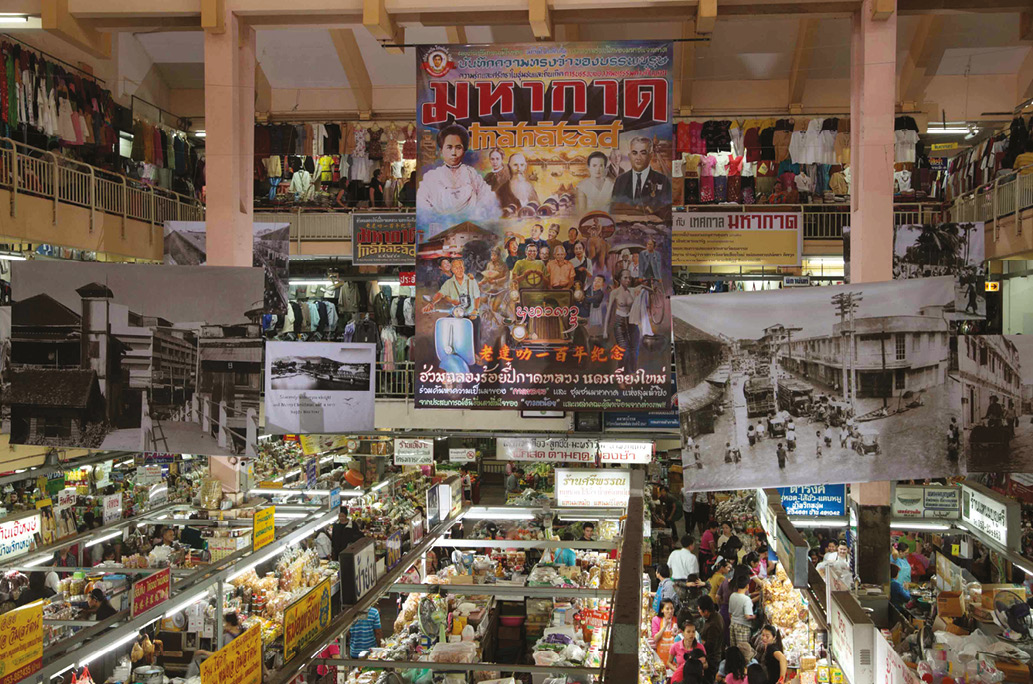
Navin Rawanchaikul, Māhākād (2010)
Chiang Mai, Thailand. Courtesy of Navin Production.

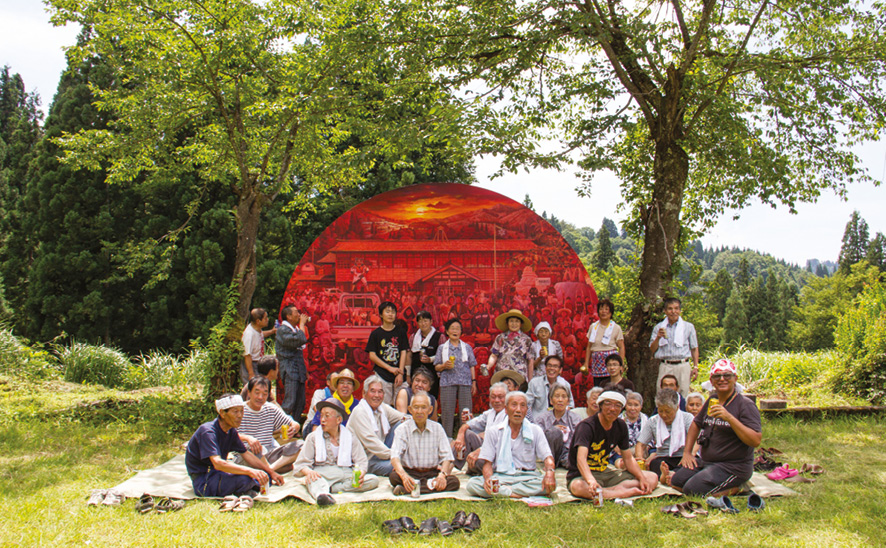
Navin Rawanchaikul, School of Akakura (2015)
Echigo-Tsumari Art Triennale, Akakura village
Tokamachi, Japan. Courtesy of Navin Production.

Navin Rawanchaikul, Once Within Borders (2023)
Thailand Biennale Chiang Rai 2023
Golden Triangle Viewpoint, Chiang Rai, Thailand. Courtesy of Navin Production.
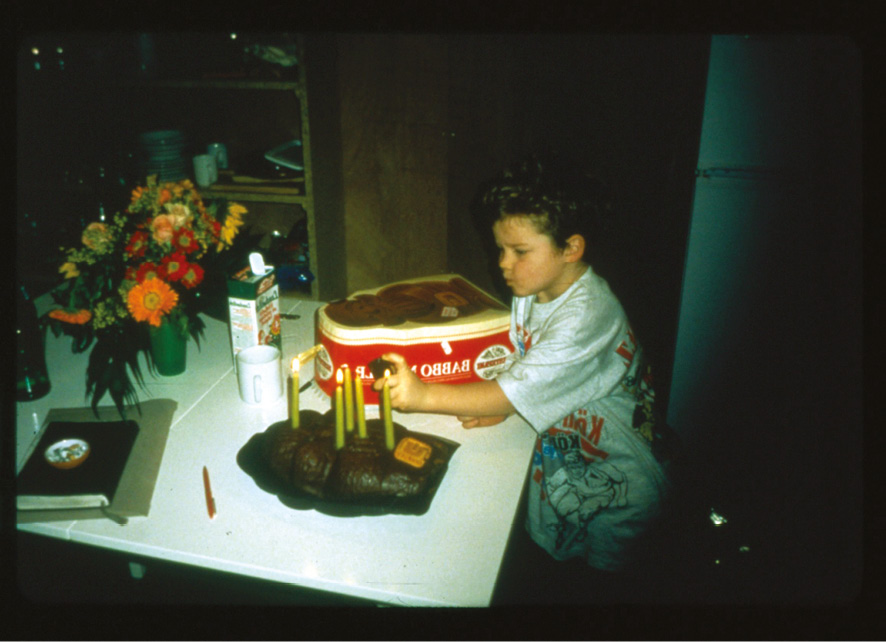
Rirkrit Tiravanija, untitled 1996 (tomorrow is another day). Courtesy of the artist.
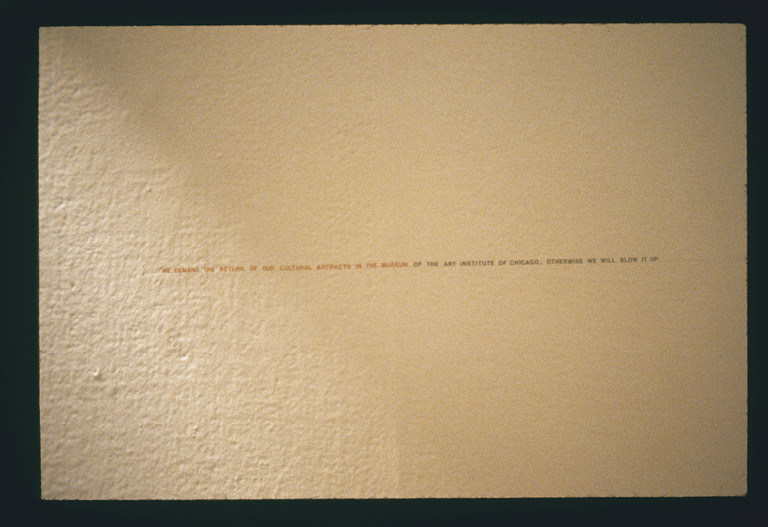
Rirkrit Tiravanija, untitled 2002 (he promised). Courtesy of the artist.
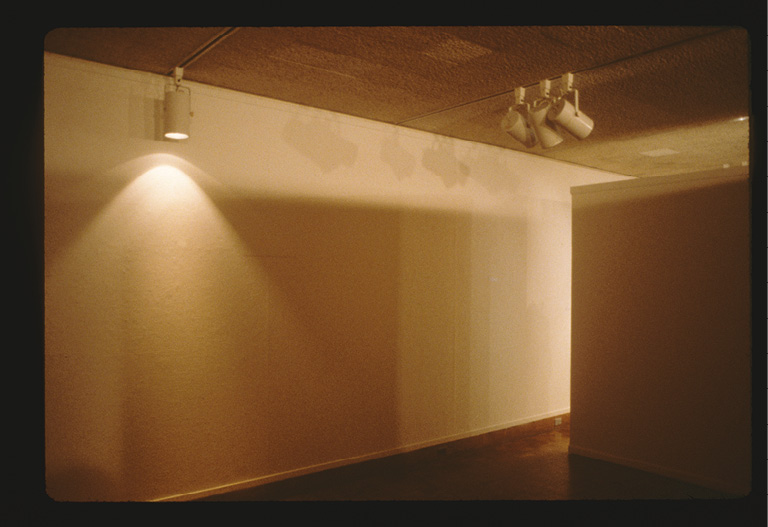
Installation view: Rirkrit Tiranavija, Secession. Vienna, 2002.
Photograph by Matthias Hermann. Courtesy of the artist.
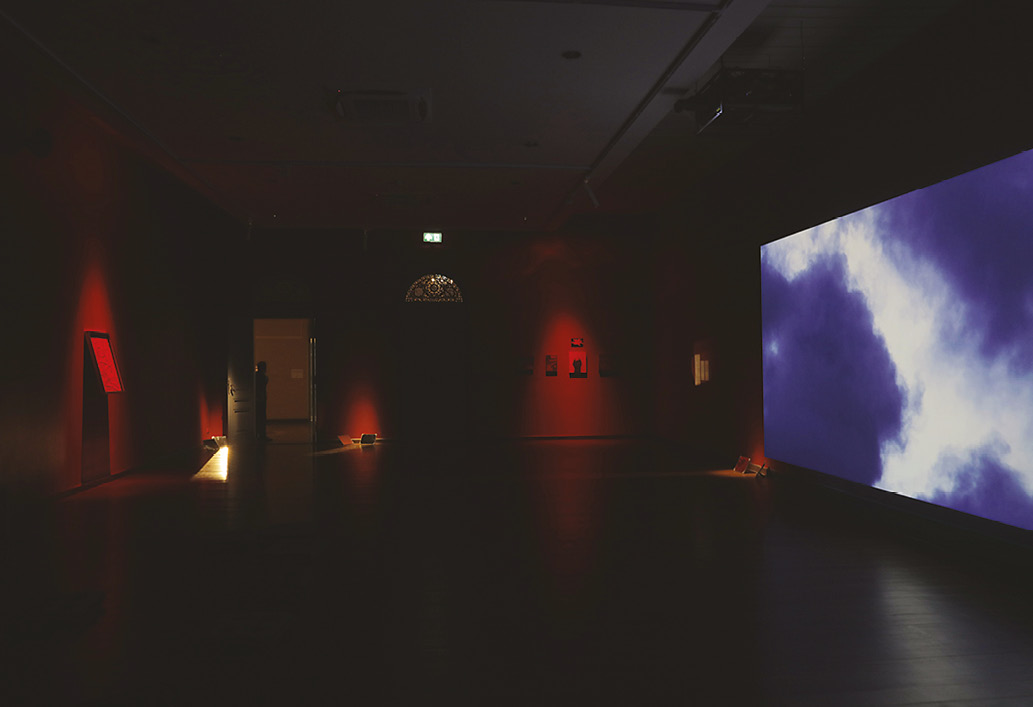
Som Supaparinya, The Rivers They Don’t See (แม่น้ำที่เขาไม่เห็น). Synchronised 2-channel video and other objects, 2014. Installation at National Gallery BKK, ©Kornkrit Jianpinidnan.
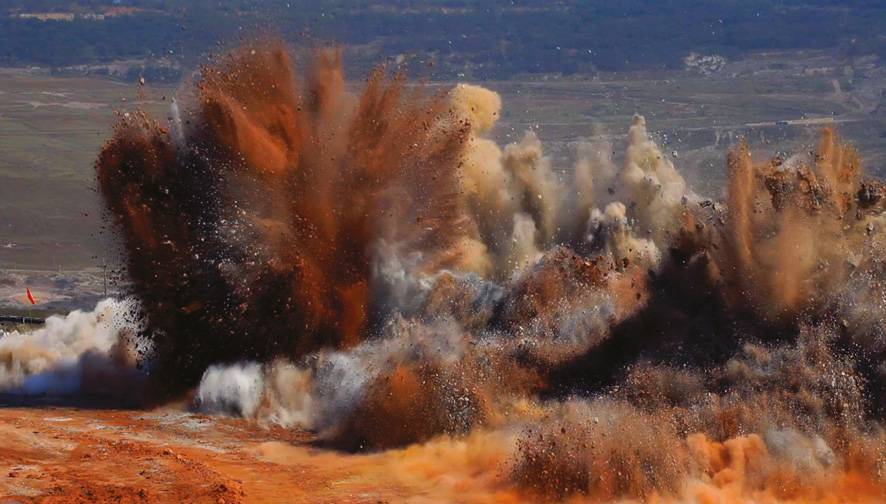
Som Supaparinya, When Need Moves the Earth. Synchronised 3-channel video, 2014.
Still from video, ©Som Supaparinya.
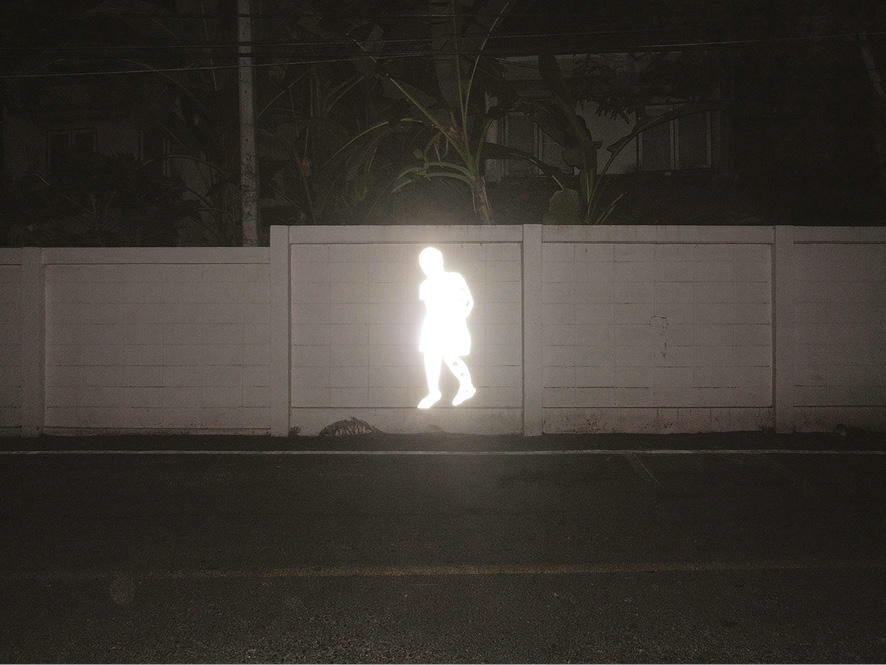
Som Supaparinya, White Shadows, 2012. Photo by Ded Chongmankong.
Contributors’ Bios
Contributors’ Bios
Ute Meta Bauer (Germany/ Singapore) is a curator working on transdisciplinary formats including art, film, performance and sound. She is Professor at the School of Art, Design and Media, Nanyang Technological University Singapore and Principal Research Fellow at the NTU Centre for Contemporary Art Singapore. Bauer is the lead Principal Investigator on the Climate Transformation Programme – Sustainable Societies cross-cutting cluster, headed by the Earth Observatory of Singapore. Most recently, she served as Artistic Director of the Diriyah Contemporary Art Biennale 2024 and was editor of the biennale reader After Rain, co-published by Hatje Cantz and Kaph.
Tamares Goh (Singapore) is an art administrator, educator, and artist. She holds a BA in Fine Art from LASALLE-SIA College of the Arts (1996) and an MFA from the Glasgow School of Art (2001). From 1996 to 2003, she taught intermittently at LASALLE and was actively involved in exhibitions and artist residencies. In 2003, she transitioned into arts administration roles at Esplanade – Theatres on the Bay, where she has since developed and curated numerous festivals and visual arts programmes. She currently leads the Visual Arts programme at Esplanade. In 2013, she served as co-curator of the Singapore Biennale and in 2017, she produced Dapunta Hyang: Transmission of Knowledge by Zai Kuning for the 57th Venice Biennale.
Irfan Hošić (Bihać) is Associate Professor of Art History at the University of Bihać and founder of the KRAK Center for Contemporary Culture. He co-curated the Bosnian pavilion at the Venice Biennale in 2013. He is the author of two books: Iz/van konteksta (Connectum, 2013) and Slika krize (Buybook, 2025). He was curator-in-residence at the Singapore Art Museum (2024), Fulbright Visiting Scholar at the College for Creative Studies and Wayne State University in Detroit (2019/2020). Hošić holds the Igor Zabel Grant Award (Igor Zabel Association for Culture and Theory, 2024), the Patterns Lectures Award (Erste Stiftung and World University Service Austria, Vienna/Graz, 2016) and the Culture Watch Award (Balkan Investigative Reporting Network, Belgrade 2012).
Denise Jambore (Bucharest, Singapore) is a curator and writer specialising in art theory and philosophy, with a particular focus on the concept of invisibility. Her curatorial practice includes exhibitions at major institutions in Europe and Asia such as the Centre Pompidou, Paris as well as being a Research Fellow at the National Museum of Modern and Contemporary Art in Seoul. She is also the founder of a museum dedicated to art and recent history in Port-au-Prince, Haiti, established in collaboration with a humanitarian organization. Denise has lectured widely on her research and authored several books exploring the intersections of aesthetics, politics, and the unseen.
Ng Mei Jia (Singapore) is a researcher whose interests lie at the intersection of cultural practices, spirituality, religions, and their entanglements with the environment. She is a Research Associate at the School of Art, Design and Media, Nanyang Technological University Singapore, under the Climate Transformation Programme – Sustainable Societies cross-cutting cluster, headed by the Earth Observatory of Singapore. She was previously a Research Assistant on the MOE AcRF Tier 2 Climate Crisis and Cultural Loss research project, led by Professor Ute Meta Bauer.
Dev Nath Pathak (New Delhi) is Associate Dean at the Faculty of Social Sciences, South Asian University, New Delhi. He has been endowed with several fellowships and grants, including by the Charles Wallace Trust and Indian Institute of Advanced Study. He researches and writes on performative expressions and cultural politics in South Asia, epistemological issues in social sciences and the sociology of literature and art. Some of his monographs include In Defence of the Ordinary: Everyday Awakenings (Bloomsbury, 2021) and Living and Dying: Meanings in Maithili Folklore (Primus Books, 2018) and some of his edited books are Another South Asia! (Primus, 2018), Performative Communication: Culture and Politics in South Asia (Routledge, 2018), Investigating Developmentalism: Notions of Development in the Social Sphere (Palgrave, Macmillan, 2019), Seeing South Asia: Visuals Beyond Borders (Routledge, 2022), Neighbourhood and Neighborliness in Urban South Asia (Routledge, 2022) and several research articles in journals. His recent book is To Be or Not to Be Sociological: Methodological Ways of Seeing (Bloomsbury, 2025). He also edits a journal, Society and Culture in South Asia (co-published by Sage).
Navin Rawanchaikul (Chiang Mai, Thailand) is a Thai artist whose ancestral roots are from the Hindu-Punjabi communities of present-day Pakistan. Questioning systems of artistic creation and presentation, Rawanchaikul has developed a vast body of work that utilises the spirit of collaboration. His socially-engaged multiples are often presented under the banner of Navin Production. In his practice, Rawanchaikul engages with the process of exploring the ongoing negotiation between local circumstances and unavoidable globalisation, and more recently, a focus on personal history and memory, which he explores through direct public interventions and an innovative style of integrating community. Rawanchaikul has participated in many international art festivals, while his solo exhibitions have been held at international galleries and art institutions including New York’s P.S.1 Contemporary Art Centre (2001), Palais de Tokyo in Paris (2002), Jim Thompson Art Centre in Bangkok (2006), Ullens Centre for Contemporary Art in Beijing (2009), MAXXI in Rome (2021-22) and Neiwei Art Center in Kaohshiung (2022-23). His works are housed in prestigious collections including the Guggenheim Museum in New York, Queensland Art Gallery in Australia, Pinchuk Art Centre in Ukraine, Moderna Museet in Sweden, Instituto Inhotim in Brazil, M+ in Hong Kong, National Art Gallery Singapore, Fukuoka Asian Art Museum and Mori Art Museum in Japan. In 2010, Rawanchaikul was awarded the Silapathorn Award from the Thai Ministry of Culture in the field of Visual Arts. He also represented Thailand at the 54th Venice Biennale in 2011. The artist divides his time between his family in Fukuoka, Japan, and his hometown of Chiang Mai, where his Navin Production team and studio are based.
Som Supaparinya (Chiang Mai, Thailand) studied painting in Thailand and Media Arts in Germany. Her works encompass a wide variety of mediums such as installation, objects, still and moving images which are produced mainly with a documentary and experimental approach. The works focus on the impact of human activities on other humans and landscape through political, historical and literary lenses. Her works are stories on noodle cultures, the change of the riverscapes, cityscapes, routes, electricity generation, wars, resistance sites and banned books. In 2025, she is currently working on Collapsing Clouds Form Stars, a Mini Retrospective of Work (Gallery Ver, Bangkok); The Shattered Worlds: Micro Narratives from the Ho Chi Minh Trail to the Great Steppe (BACC, Bangkok); Melted Stars (DAAD Gallerie, Berlin). She is a winner of the Han Nefkens Foundation –SouthEastAsian Video Art Production Grant 2024 which commissioned her new work followed by exhibitions at six locations across Asia and Europe.
Rirkrit Tiravanija (Buenos Aires, Argentina) is widely recognised as one of the most influential artists of his generation. The Thai artist defies media-based description, as his practice combines traditional object making, public and private performances, teaching, and other forms of public service and social action. Winner of the 2005 Hugo Boss Prize awarded by the Guggenheim Museum, Tiravanija was also awarded the Benesse Prize by the Naoshima Contemporary Art Museum in Japan and the Smithsonian American Art Museum’s Lucelia Artist Award. He has had exhibitions at the Museum of Modern Art in New York, the Guggenheim Museum of New York, Gropius Bau Berlin, Los Angeles County Museum of Art, the Hirshhorn Museum (Smithsonian Institute), Glenstone Museum, Luma Foundation in Arles and at the Museum Boijmans Van Beuningen in Rotterdam, afterwards presented in Paris and London. Tiravanija is on the faculty of the School of the Arts at Columbia University, and is a founding member and curator of Utopia Station, a collective project of artists, art historians, and curators. Tiravanija is also President of an educational-ecological project known as The Land Foundation, located in Chiang Mai, Thailand, where he maintains his primary residence and studio.
Tang Da Wu (Singapore) is an artist and educator known for his multidisciplinary approach and strong engagement with social issues. He received his BA in Sculpture from the School of Fine Art, Birmingham Polytechnic in 1974 and continued his studies at St Martin’s School of Art, London before completing an MFA at Goldsmiths, University of London. Tang works across a wide range of mediums including installation, drawing, and mixed media—it is especially in performance art that he finds an immediacy and ability to foster direct, personal communication with audiences. His work often challenges societal norms and reflects on cultural and environmental concerns.
Milenko Prvački (former Yugoslavia/Singapore) graduated with a Master of Fine Arts (Painting) from the Institutul de Arte Plastice “Nicolae Grigorescu” in Bucharest, Romania. He is one of Singapore’s foremost artists and art educators, having taught at LASALLE College of the Arts, Singapore since 1994. He was Dean of the Faculty of Fine Arts for 10 years, and is currently Senior Fellow, Office of the President at the College. He also founded Tropical Lab, an annual international art camp for graduate students. He has exhibited extensively in Europe and USA since 1971, in Singapore and the region since 1993, most notable of which was the Biennale of Sydney in 2006. He has participated in numerous symposiums and art workshops worldwide, and acted as visiting professor at Musashino Art University in Japan; Sabanci University in Turkey; and University of Washington School of Art + Art History + Design, USA. He is Adjunct Professor at RMIT University, Melbourne, Australia. He was awarded the Chevalier de l’Ordre des Arts et des Lettres from France in 2011, and Singapore’s Cultural Medallion for Visual Arts in 2012. In 2020, he was awarded the National Art Award, Serbia.
Venka Purushothaman, PhD, (Singapore) is Deputy President and Provost at LASALLE College of the Arts, Singapore. He is an award-winning art writer with a distinguished career in the arts and creative industries in Singapore. He speaks internationally on transformative art and design education and works to enable the development of cultural leaders in Southeast Asia. Venka holds a PhD in Cultural Policy and Asian Cultural Studies from the University of Melbourne. He is a member of the Association Internationale des Critiques d’Art, (France/Singapore), Fellow of the Royal Society of the Arts (UK), University Fellow, Musashino Art University (Japan) and member of the International Cultural Relations Research Alliance of the Institut für Auslandsbeziehungen (Germany).
Susie Wong (Singapore) is an art writer, curator and artist. As writer she has contributed to several publications, artist monographs and reviews in Singapore. She was a regular art reviewer in the 1990s for The Straits Times; a regular art feature writer for magazines such as The Arts Magazine (Esplanade); ID (Metropolitan), and d+a (Key Editions) on architecture and design, among many others. She has written for publications such as Southeast Asia Today (Roeder 1995); Liu Kang: Colourful Modernist (The National Art Gallery Singapore 2011) and Histories, Practices, Interventions (Institute of Contemporary Arts Singapore, 2016).
